Intermec Technologies 1000CP01UX1 1000CP01U, 1000CP02U, 1001CP01U User Manual 70SeriesUM
Intermec Technologies Corporation 1000CP01U, 1000CP02U, 1001CP01U 70SeriesUM
Contents
User Manual
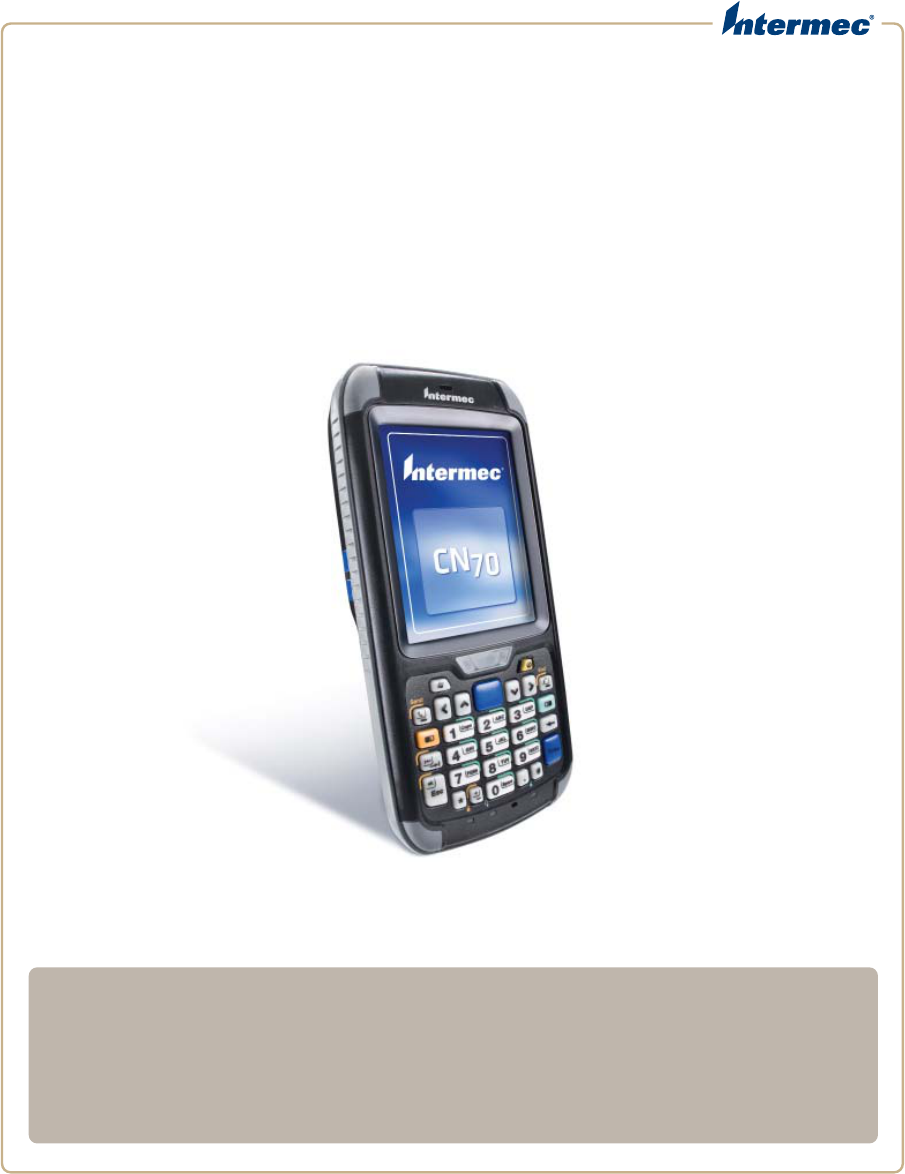
70 Series
Mobile Computer
CK70, CK71, CN70, CN70e
User’s Manual
ii 70 Series Mobile Computer User’s Manual
Intermec Technologies Corporation
Worldwide Headquarters
6001 36th Ave.W.
Everett, WA 98203
U.S.A.
www.intermec.com
The information contained herein is provided solely for the purpose of allowing customers to
operate and service Intermec-manufactured equipment and is not to be released, reproduced, or
used for any other purpose without written permission of Intermec Technologies Corporation.
Information and specifications contained in this document are subject to change without prior
notice and do not represent a commitment on the part of Intermec Technologies Corporation.
© 2010 by Intermec Technologies Corporation. All rights reserved.
The word Intermec, the Intermec logo, Norand, ArciTech, Beverage Routebook, CrossBar,
dcBrowser, Duratherm, EasyADC, EasyCoder, EasySet, Fingerprint, i-gistics, INCA (under license),
Intellitag, Intellitag Gen2, JANUS, LabelShop, MobileLAN, Picolink, Ready-to-Work, RoutePower,
Sabre, ScanPlus, ShopScan, Smart Mobile Computing, SmartSystems, TE 2000, Trakker Antares,
and Vista Powered are either trademarks or registered trademarks of Intermec Technologies
Corporation.
There are U.S. and foreign patents as well as U.S. and foreign patents pending.
Wi-Fi is a registered certification mark of the Wi-Fi Alliance.
Microsoft, Windows, and the Windows logo are registered trademarks of Microsoft Corporation
in the United States and/or other countries.
Bluetooth is a trademark of Bluetooth SIG, Inc., U.S.A.
This product includes software developed by the OpenSSL Project for use in the OpenSSL Toolkit
(www.openssl.org).
This product includes cryptographic software written by Eric Young (EAY@cryptsoft.com).
This product uses Regex++, Index software during its operational phases. The owner of Regex++
has granted use of the software to anyone provided such use is accompanied by the following
copyright and permission notice:
Regex++, Index. (Version 3.31, 16th Dec 2001)
Copyright © 1998-2001 Dr John Maddock
Permission to use, copy, modify, distribute and sell this software and its documentation for any
purpose is hereby granted without fee, provided that the above copyright notice appear in all
copies and that both that copyright notice and this permission notice appear in supporting
documentation. Dr John Maddock makes no representations about the suitability of this software
for any purpose. It is provided “as is” without express or implied warranty.
Contents
70 Series Mobile Computer User’s Manual iii
Contents
Before You Begin. . . . . . . . . . . . . . . . . . . . . . . . . . . . . . . . . . . . . . . . . . . . . . . . . . . . . . . . . . . . . . . . . ix
Safety Information . . . . . . . . . . . . . . . . . . . . . . . . . . . . . . . . . . . . . . . . . . . . . . . . . . . . . . . ix
Global Services and Support . . . . . . . . . . . . . . . . . . . . . . . . . . . . . . . . . . . . . . . . . . . . . . ix
Warranty Information. . . . . . . . . . . . . . . . . . . . . . . . . . . . . . . . . . . . . . . . . . . . ix
Web Support . . . . . . . . . . . . . . . . . . . . . . . . . . . . . . . . . . . . . . . . . . . . . . . . . . . . ix
Telephone Support . . . . . . . . . . . . . . . . . . . . . . . . . . . . . . . . . . . . . . . . . . . . . . . x
Service Location Support . . . . . . . . . . . . . . . . . . . . . . . . . . . . . . . . . . . . . . . . . . x
Who Should Read This Manual . . . . . . . . . . . . . . . . . . . . . . . . . . . . . . . . . . . . . . . . . . . . x
Related Documents . . . . . . . . . . . . . . . . . . . . . . . . . . . . . . . . . . . . . . . . . . . . . . . . . . . . . . xi
Patent Information . . . . . . . . . . . . . . . . . . . . . . . . . . . . . . . . . . . . . . . . . . . . . . . . . . . . . . xii
1Using the Computer . . . . . . . . . . . . . . . . . . . . . . . . . . . . . . . . . . . . . . . . . . . . . . . . . . . . . 1
About the 70 Series Mobile Computers . . . . . . . . . . . . . . . . . . . . . . . . . . . . . . . . . . . . . . . . . . . . . 2
Overview of 70 Series Features . . . . . . . . . . . . . . . . . . . . . . . . . . . . . . . . . . . . . . . . . . . . . 4
About the Status LEDs . . . . . . . . . . . . . . . . . . . . . . . . . . . . . . . . . . . . . . . . . . . . . . . . . . . . 5
70 Series Accessories . . . . . . . . . . . . . . . . . . . . . . . . . . . . . . . . . . . . . . . . . . . . . . . . . . . . . . . . . . . . . . 7
About the Battery . . . . . . . . . . . . . . . . . . . . . . . . . . . . . . . . . . . . . . . . . . . . . . . . . . . . . . . . . . . . . . . . . 8
Charging the Battery . . . . . . . . . . . . . . . . . . . . . . . . . . . . . . . . . . . . . . . . . . . . . . . . . . . . . .9
Changing the Battery. . . . . . . . . . . . . . . . . . . . . . . . . . . . . . . . . . . . . . . . . . . . . . . . . . . . . . 9
About Battery Status . . . . . . . . . . . . . . . . . . . . . . . . . . . . . . . . . . . . . . . . . . . . . . . . . . . . . 12
About Battery Life and Conservation . . . . . . . . . . . . . . . . . . . . . . . . . . . . . . . . . . . . . . 13
About the Keypad . . . . . . . . . . . . . . . . . . . . . . . . . . . . . . . . . . . . . . . . . . . . . . . . . . . . . . . . . . . . . . . .14
Entering Characters on the QWERTY Keypad . . . . . . . . . . . . . . . . . . . . . . . . . . . . . . 19
Entering Characters on the Numeric Keypad . . . . . . . . . . . . . . . . . . . . . . . . . . . . . . . 20
Entering Characters on the CK70 and CK71 Keypads . . . . . . . . . . . . . . . . . . . . . . . 21
About the Power Button . . . . . . . . . . . . . . . . . . . . . . . . . . . . . . . . . . . . . . . . . . . . . . . . . . 21
About the Intermec Dashboard Button . . . . . . . . . . . . . . . . . . . . . . . . . . . . . . . . . . . .23
Configuring the Screen Backlight . . . . . . . . . . . . . . . . . . . . . . . . . . . . . . . . . . . . . . . . . . . . . . . . .23
Adjusting the Volume . . . . . . . . . . . . . . . . . . . . . . . . . . . . . . . . . . . . . . . . . . . . . . . . . . . . . . . . . . . . 23
Reading Bar Codes . . . . . . . . . . . . . . . . . . . . . . . . . . . . . . . . . . . . . . . . . . . . . . . . . . . . . . . . . . . . . . . 24
Inserting a microSD Card. . . . . . . . . . . . . . . . . . . . . . . . . . . . . . . . . . . . . . . . . . . . . . . . . . . . . . . . . 26
Transferring Files To and From Your PC . . . . . . . . . . . . . . . . . . . . . . . . . . . . . . . . . . . . . . . . . . . 31
Contents
iv 70 Series Mobile Computer User’s Manual
2Understanding the User Interface and Intermec Applications. . . . . 33
About the User Interface. . . . . . . . . . . . . . . . . . . . . . . . . . . . . . . . . . . . . . . . . . . . . . . . . . . . . . . . . .34
About the Home Screen . . . . . . . . . . . . . . . . . . . . . . . . . . . . . . . . . . . . . . . . . . . . . . . . . . 34
Interacting With the Screen . . . . . . . . . . . . . . . . . . . . . . . . . . . . . . . . . . . . . . . . . . . . . . . 35
Title Bar Status Icons . . . . . . . . . . . . . . . . . . . . . . . . . . . . . . . . . . . . . . . . . . . . . . . . . . . . 36
Aligning the Screen . . . . . . . . . . . . . . . . . . . . . . . . . . . . . . . . . . . . . . . . . . . . . . . . . . . . . . 39
About Intermec Applications . . . . . . . . . . . . . . . . . . . . . . . . . . . . . . . . . . . . . . . . . . . . . . . . . . . . .39
Applications Available on the Mobile Computer . . . . . . . . . . . . . . . . . . . . . . . . . . . . 40
Applications You Can Download to the Mobile Computer. . . . . . . . . . . . . . . . . . . 41
3Using the Phone . . . . . . . . . . . . . . . . . . . . . . . . . . . . . . . . . . . . . . . . . . . . . . . . . . . . . . . . 45
About the Phone . . . . . . . . . . . . . . . . . . . . . . . . . . . . . . . . . . . . . . . . . . . . . . . . . . . . . . . . . . . . . . . . .46
Activating the UMTS Phone . . . . . . . . . . . . . . . . . . . . . . . . . . . . . . . . . . . . . . . . . . . . . . 46
Activating the CDMA Phone . . . . . . . . . . . . . . . . . . . . . . . . . . . . . . . . . . . . . . . . . . . . . . 48
Starting the Activation Wizard . . . . . . . . . . . . . . . . . . . . . . . . . . . . . . . . . . . . . . . . . . . . 49
Turning the Phone On and Off. . . . . . . . . . . . . . . . . . . . . . . . . . . . . . . . . . . . . . . . . . . . . . . . . . . .49
Making a Phone Call . . . . . . . . . . . . . . . . . . . . . . . . . . . . . . . . . . . . . . . . . . . . . . . . . . . . . . . . . . . . .50
Making an Emergency Phone Call . . . . . . . . . . . . . . . . . . . . . . . . . . . . . . . . . . . . . . . . . . . . . . . . .50
4Using the Camera. . . . . . . . . . . . . . . . . . . . . . . . . . . . . . . . . . . . . . . . . . . . . . . . . . . . . . . 51
About the Color Camera. . . . . . . . . . . . . . . . . . . . . . . . . . . . . . . . . . . . . . . . . . . . . . . . . . . . . . . . . . 52
Taking a Picture . . . . . . . . . . . . . . . . . . . . . . . . . . . . . . . . . . . . . . . . . . . . . . . . . . . . . . . . . 52
Recording a Video. . . . . . . . . . . . . . . . . . . . . . . . . . . . . . . . . . . . . . . . . . . . . . . . . . . . . . . .53
Saving Pictures and Videos to an SD Card. . . . . . . . . . . . . . . . . . . . . . . . . . . . . . . . . . . . . . . . . .53
5Using GPS . . . . . . . . . . . . . . . . . . . . . . . . . . . . . . . . . . . . . . . . . . . . . . . . . . . . . . . . . . . . . . . 55
About the Integrated GPS on Your Computer . . . . . . . . . . . . . . . . . . . . . . . . . . . . . . . . . . . . . . 56
Using the GPSID Installed on the Computer . . . . . . . . . . . . . . . . . . . . . . . . . . . . . . .56
Improving GPS Performance on the Computer . . . . . . . . . . . . . . . . . . . . . . . . . . . . .58
Contents
70 Series Mobile Computer User’s Manual v
6Configuring the Computer. . . . . . . . . . . . . . . . . . . . . . . . . . . . . . . . . . . . . . . . . . . . . 59
How to Configure the Computer . . . . . . . . . . . . . . . . . . . . . . . . . . . . . . . . . . . . . . . . . . . . . . . . . .60
Using Intermec Settings on the Computer . . . . . . . . . . . . . . . . . . . . . . . . . . . . . . . . . . . . . . . . . 60
Starting Intermec Settings . . . . . . . . . . . . . . . . . . . . . . . . . . . . . . . . . . . . . . . . . . . . . . . . 61
About the Structure of Intermec Settings . . . . . . . . . . . . . . . . . . . . . . . . . . . . . . . . . . 61
Navigating in Intermec Settings . . . . . . . . . . . . . . . . . . . . . . . . . . . . . . . . . . . . . . . . . . .65
Configuring ProfileSettings With Intermec Settings . . . . . . . . . . . . . . . . . . . . . . . .66
Restoring Default Settings. . . . . . . . . . . . . . . . . . . . . . . . . . . . . . . . . . . . . . . . . . . . . . . . 66
Hiding Menu Items in Intermec Settings . . . . . . . . . . . . . . . . . . . . . . . . . . . . . . . . . . .67
Using Intermec Settings Remotely With SmartSystems Foundation . . . . . . . . . . . . . . . . . . 67
About Network Communications . . . . . . . . . . . . . . . . . . . . . . . . . . . . . . . . . . . . . . . . . . . . . . . . .68
Configuring 802.11b/g Radio Communications . . . . . . . . . . . . . . . . . . . . . . . . . . . . 68
Configuring Ethernet Communications . . . . . . . . . . . . . . . . . . . . . . . . . . . . . . . . . . .69
Configuring Bluetooth Communications . . . . . . . . . . . . . . . . . . . . . . . . . . . . . . . . . . 69
About Serial and USB Communications . . . . . . . . . . . . . . . . . . . . . . . . . . . . . . . . . . . 73
Creating an ISP Connection . . . . . . . . . . . . . . . . . . . . . . . . . . . . . . . . . . . . . . . . . . . . . . 74
Creating a VPN Server Connection . . . . . . . . . . . . . . . . . . . . . . . . . . . . . . . . . . . . . . . .75
About Wireless Security . . . . . . . . . . . . . . . . . . . . . . . . . . . . . . . . . . . . . . . . . . . . . . . . . . . . . . . . . . 76
Choosing Between Microsoft and Funk Security . . . . . . . . . . . . . . . . . . . . . . . . . . . .77
Loading a Certificate . . . . . . . . . . . . . . . . . . . . . . . . . . . . . . . . . . . . . . . . . . . . . . . . . . . . .88
Disabling Security . . . . . . . . . . . . . . . . . . . . . . . . . . . . . . . . . . . . . . . . . . . . . . . . . . . . . . .90
7Managing the Computer . . . . . . . . . . . . . . . . . . . . . . . . . . . . . . . . . . . . . . . . . . . . . . . 91
Managing the Computer in Your Network . . . . . . . . . . . . . . . . . . . . . . . . . . . . . . . . . . . . . . . . .92
Managing the Computer Using SmartSystems. . . . . . . . . . . . . . . . . . . . . . . . . . . . . . 92
Managing the Computer Using Third-Party Software . . . . . . . . . . . . . . . . . . . . . . . 93
Developing and Installing Applications . . . . . . . . . . . . . . . . . . . . . . . . . . . . . . . . . . . . . . . . . . . .93
Packaging Your Application . . . . . . . . . . . . . . . . . . . . . . . . . . . . . . . . . . . . . . . . . . . . . .94
Choosing a Target Location. . . . . . . . . . . . . . . . . . . . . . . . . . . . . . . . . . . . . . . . . . . . . . . 94
Installing Applications Using SmartSystems Foundation Console. . . . . . . . . . . . 94
Installing Applications Using Microsoft ActiveSync . . . . . . . . . . . . . . . . . . . . . . . . . 95
Installing Applications Using a Storage Card . . . . . . . . . . . . . . . . . . . . . . . . . . . . . . .95
Installing Applications Using the FTP Server . . . . . . . . . . . . . . . . . . . . . . . . . . . . . . .96
Launching Applications Automatically . . . . . . . . . . . . . . . . . . . . . . . . . . . . . . . . . . . . 96
Contents
vi 70 Series Mobile Computer User’s Manual
Updating the System Software . . . . . . . . . . . . . . . . . . . . . . . . . . . . . . . . . . . . . . . . . . . . . . . . . . . .97
Updating Multiple Computers Using SmartSystems Console . . . . . . . . . . . . . . . . 98
Updating Individual Mobile Computers . . . . . . . . . . . . . . . . . . . . . . . . . . . . . . . . . . .99
8Troubleshooting and Maintaining the Computer . . . . . . . . . . . . . . . . . . 101
About the Intermec Dashboard . . . . . . . . . . . . . . . . . . . . . . . . . . . . . . . . . . . . . . . . . . . . . . . . . .102
Troubleshooting Your Mobile Computer. . . . . . . . . . . . . . . . . . . . . . . . . . . . . . . . . . . . . . . . . .103
Troubleshooting the Wi-Fi Connection . . . . . . . . . . . . . . . . . . . . . . . . . . . . . . . . . . .103
Troubleshooting 802.1x Security . . . . . . . . . . . . . . . . . . . . . . . . . . . . . . . . . . . . . . . . .104
Checking 802.11 Network Status . . . . . . . . . . . . . . . . . . . . . . . . . . . . . . . . . . . . . . . . .105
Troubleshooting Reading Bar Codes. . . . . . . . . . . . . . . . . . . . . . . . . . . . . . . . . . . . . .107
Troubleshooting Operating the Computer . . . . . . . . . . . . . . . . . . . . . . . . . . . . . . . .109
Calling Product Support. . . . . . . . . . . . . . . . . . . . . . . . . . . . . . . . . . . . . . . . . . . . . . . . . . . . . . . . .110
Finding Your Configuration Number. . . . . . . . . . . . . . . . . . . . . . . . . . . . . . . . . . . . .111
Finding Your Operating System Version . . . . . . . . . . . . . . . . . . . . . . . . . . . . . . . . . .111
Resetting the Computer . . . . . . . . . . . . . . . . . . . . . . . . . . . . . . . . . . . . . . . . . . . . . . . . . . . . . . . . .111
Rebooting the Computer . . . . . . . . . . . . . . . . . . . . . . . . . . . . . . . . . . . . . . . . . . . . . . . .111
Cold Booting the Computer . . . . . . . . . . . . . . . . . . . . . . . . . . . . . . . . . . . . . . . . . . . . .112
Clean Booting the Computer . . . . . . . . . . . . . . . . . . . . . . . . . . . . . . . . . . . . . . . . . . . .113
Cleaning the Computer. . . . . . . . . . . . . . . . . . . . . . . . . . . . . . . . . . . . . . . . . . . . . . . . . . . . . . . . . .114
ASpecifications and Default Settings . . . . . . . . . . . . . . . . . . . . . . . . . . . . . . . . . 115
Physical and Environmental Specifications. . . . . . . . . . . . . . . . . . . . . . . . . . . . . . . . . . . . . . . .116
CN70 Physical Dimensions . . . . . . . . . . . . . . . . . . . . . . . . . . . . . . . . . . . . . . . . . . . . . .116
CN70e Physical Dimensions . . . . . . . . . . . . . . . . . . . . . . . . . . . . . . . . . . . . . . . . . . . . .116
CK70 Physical Dimensions . . . . . . . . . . . . . . . . . . . . . . . . . . . . . . . . . . . . . . . . . . . . . .116
CK71 Physical Dimensions . . . . . . . . . . . . . . . . . . . . . . . . . . . . . . . . . . . . . . . . . . . . . .116
Environmental Specifications . . . . . . . . . . . . . . . . . . . . . . . . . . . . . . . . . . . . . . . . . . . .116
Power and Electrical Specifications . . . . . . . . . . . . . . . . . . . . . . . . . . . . . . . . . . . . . . .117
Operating System . . . . . . . . . . . . . . . . . . . . . . . . . . . . . . . . . . . . . . . . . . . . . . . . . . . . . . .117
Hardware . . . . . . . . . . . . . . . . . . . . . . . . . . . . . . . . . . . . . . . . . . . . . . . . . . . . . . . . . . . . . .117
Back Accessory Interface Pin-outs . . . . . . . . . . . . . . . . . . . . . . . . . . . . . . . . . . . . . . . .117
Touch Screen Specifications . . . . . . . . . . . . . . . . . . . . . . . . . . . . . . . . . . . . . . . . . . . . .118
Standard Communications . . . . . . . . . . . . . . . . . . . . . . . . . . . . . . . . . . . . . . . . . . . . . .118
Wireless LAN . . . . . . . . . . . . . . . . . . . . . . . . . . . . . . . . . . . . . . . . . . . . . . . . . . . . . . . . . . .118
Contents
70 Series Mobile Computer User’s Manual vii
Regulatory Approvals . . . . . . . . . . . . . . . . . . . . . . . . . . . . . . . . . . . . . . . . . . . . . . . . . . .118
Bar Code Symbologies. . . . . . . . . . . . . . . . . . . . . . . . . . . . . . . . . . . . . . . . . . . . . . . . . . .119
Imager Reading Distances . . . . . . . . . . . . . . . . . . . . . . . . . . . . . . . . . . . . . . . . . . . . . . .119
Default Configuration . . . . . . . . . . . . . . . . . . . . . . . . . . . . . . . . . . . . . . . . . . . . . . . . . . . . . . . . . .128
Data Collection . . . . . . . . . . . . . . . . . . . . . . . . . . . . . . . . . . . . . . . . . . . . . . . . . . . . . . . . .128
Symbology Option Settings. . . . . . . . . . . . . . . . . . . . . . . . . . . . . . . . . . . . . . . . . . . . . .129
Imager Settings . . . . . . . . . . . . . . . . . . . . . . . . . . . . . . . . . . . . . . . . . . . . . . . . . . . . . . . . .129
Decode Security Settings . . . . . . . . . . . . . . . . . . . . . . . . . . . . . . . . . . . . . . . . . . . . . . . .130
Communications . . . . . . . . . . . . . . . . . . . . . . . . . . . . . . . . . . . . . . . . . . . . . . . . . . . . . . .130
Device Settings . . . . . . . . . . . . . . . . . . . . . . . . . . . . . . . . . . . . . . . . . . . . . . . . . . . . . . . . .131
viii 70 Series Mobile Computer User’s Manual

Before You Begin
70 Series Mobile Computer User’s Manual ix
Before You Begin
This section provides you with safety information, technical support
information, and sources for additional product information.
Safety Information
Your safety is extremely important. Read and follow cautions in this
document before handling and operating Intermec equipment. You
can be seriously injured, and equipment and data can be damaged if
you do not follow the safety cautions.
This section explains how to identify and understand cautions and
notes that are in this document.
Global Services and Support
Warranty Information
To understand the warranty for your Intermec product, visit the
Intermec web site at www.intermec.com and click Support >
Returns and Repairs > Warranty.
Disclaimer of warranties: The sample code included in this document
is presented for reference only. The code does not necessarily
represent complete, tested programs. The code is provided “as is with
all faults.” All warranties are expressly disclaimed, including the
implied warranties of merchantability and fitness for a particular
purpose.
Web Support
Visit the Intermec web site at www.intermec.com to download our
current manuals (in PDF).
A caution alerts you to an operating procedure, practice,
condition, or statement that must be strictly observed to prevent
equipment damage or destruction, or corruption or loss of data.
Note: Notes either provide extra information about a topic or contain
special instructions for handling a particular condition or set of
circumstances.
Before You Begin
x 70 Series Mobile Computer User’s Manual
Visit the Intermec technical knowledge base (Knowledge Central) at
www.intermec.com and click Support > Knowledge Central to
review technical information or to request technical support for your
Intermec product.
Telephone Support
In the U.S.A. and Canada, call 1-800-755-5505.
Outside the U.S.A. and Canada, contact your local Intermec
representative. To search for your local representative, from the
Intermec web site, click About Us > Contact Us.
Service Location Support
For the most current listing of service locations, click Support
>Returns and Repairs > Repair Locations.
For technical support in South Korea, use the after service locations
listed below:
AWOO Systems
102-1304 SK Ventium
522 Dangjung-dong
Gunpo-si, Gyeonggi-do Korea, South 435-776
Contact: Mr. Sinbum Kang
Telephone: +82-31-436-1191
Email: mjyun@awoo.co.kr
IN Information System PTD LTD
6th Floor
Daegu Venture Center Bldg 95
Shinchun 3 Dong
Donggu, Daegu City, Korea
E-mail: jmyou@idif.co.kr or korlim@gw.idif.co.kr
Who Should Read This Manual
This manual is written for the person who is responsible for
installing, configuring, and maintaining the 70 Series Mobile
Computer.
This manual provides you with information about the features of the
70 Series mobile computer, and how to install, configure, operate,
maintain, and troubleshoot it.
Before You Begin
70 Series Mobile Computer User’s Manual xi
Before you work with the 70 Series mobile computer, you should be
familiar with your network and general networking terms, such as IP
address.
Related Documents
This is a list of related Intermec documents.
•Intermec Settings Command Reference Manual
•Intermec Developer Library (IDL) Resource Kit Developer’s Guide
The Intermec web site at www.intermec.com contains our
documents (as PDF files) that you can download for free.
To download documents
1Visit the Intermec web site at www.intermec.com.
2Click the Products tab.
3Using the Products menu, navigate to your product page. For
example, to find the CN50 computer product page, click
Computers > Handheld Computers > CN70.
4Click the Manuals tab.
If your product does not have its own product page, click Support >
Manuals. Use the Product Category field, the Product Family field,
and the Product field to help you locate the documentation for your
product.
Before You Begin
xii 70 Series Mobile Computer User’s Manual
Patent Information
Product is covered by one or more of the following patents:
4882476; 4894523; 4953113; 4961043; 4970379; 4988852; 5019699;
5021642; 5038024; 5081343; 5095197; 5144119; 5144121; 5182441;
5187355; 5187356; 5195183; 5216233; 5216550; 5195183; 5195183;
5218191; 5227614; 5233172; 5241488; 5243602; 5258606; 5278487;
5288985; 5308966; 5322991; 5331136; 5331580; 5342210; 5349678;
5359185; 5371858; 5373478; 5389770; 5397885; 5410141; 5414251;
5416463; 5442167; 5464972; 5468947; 5468950; 5477044; 5486689;
5488575; 5500516; 5502297; 5504367; 5508599; 5514858; 5530619;
5534684; 5536924; 5539191; 5541419; 5548108; 5550362; 5550364;
5565669; 5567925; 5568645; 5572007; 5576529; 5592512; 5594230;
5598007; 5608578; 5616909; 5619027; 5627360; 5640001; 5657317;
5659431; 5671436; 5672860; 5684290; 5719678; 5729003; 5742041;
5761219; 5764798; 5777308; 5777309; 5777310; 5786583; 5793604;
5798509; 5798513; 5804805; 5805807; 5811776; 5811777; 5818027;
5821523; 5828052; 5831819; 5834753; 5834749; 5837987; 5841121;
5842070; 5844222; 5854478; 5862267; 5869840; 5873070; 5877486;
5878395; 5883492; 5883493; 5886338; 5889386; 5892971; 5895906;
5898162; 5902987; 5902988; 5912452; 5923022; 5936224; 5949056;
5969321; 5969326; 5969328; 5979768; 5986435; 5987192; 5987499;
5992750; 6003775; 6012640; 6016960; 6018597; 6024289; 6034379;
6036093; 6039252; 6064763; 6075340; 6095422; 6097839; 6102289;
6102295; 6109528; 6119941; 6128414; 6138915; 6149061; 6149063;
6152370; 6155490; 6158661; 6164542; 6164545; 6173893; 6195053;
6234393; 6234395; 6244512; 6249008; 6328214; 6330975; 6345765;
6356949; 6367699; 6375075; 6375076; 6375344; 6431451; 6435411;
6484944; 6488209; 6497368; 6532152; 6538413; 6539422; 6621942;
6641046; 6681994; 6687403; 6688523; 6732930
There may be other U.S. and foreign patents pending.

1
1
Using the Computer
This chapter introduces the 70 Series Mobile Computers with
Windows® Mobile® 6.5. Use this chapter to learn about the
basic features and functions of the each computer, as well as
the available accessories for it.
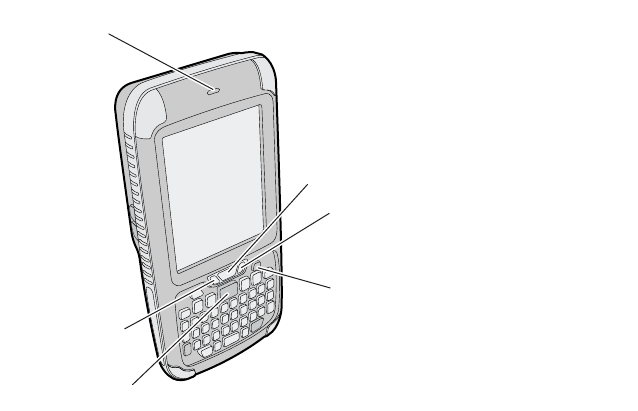
Chapter 1 — Using the Computer
2 70 Series Mobile Computer User’s Manual
About the 70 Series Mobile Computers
The ergonomically designed Intermec 70 Series Mobile Computers are
built on the Microsoft® Windows® Mobile 6.5 operating system. They
are lightweight, easy-to-use, and run most software developed for the
Windows Mobile platform, including standalone, client-server, and
browser-based applications.
The 70 Series family of computers consists of four different models:
the CN70, CN70e, CK70 and CK71. T he CN70 and CN70e have the
same features except that the CN70e offers extended environmental
specifications and a larger keypad for data-intensive applications. The
CK70 and CK71 have most of the same features, but the CK71 offers a
choice of imager options and does not offer phone support.
Throughout this manual, all versions of the mobile computer are
referred to as 70 Series unless information is specific to a particular
model of computer.
In most of the user’s manual, pictures of the CN70 and CK70 represent
the four models of the 70 Series computers.
CN70 Front View
Scan button
On/o button
Speaker
Notification LED
Good read LED
Battery status LED
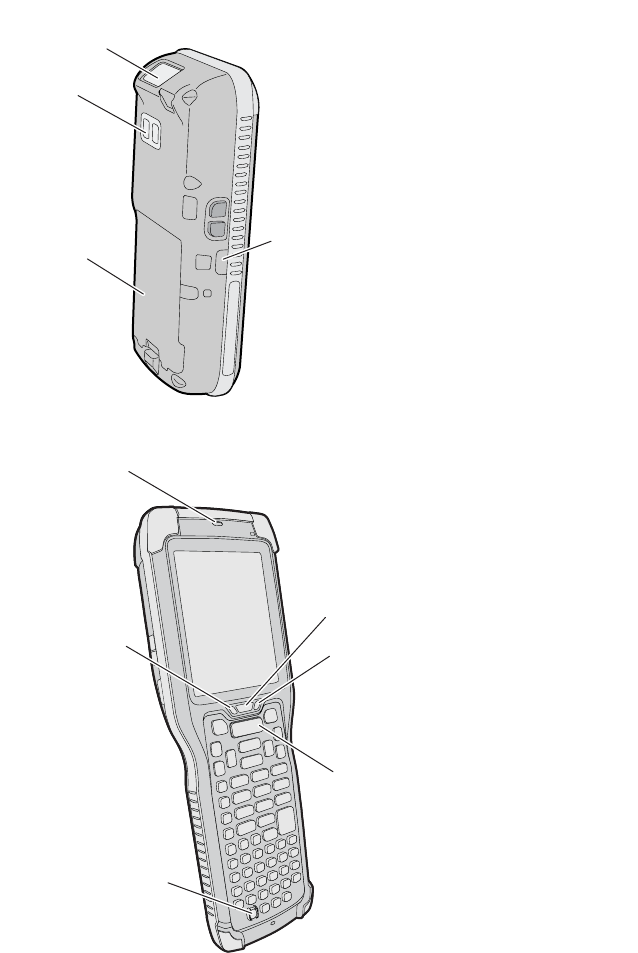
Chapter 1 — Using the Computer
70 Series Mobile Computer User’s Manual 3
CN70 Back View
CK70 Front View
Irda port
Imager
Camera
Battery
Scan button
On/o button
Speaker
Notification LED
Good read LED
Battery status LED
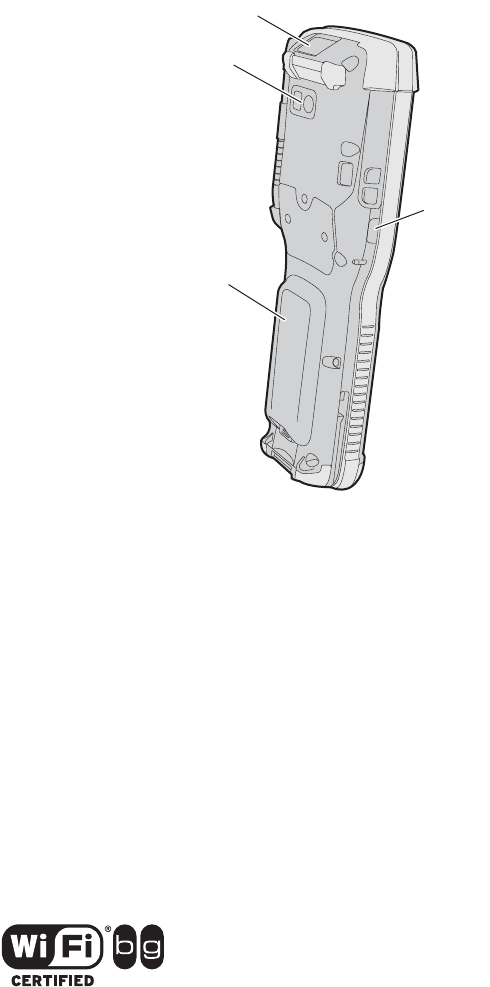
Chapter 1 — Using the Computer
4 70 Series Mobile Computer User’s Manual
CK70 Back View
Overview of 70 Series Features
The 70 Series includes these standard features:
•EA30 area imager that can read bar codes and capture signatures
•(CK71 only) Choice of EA30, EX25, or EV12 imagers
•Multi-processor architecture with 256 MB DRAM and 1G Flash
•CDMA or UMTS capability (not available on CK71)
•802.11a/b/g/n and Bluetooth® radios
•Embedded GPS radio
•5-megapixel color camera
•Customer-accessible microSD slot for memory cards up to 32 GB
•Customer-accessible SIM card slot
•IrDA port with speeds up to 4 MB/s
Imager
Camera
Irda port
Battery
The 70 Series Mobile Computers with an IEEE 802.11a/b/g/n radio
installed is Wi-Fi® certified for interoperability with other 802.11a/b/g/n
wireless LAN devices.
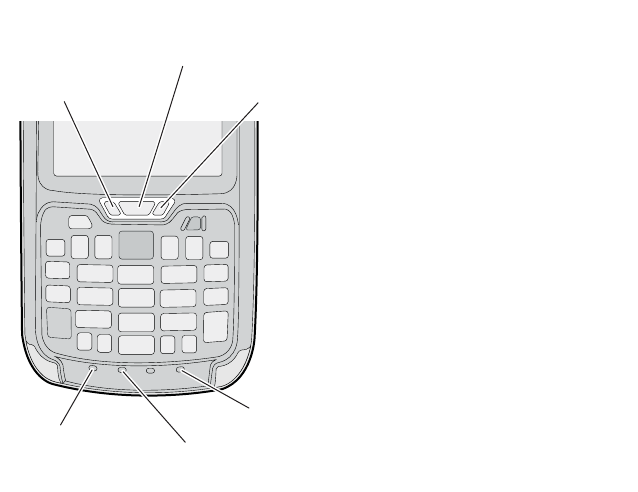
Chapter 1 — Using the Computer
70 Series Mobile Computer User’s Manual 5
About the Status LEDs
Use the following illustrations and table to understand the status
LEDs on your 70 Series computer. Not every 70 Series computer has all
six status LEDs. For example, the QWERTY versions of the CN70 and
CN70e do not have a Green key status LED.
Location of the CN70 Status LEDs
Green key
status LED
Shift key
status LED
Orange key
status LED
Battery status LED
Good Read and Ready-to-Work
Status LED
Notification LED
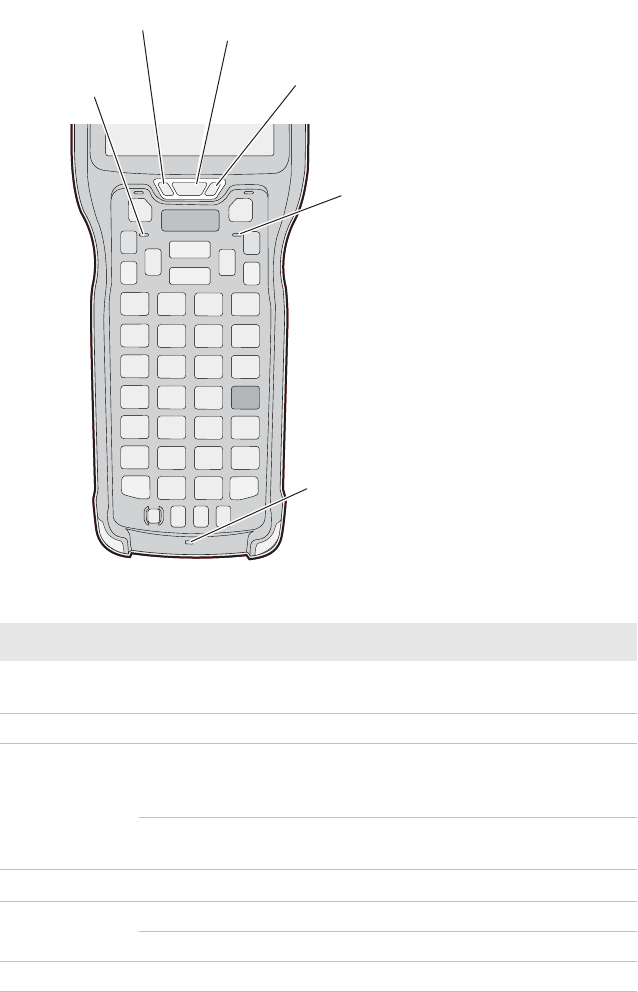
Chapter 1 — Using the Computer
6 70 Series Mobile Computer User’s Manual
Location of the CK70 Status LEDs
Status LED Descriptions
LED Color Description
Notification Amber The computer is notifying you of a pending
alarm or message.
Good Read Green The computer successfully decoded a bar code.
Ready-to-Work Blue Intermec Terminal Emulator (ITE) is running
and connected to the host or the computer is in
a healthy state.
Blinking
blue
ITE is running but not connected to the host or
your computer is in an unhealthy state.
Battery See “About Battery Status” on page 12.
Key Status Green The Green function key is enabled.
Orange The Orange function key is enabled.
Shift Red The Shift key is enabled.
Shift key
status LED
Green key
status LED
Orange key
status LED
Notification LED Good Read and Ready-to-Work
status LED
Battery status LED

Chapter 1 — Using the Computer
70 Series Mobile Computer User’s Manual 7
70 Series Accessories
The 70 Series computer ships with a battery. All other accessories are
sold and ordered separately. For help, contact your local Intermec sales
representative.
CN70 Accessories
Accessory Description
CN70/CN70e Battery (Model
1000AB01)
This battery provides main power to the
CN70 and CN70e.
CK70/CK71 Battery (Model
1001AB01)
This battery provides main power to
the CK70 and CK71.
Desktop Stand Use the desktop stand hold the 70 Series
computer on your desk or a stable
surface.
DEX/UCS Snap-On Adapter
(Model 1000AA04)
Use this adapter to receive and send
serial communications through a
DEX/UCS connection.
DX1 Desktop Dock Use the desktop dock with the:
•70 Series cup to charge the battery
while it is installed in the computer.
•70 Series battery cup to charge the
battery.
DX2 Dual Base and DX4 Quad
Base
Use these charger bases with the:
•70 Series cup to charge two or four
batteries while they are installed in the
computer.
•70 Series battery cup to charge two or
four batteries.
Ethernet Snap-On Adapter
(Model 1000AA01)
Use the Ethernet adapter to be able to
connect the computer to an Ethernet
network.
Handstrap Replacement Kit You can order and install a
replacement handstrap.
Holster Use the holster to store the computer
when you need your hands free.

Chapter 1 — Using the Computer
8 70 Series Mobile Computer User’s Manual
About the Battery
The 70 Series computer uses a battery pack as its main power source:
•Model 1000AB01 for the CN70 and CN70e
•Model 1001AB01 for the CK70 and CK71
Magstripe Reader Snap-On
Adapter (Model 1000AA06)
Use the magnetic stripe reader to be
able to read magnetic cards with the
computer.
RS-232 Snap-On Adapter
(Model 1000AA03)
Use the RS-232 adapter to convert the
connector on the bottom of the
computer to a serial connector.
Scan Handle Use the scan handle to provide better
ergonomics to the computer for
high-volume scanning applications.
Tethered Stylus Replacement
Kit
You can order and install a
replacement stylus.
USB Snap-On Adapter (Model
1000AA07)
Use this adapter to convert the
bottom connector of the computer to
a USB connector.
Vehicle Holder Use the vehicle holder to hold your
computer while you are using it in a
vehicle.
Vehicle Power Adapter (Models
9002AX01 and 9002AX02)
Use the vehicle power adapter to provide
power to the computer from your vehicle.
You can choose from a 3-pin or Hirose
style connector.
Vocollect Snap-On Adapter
(Model 1000AA05)
Use this adapter to be able to use the
Vocollect voice solution in your
warehouse.
Accessory Description
The battery used in this device may present a fire or chemical burn
hazard if it is mistreated. Do not disassemble it, heat it above
100°C (212°F) or incinerate it. Dispose of used batteries
promptly. Keep away from children.

Chapter 1 — Using the Computer
70 Series Mobile Computer User’s Manual 9
Charging the Battery
You need to fully charge the battery before using your computer for the
first time.
To charge the battery:
•Use one of the charging accessories listed in the next table.
70 Series Charging Accessories
Changing the Battery
If your battery power is low, you need to either charge the battery in the
computer, or replace it with a charged battery.
To change the battery:
1Save your files and close any open applications.
2Press the Power button to suspend the computer.
3Disconnect the handstrap from the computer.
Note: If the computer is not using external power and you remove the
battery pack, the computer goes into a power off state and then cold
boots.
Charging Accessory Charging Time
Snap-on adapters 4 hours
DX1 desktop dock and computer cup 6 hours
DX1 desktop dock and battery cup 6 hours
DX2 or DX4 base and computer cup 6 hours
DX2 or DX4 base and battery cup 6 hours
CN70, CN70e, CK70, and CK71 Vehicle Power Adapter ?? hours
Note: The computer resets when you remove the battery.
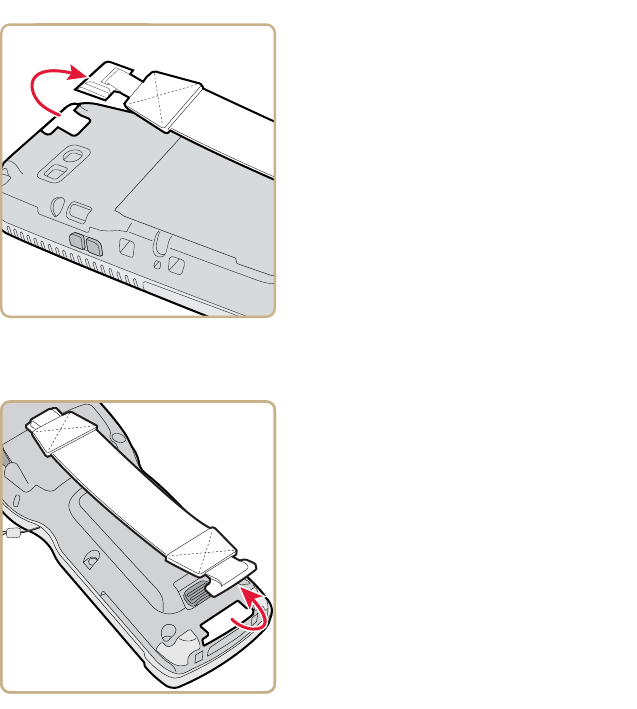
Chapter 1 — Using the Computer
10 70 Series Mobile Computer User’s Manual
Removing the Handstrap From a CN70 or CN70e
Removing the Handstrap From a CK70 or CK71
4Remove the battery.
•On the CN70 or CN70e, push the battery release toward the
bottom of the computer until the battery releases and then lift
it away from the computer.
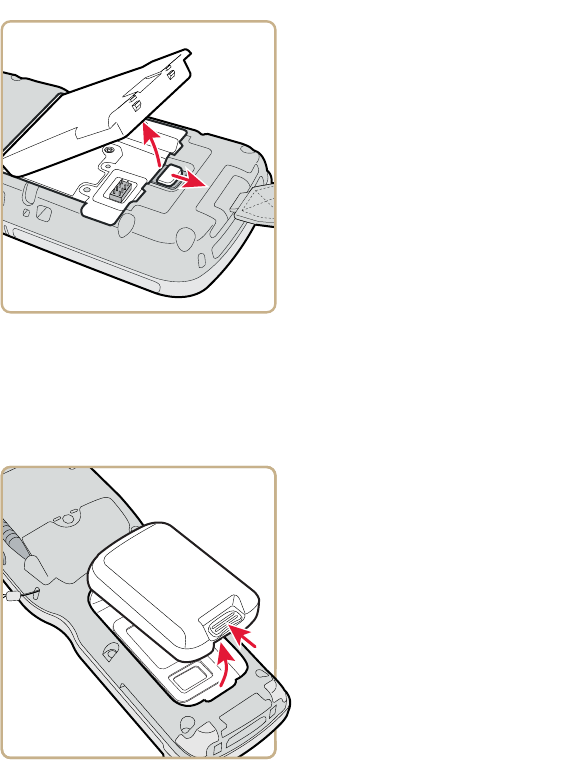
Chapter 1 — Using the Computer
70 Series Mobile Computer User’s Manual 11
•On the CK70 or CK71, push the battery release toward the top
of the computer until the battery releases and then lift it away
from the computer.
5Insert the top end of a fully charged battery into the computer, and
press down firmly on the bottom of the battery. Make sure that the
battery release tab is fully engaged.
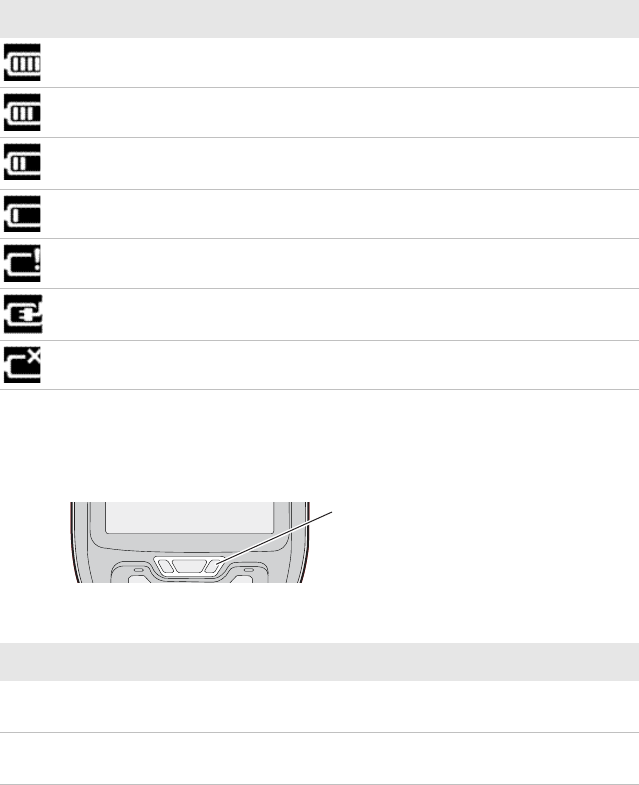
Chapter 1 — Using the Computer
12 70 Series Mobile Computer User’s Manual
About Battery Status
Use the battery icon on the Title bar to see the power status of your
battery. If you want more detailed information on your battery such as
usage time or voltage, use the Intermec Dashboard. For more
information on the Dashboard, see “About the Intermec
Dashboard” on page 102.
Understanding the Battery Icon Status
You can also use the battery status LED to see the charging status of
your battery.
Location of the Battery Status LED
Understanding the Battery Status LED
Battery Icon Status
Battery is fully charged.
Battery has a high charge.
Battery has a medium charge. You should be able to work for
several more hours before changing batteries.
Battery is low. You need to charge or replace the battery soon.
Battery is critically low. You need to replace the battery now.
Battery is charging.
The battery is not installed.
LED State Description
Steady green The computer is connected to a charger and the battery is
more than 95% charged.
Blinking red The battery is low. The computer goes into Suspend mode.
Charge or replace the battery.
Battery status LED

Chapter 1 — Using the Computer
70 Series Mobile Computer User’s Manual 13
About Battery Life and Conservation
Batteries that are stored outside the computer for long periods of time
slowly discharge. Intermec recommends storing the battery in a
charger to maintain battery performance.
Battery Conservation Tips
Steady red The computer is connected to a charger and the battery is
charging.
Steady amber There is a battery error. The battery may be outside the
allowable charging temperature or you may need to replace it.
Off The computer is not on external power and the battery is
operating normally.
LED State Description
When You Want To: Do This to Save Battery Power:
Use the computer and the Low
Battery status icon appears or the
Battery light comes on.
•Connect the computer to an
external power source.
•Or, save your data and press the
Power button. After the computer
turns off, remove the battery and
insert a fully charged battery.
Stop using the computer for 5
minutes or longer.
Make sure that the low battery icon is not
on the screen and the Battery LED is not
on. Press and hold the Power button for
about 2 seconds to suspend the
computer.
Store the computer for more than
a day.
If you are storing the computer for a few
days, like over the weekend, install a
charged battery or connect the computer
to a power source.
If you are storing the computer for longer,
remove and charge the battery, and then
store both the battery and computer in a
cool location. If you store the battery for
several months, recharge the battery to
keep it at peak performance.
Store the battery outside the
computer.
Store the batteries in a charger.
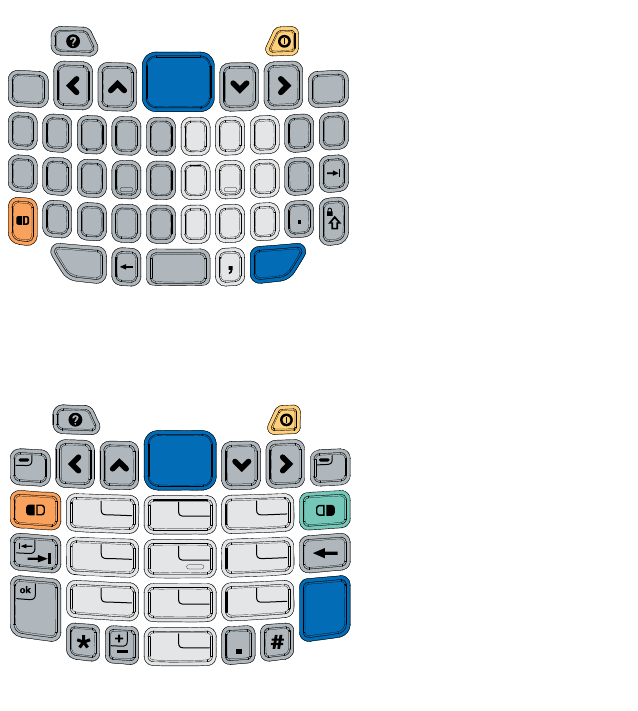
Chapter 1 — Using the Computer
14 70 Series Mobile Computer User’s Manual
About the Keypad
The CN70 comes with either a QWERTY keypad or a numeric keypad.
The CN70e comes with either a QWERTY numeric keypad or numeric
function keypad. The keypad on the CN70 computers is
light-sensitive. In low light conditions, the keypad automatically lights
up.
CN70 QWERTY Keypad
CN70 Numeric Keypad
Space
F
D
S
A
GHJKL
C
X
ZVBN
M
Esc
Enter
R
E
Q
W
TYIOP
U
123
456
78
0
9
Caps
ABC
DEF
GHI
JKL
MNO
PQRS
TUV
Space
WXYZ
Esc Enter
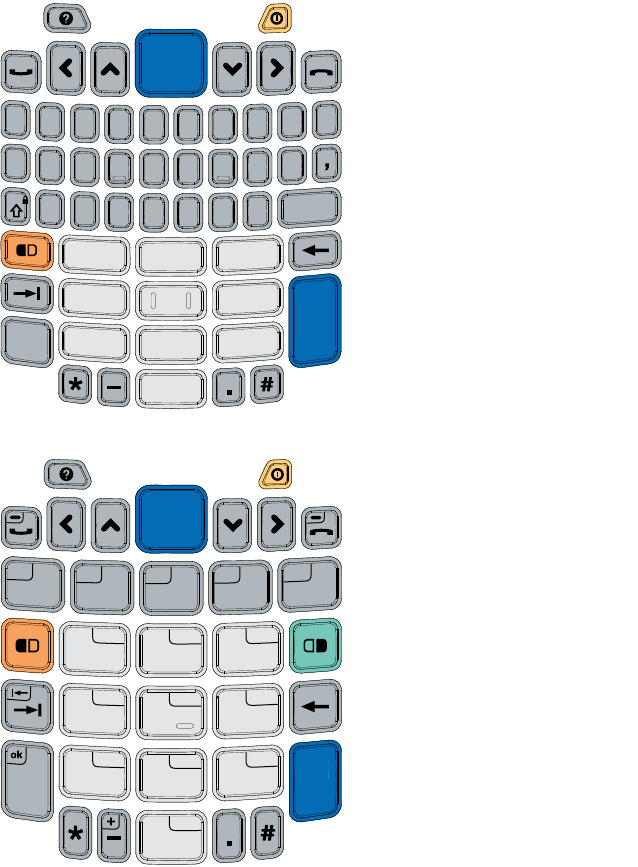
Chapter 1 — Using the Computer
70 Series Mobile Computer User’s Manual 15
CN70e QWERTY Numeric Keypad
CN70e Numeric Function Keypad
E
N
T
E
R
123
456
78
0
9
Esc
Space
F
D
S
A
GHJKL
R
E
QTY IOP
U
C
X
ZVBN
M
W
1
4
7
3
6
9
Caps
ABC
DEF
GHI
JKL
MNO
PQRS
TUV
Space
WXYZ
F1 F2 F3 F4 F5
Esc
E
N
T
E
R
2
5
8
0
F6 F7 F8 F9 F10
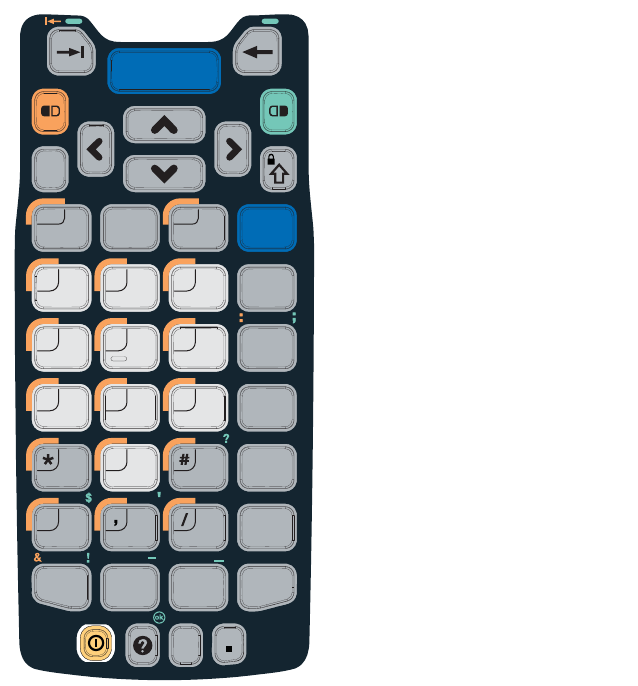
Chapter 1 — Using the Computer
16 70 Series Mobile Computer User’s Manual
The CK70 comes with either an alpha keypad or an alphanumeric
keypad. The CK71 comes with either a numeric function keypad or an
alphanumeric keypad. The keypad on the computers is light-sensitive.
In low light conditions, the keypad automatically lights up.
CK70 Alpha Keypad
Esc
Ctrl
YZ
Enter
Space
AB C
D
H
L
PR
STUV
WX
EF
GI
KM
OQ
0
123
456
789
J
N
@
Send End
Delete
Insert
\
[]
+=
F1 F2 F3
F4
F8
F5 F6
F7 F9
F10
><
%()
sym
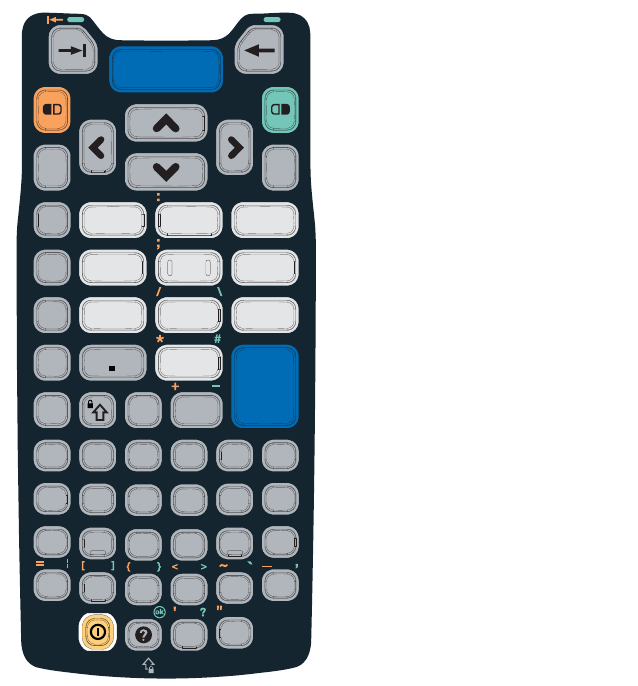
Chapter 1 — Using the Computer
70 Series Mobile Computer User’s Manual 17
CK70 Alphanumeric Keypad
0
564
897
312
F1
F2
F3
F4
F5 Ctrl Space
Enter
Esc
Alt
AEF
GHIJ
KL
MNOPQR
STUV
WX
YZ
BCD
EndSend
F13 F14F11 F12 F15 F16
F19 F20
F17 F18
F23 F24
F21 F22
F6
F7
F8
F9
F10
DeleteInsert
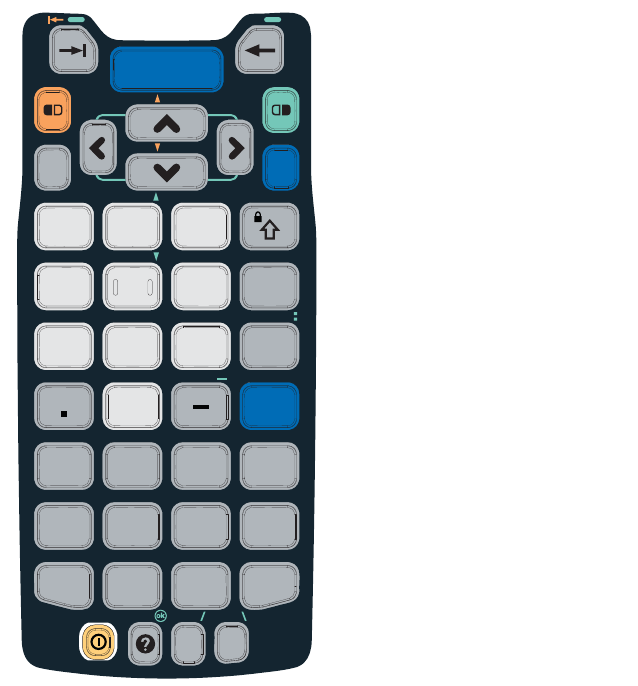
Chapter 1 — Using the Computer
18 70 Series Mobile Computer User’s Manual
CK71 Numeric Function Keypad
Ctrl
0
564
897
312
Enter
Enter
F1 F2 F3 F4
F5 F6 F7 F8
F9 F10 F11 F12
Esc
Fld
Exit
Space
Alt
Delete
F13 F14 F15 F16
F17 F18 F19 F20
F21 F22
Return
Return
NxtScrPrvScr Roll
SysRq
Fld+Fld-
Home
Roll Reset
Clear
Attn
Insert
AB C
DEF
GHI
MN O
PQRS
TU
Y
VW
X
JK
L
Z
View
View
F24F23
PA3PA2PA1
Pa
g
e
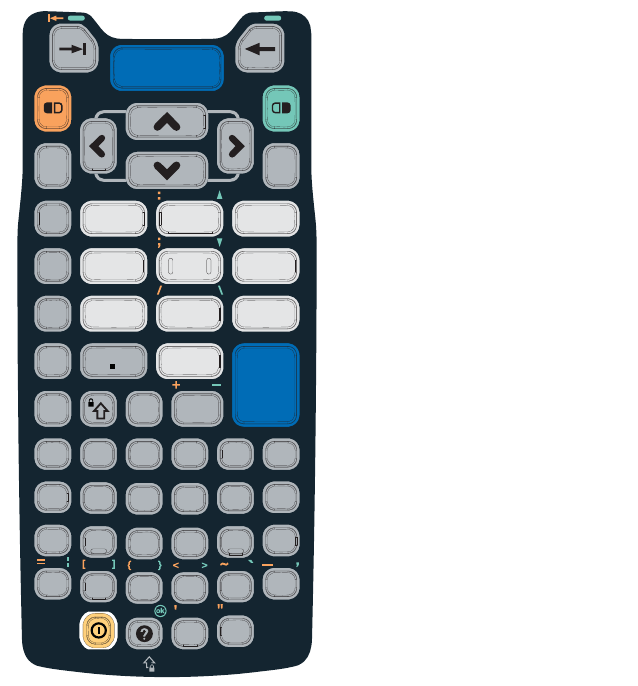
Chapter 1 — Using the Computer
70 Series Mobile Computer User’s Manual 19
CK71 Alphanumeric Keypad
Entering Characters on the QWERTY Keypad
You need to use the orange modifier key b and the Shift key y to
access all characters and functions on the QWERTY keypad.
To type a character:
•Press the key for that character.
To type a character or access a function on the overlay:
•Press b and then press the key for the character or function.
Fld
Exit
0
564
897
312
F1
F2
F3
F4
F5 Ctrl Space
Enter
Esc
AEF
GHIJ
KL
MNOPQR
STUV
WX
YZ
BCD
F13 F14F11 F12 F15 F16
F19 F20
F17 F18
F23 F24
F21 F22
Return
NxtScr
Alt
PrvScr Roll
Fld+Fld-
Roll Clear
Reset
Erase FindDupAttn
EEOF
Autolog
Keypd
Hex
Home
FldMk
Remove
Print
Select
Mode
NewLn
Menu
?
SysRq
PA1
PA2
PA3
F6
F7
F8
F9
F10
Delete
Hel
p
Insert
View Pa
g
e
Chapter 1 — Using the Computer
20 70 Series Mobile Computer User’s Manual
To only type characters or access functions on the overlay:
•Press b twice to lock the orange modifier key to stay on, and then
press the keys for the characters or functions.
To type a single uppercase letter:
•Press y and then the letter key.
To type all uppercase letters:
Press yy to turn on Caps Lock, and then press the letter keys.
You can still type orange modifier characters by pressing b and then
the key for that character.
To turn off Caps Lock, press y.
Entering Characters on the Numeric Keypad
You need to use the orange modifier key b and the green modifier key
c to access all characters and functions on the Numeric keypad.
To type a character or access a function printed in orange on the
overlay:
•Press b and then press the key for the character or function.
To type a character or access a function printed in green on the overlay:
•Press c and then press the key for the character or function.
To type letters in the upper right corner of a key:
•Press c and then press the key one to three times depending on the
position of the letter.
For example, in the upper right corner of the 2 key there are the
letters “ABC”:
•To type “c”, press c 2 2 2.
•To type “C,” press c 1 and then press c 2 2 2.
To only type letters:
•Press c c to lock the green modifier key, and then press the key
one to four times depending on the position of the letter.
While the green modifier key is locked, press 1 to toggle between only
uppercase and lowercase letters.
To unlock the green modifier key, press c.

Chapter 1 — Using the Computer
70 Series Mobile Computer User’s Manual 21
Entering Characters on the CK70 and CK71 Keypads
You need to use the orange modifier key b, the green modifier key c,
and the Shift or Caps Lock key y to access all characters and functions
on the Alpha, Alphanumeric, and Numeric Function keypads.
To type a character or access a function printed in orange on the
overlay or in the upper left corner of a key:
•Press b and then press the key for the character or function.
To type a character or access a function printed in green on the overlay:
•Press c and then press the key for the character or function.
To type a single uppercase letter:
•Press y and then the letter key.
To type all uppercase letters:
Press yy to turn on Caps Lock, and then press the letter keys.
You can still type orange or green modifier characters by pressing b or
c and then the key for that character.
To turn off Caps Lock, press y.
About the Power Button
When you press the Power button, a dialog appears asking how you
want the button to function in the future. If you accept the default
settings by doing nothing, the computer will suspend (phone is on).
Note: If uppercase letters are enabled and you unlock the green
modifier key, you may need to press c 1 to type lowercase letters.
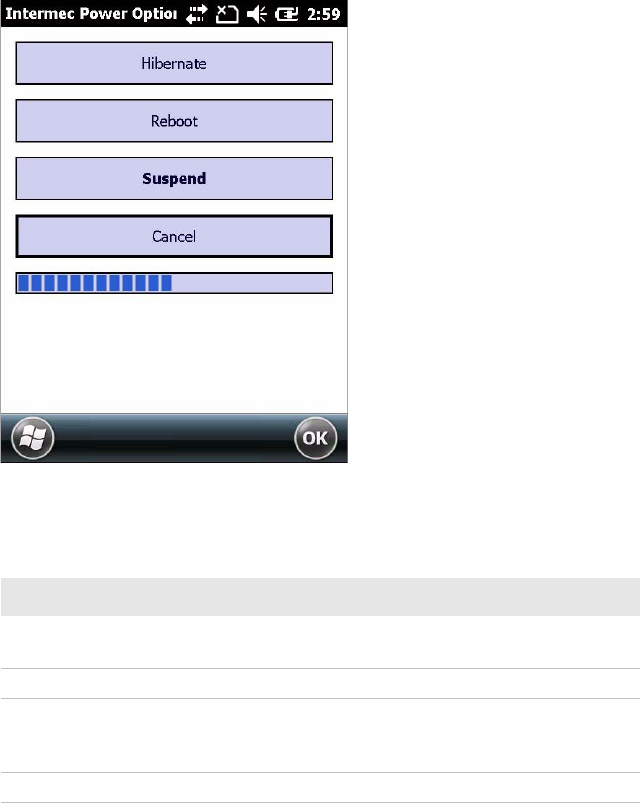
Chapter 1 — Using the Computer
22 70 Series Mobile Computer User’s Manual
The Power Button Options Screen
Use the following table to understand the Intermec Power Options.
Intermec Power Options
The Intermec Power Options screen is customizable. You can use
Intermec Settings to determine which options are available to end
users, the timeout until the default choice is selected, or to disable the
the Power Options screen. For more information on customizing the
screen using Intermec Settings, see “Using Intermec Settings on the
Computer” on page 60 or see the Intermec Settings Command
Reference Manual.
Option Description
Hibernate The computer powers off all radios and internal devices not
involved in saving the system state.
Reboot The computer shuts down and restarts.
Suspend The computer powers off all radios and internal devices not
involved in saving the system state, but the phone stays on to
receive calls (default).
Cancel The Power Options selection is cancelled.
Chapter 1 — Using the Computer
70 Series Mobile Computer User’s Manual 23
About the Intermec Dashboard Button
If the Ready-to-Work light blinks, your computer may be experiencing
a problem. Press the Intermec Dashboard button (m) to launch the
Intermec Dashboard application to see troubleshooting and status
information.
For more information on Intermec Dashboard, see “About the
Intermec Dashboard” on page 102.
Configuring the Screen Backlight
You can turn on the backlight to see the screen better, or you can turn
off the backlight to help conserve battery power.
By default, the computer goes into Screen Off mode when there is no
activity. Screen Off mode turns off the backlight and display. Press a
key or tap the screen to resume activity.
To configure the backlight:
1Tap the battery icon at the top of the screen, and then tap the
battery icon on the horizontal scroll menu.
2With Turn off backlight if device is not used for checked, select
the timeout value (30 seconds, or 1 to 5 minutes).
Adjusting the Volume
You can adjust the computer volume for your needs and your
environment. The volume includes sounds you hear when you tap the
screen or read bar codes with the imager. You can set the volume to off,
very low, low, medium, high, very high (default), or vibrate.
To adjust the volume:
1Tap the Volume icon at the top of the screen, and then tap the
volume icon on the horizontal scroll menu.
2Use your stylus or the u and d keys to adjust the volume slider to
the volume you want, select Vibrate, or select Off.

Chapter 1 — Using the Computer
24 70 Series Mobile Computer User’s Manual
You can also use the buttons on the right side of the computer to
adjust the volume:
•The upper button increases the volume.
•The lower button decreases the volume.
Reading Bar Codes
The 70 Series computer ships with an internal imager. Depending on
the imager model in your computer, you can read 1D and 2D bar code
symbologies, composite symbologies, and postal codes.
You also connect the 70 Series computer to:
•cordless scanners, such as the SF51 and SR61 through Bluetooth
communications. For help, see “Connecting to a Bluetooth
Scanner” on page 70.
•tethered scanners, such as the SR30, SR60, and SR61T through the
RS-232 adapter (Model 1000AA03).
To read a bar code:
1Enable only the bar code symbologies that you need.
2Use Intermec Settings to choose the predefined imager mode that
best suits your environment:
Note: When the Pictures & Videos application is running, you cannot
use the imager.
Predefined Mode For Scanning
1D Only 1D labels.
1D and 2D Standard (Default) All types of bar code labels.
1D and 2D Bright Environment In high ambient light, such as outdoors in
the sunshine.
1D and 2D Reflective Surface Glossy labels.
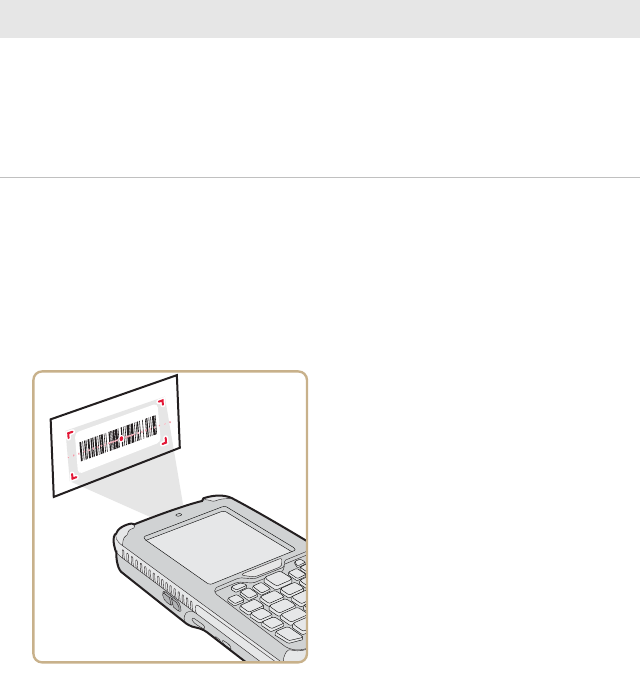
Chapter 1 — Using the Computer
70 Series Mobile Computer User’s Manual 25
3Point the imager window at the bar code label, and hold the
computer steady a few inches from the label.
4Press the Scan button. The laser pointer and illumination beam or
frame appear.
Scanning With the EA30 Imager
5Use the laser pointer as a guide and aim toward the middle of the
bar code. Make sure that the illumination beam or frame covers the
bar code you are trying to decode.
When the computer successfully reads a bar code label, you hear a
high beep, and the Good Read LED turns on briefly.
6Release the Scan button.
Custom In conditions that require customized
settings. For complete information about
these settings, commands, and
parameters, see the
Intermec Settings Command Reference
Manual.
Predefined Mode For Scanning
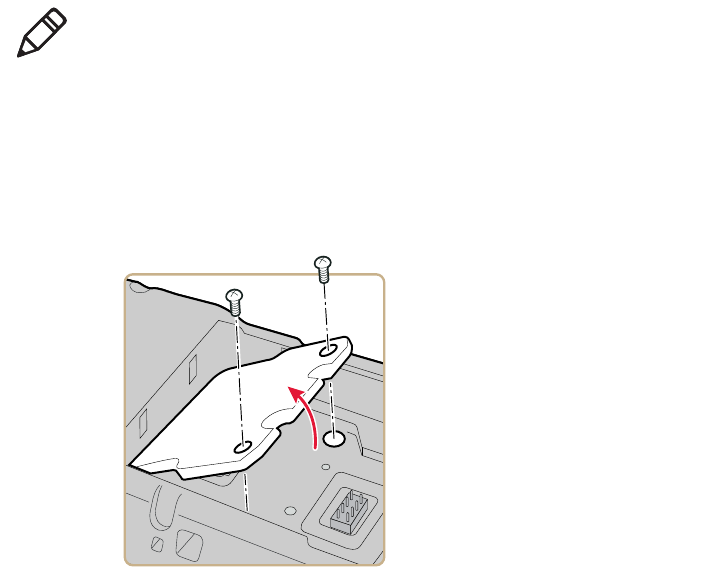
Chapter 1 — Using the Computer
26 70 Series Mobile Computer User’s Manual
Inserting a microSD Card
You can use a microSD™ card to increase file storage and install
software. The 70 Series computers support an optional 32 GB
maximum capacity microSD card.
To install a microSD card on a CN70 or CN70e:
1Press the Power button to turn off the computer.
2Remove the battery.
3Remove the two Phillips screws and open the card access door.
Note: The computer resets when you remove the battery.
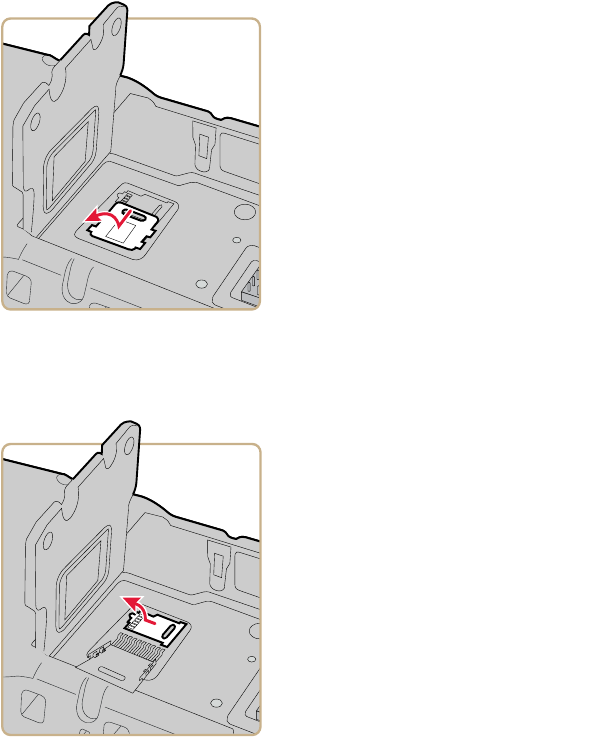
Chapter 1 — Using the Computer
70 Series Mobile Computer User’s Manual 27
4Slide the SIM card door to the left to unlock it and open the door.
5Slide the microSD card door towards the top of the computer to
unlock it and open the door.
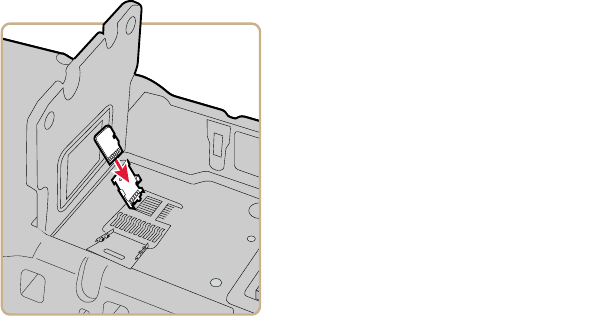
Chapter 1 — Using the Computer
28 70 Series Mobile Computer User’s Manual
6Slide the microSD card into place.
7Close the microSD card door and slide it towards the bottom of the
computer to lock it in place.
8Close the SIM card door and slide it to the right to lock it in place.
9Close the card access door and replace the two screws.
10 Install the battery. Press down firmly on the bottom of the battery,
and make sure that the battery release tab is fully engaged.
11 Press the Power button. The computer cold boots.
To install a microSD card on a CK70 or CK71:
1Press the Power button to turn off the computer.
2Remove the two screws that attach the interface adapter cover to
the back of the computer.
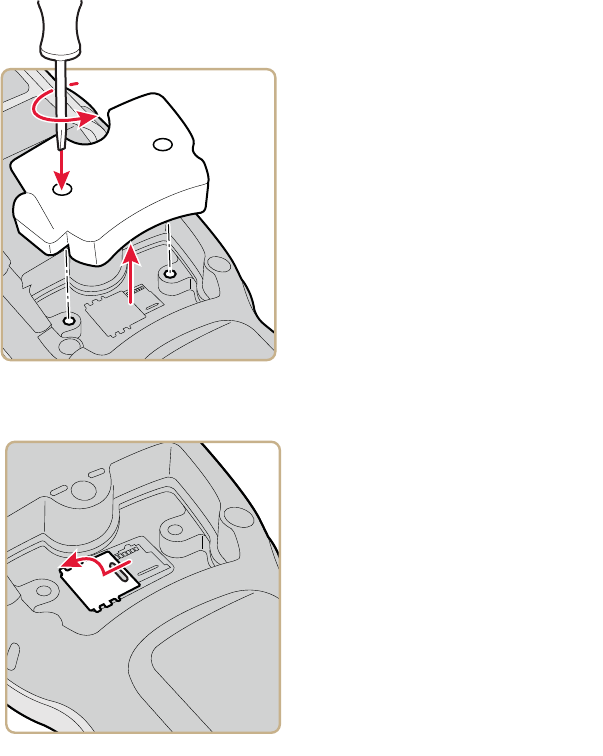
Chapter 1 — Using the Computer
70 Series Mobile Computer User’s Manual 29
3Slide the SIM card door to the left to unlock it and open the door.
4Slide the microSD card door towards the top of the computer to
unlock it and open the door.
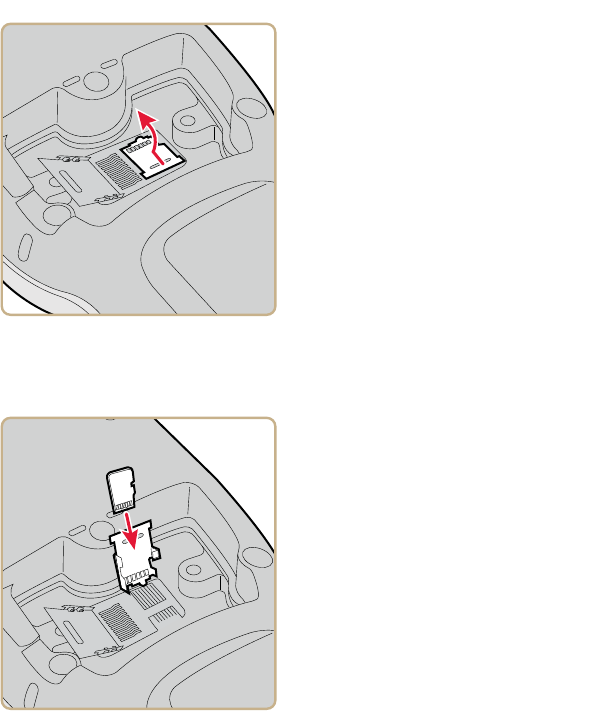
Chapter 1 — Using the Computer
30 70 Series Mobile Computer User’s Manual
5Slide the microSD card into place.
6Close the microSD card door and slide it towards the bottom of the
computer to lock it in place.
7Close the SIM card door and slide it to the right to lock it in place.
8Replace the interface adapter cover and attach with the two screws
removed in Step 2.
9Install the battery. Press down firmly on the bottom of the battery,
and make sure that the battery release tab is fully engaged.
10 Press the Power button. The computer cold boots.
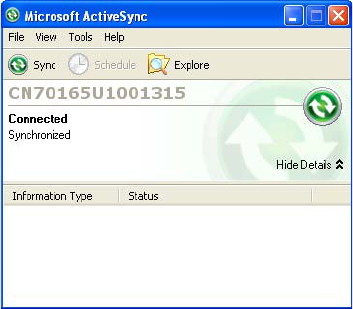
Chapter 1 — Using the Computer
70 Series Mobile Computer User’s Manual 31
Transferring Files To and From Your PC
You can use Microsoft ActiveSync (Windows XP or earlier) or Windows
Mobile Device Center (Windows Vista or Windows 7) to establish a
connection between your computer and a PC. After you connect to
your PC, you can transfer files, synchronize files, remotely debug, and
perform other device management activities. ActiveSync and Windows
Mobile Device Center are a free applications available from the
Microsoft web site at www.windowsmobile.com/getstarted.
To establish an ActiveSync partnership between your computer and a
PC, you need to physically connect your computer to your PC using
these accessories:
•USB snap-on adapter (Model 1000AA07)
•USB cable
To transfer files to and from your PC:
1Download ActiveSync from the Microsoft web site and install
ActiveSync on your PC.
2Follow the onscreen instructions to establish a partnership. When
the partnership is established, the Microsoft ActiveSync screen
appears on your PC.
Chapter 1 — Using the Computer
32 70 Series Mobile Computer User’s Manual

33
2
Understanding the User Interface and
Intermec Applications
Use this chapter to learn about the Windows® Mobile® 6.5
user interface and how to interact with the screen. You can also
use this chapter to learn about the Intermec applications on
your computer, as well as additional Intermec applications you
can download.
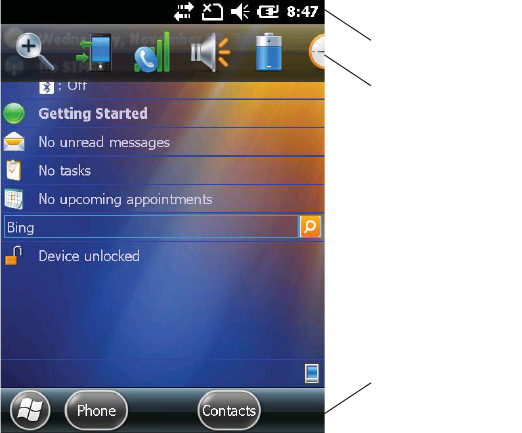
Chapter 2 — Understanding the User Interface and Intermec Applications
34 70 Series Mobile Computer User’s Manual
About the User Interface
The user interface for the Microsoft® Windows® Mobile 6.5 operating
system is different from previous versions of Windows. The interface is
touch-friendly and easier to navigate. Use the following sections to
understand how to interact with Windows Mobile 6.5.
About the Home Screen
When you turn on your mobile computer, the Home screen is the first
screen that appears. The Home screen contains three navigation bars:
the Title bar, the horizontal scroll bar, and the Tile bar.
The Windows Mobile 6.5 Home Screen
Use the Title bar icons to view the current status of information such
as signal strength and battery power remaining. For more information
on the Title bar icons, see “Title Bar Status Icons” on the next page.
A horizontal scroll bar appears when you tap an icon in the Title bar.
This horizontal scroll bar makes it easy to access the applications
associated with the Tile bar icons. The horizontal scroll bar also
contains a magnifier which improves the touch experience by making
parts of the screen large enough to access with your finger.
Horizontal scroll bar
Title bar
Tile bar
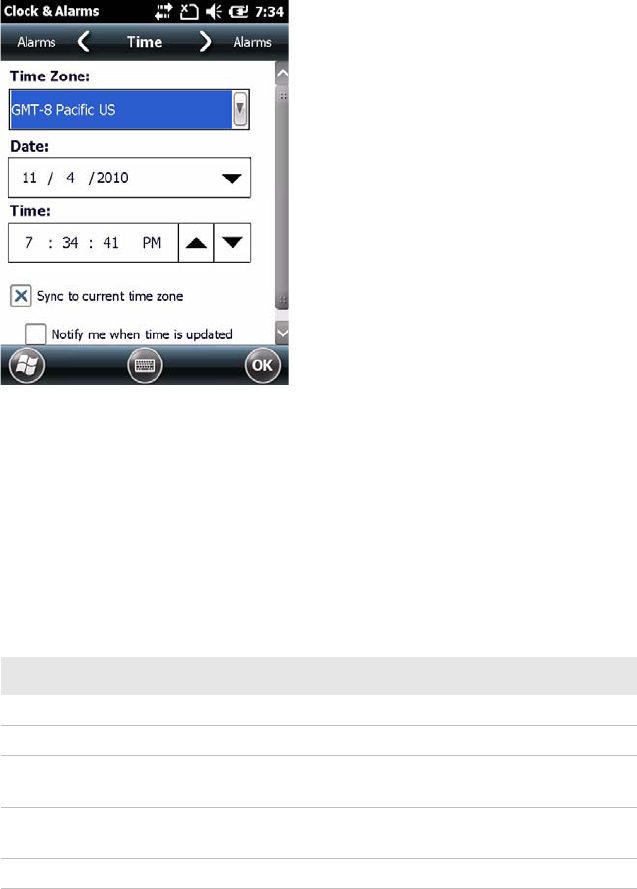
Chapter 2 — Understanding the User Interface and Intermec Applications
70 Series Mobile Computer User’s Manual 35
The horizontal scroll bar also replaces tabs within Windows screens
and allows for easier navigation.
Clock & Alarms Screen With Horizontal Scroll Bar
Use the Tile bar to navigate between screens and within applications.
The icons available on the Tile bar change depending on the
application you are using.
Interacting With the Screen
The Windows Mobile 6.5 interface supports the use of gestures with
the finger or stylus to move around the screen. The table below
explains the supported gestures.
Gesture Description
Tap Represents the left click of a mouse.
Double Tap Represents the left double-click of a mouse.
Hold Represents the right click of a mouse when you press and hold
on the screen and a context menu appears.
Flick Initiates scrolling in the direction (horizontal or vertical) the
fingeror stylus moves across the screen.
Pan Press and hold on the screen and then drag in any direction.

Chapter 2 — Understanding the User Interface and Intermec Applications
36 70 Series Mobile Computer User’s Manual
Title Bar Status Icons
Clickable icons in the Title bar immediately show you the status of
your network, your phone, the volume, the battery, and the time. Use
the following table to understand what the icons mean.
Title Bar Status Icon Descriptions
Icon Description
You have a new notification.
You have a new text message.
You have a new e-mail message.
You have a new instant message.
You missed a call.
The speakerphone is on.
The phone is roaming.
An alarm it set.
The microphone is on.
An internet call is in progress.
A Bluetooth headset is detected.
An ActiveSync connection has been established.
There was a problem with the ActiveSync synchronization.
An ActiveSync synchronization is in progress over USB.
A UMTS network is available.
Connecting to a UMTS network.
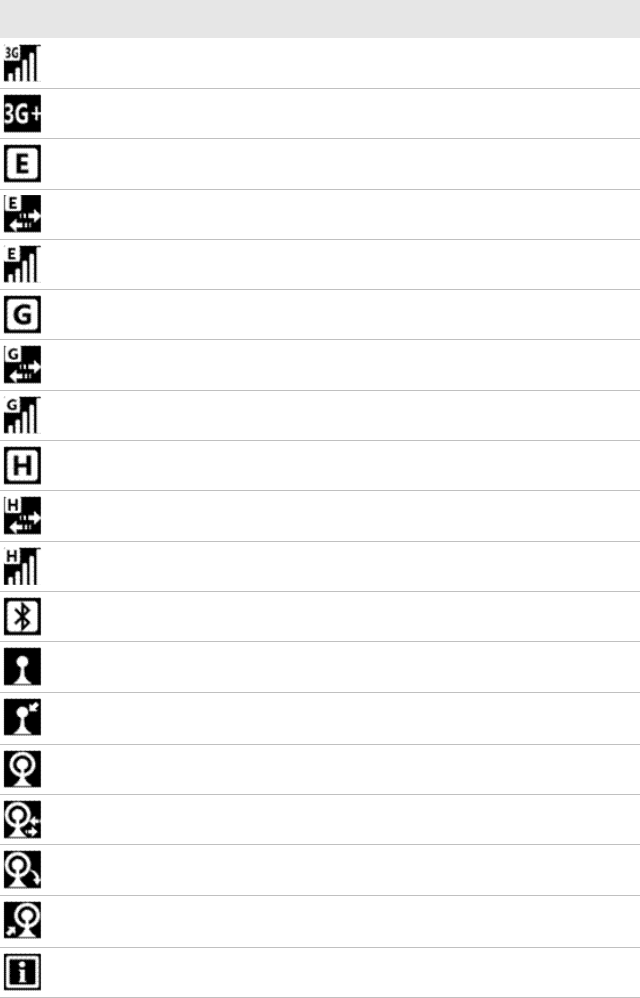
Chapter 2 — Understanding the User Interface and Intermec Applications
70 Series Mobile Computer User’s Manual 37
A UMTS connection is active.
A 3G+ network is available.
An EDGE network is available.
Connecting to an EDGE network.
An EDGE connection is active.
A GPRS network is available.
Connecting to a GPRS network.
A GPRS connection is active.
An HSDPA network is available.
Connecting to an HSDPA network.
An HSDPA connection is active.
Bluetooth is on.
Wi-Fi is on but not connected, and no networks are detected.
Wi-Fi is not connected to a network, and other networks are
detected.
Other wireless networks are detected.
Connected to a wireless network.
Synchronizing through a Wi-Fi connection.
Connected to a wireless network, and other networks are
detected.
Information about a new wireless network is available.
Icon Description
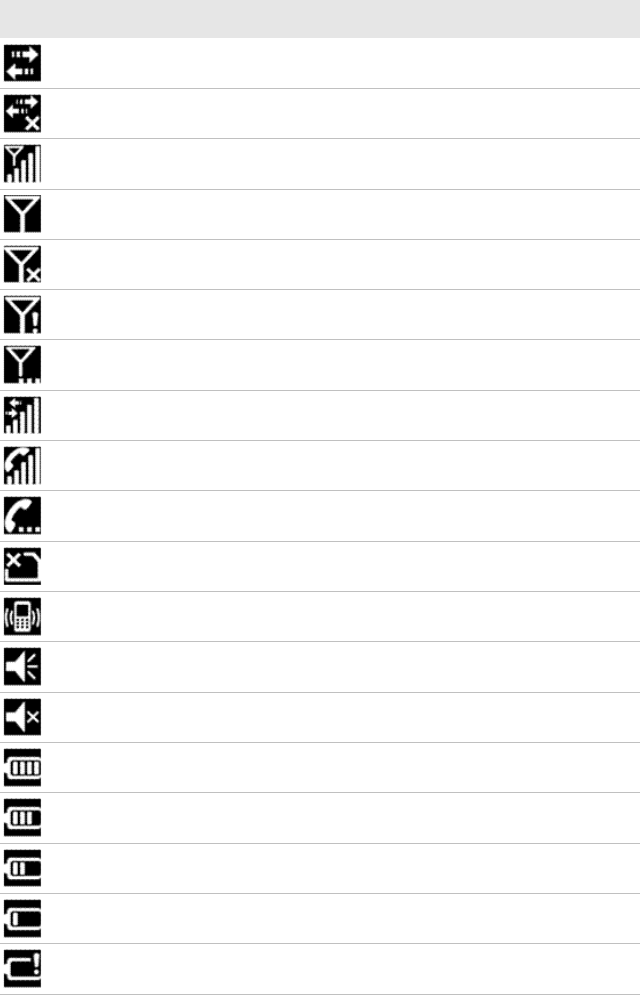
Chapter 2 — Understanding the User Interface and Intermec Applications
38 70 Series Mobile Computer User’s Manual
A network connection is active.
A netowrk connection is inactive.
The phone has maximum signal strength.
The phone has no signal.
The phone capability is off.
The phone has no service.
The phone is searching for service.
Data is being transferred.
A voice call is in progress.
A voice call in on hold.
There is no SIM card present in the computer.
The volume is off and the phone is set to vibrate.
The volume is on.
The volume is off.
The battery has a full charge.
The battery has a high charge.
The battery has a medium charge.
The battey has a low charge.
The battery has a very low charge.
Icon Description
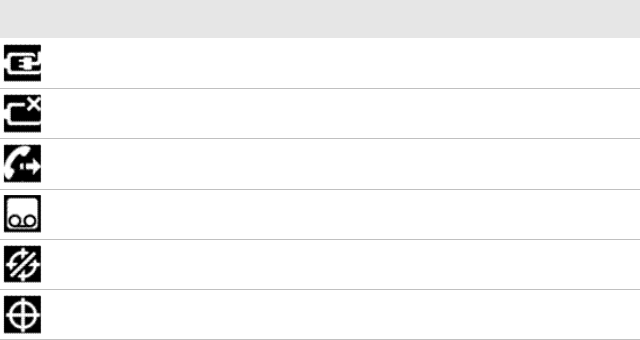
Chapter 2 — Understanding the User Interface and Intermec Applications
70 Series Mobile Computer User’s Manual 39
Aligning the Screen
You may need to align your screen if you tap on one area and it
registers in a different part of the screen.
To align the screen:
1) Tap Start (t) > Settings > System > Screen.
2) Follow the prompts on the screen to complete the alignment.
Make sure you only use the stylus to complete the alignment process.
About Intermec Applications
Intermec provides many useful applications to help you configure,
troubleshoot, and connect your computer to other devices and
networks. You can also download additional applications from
Intermec to help you use all of the features your 70 Series computer
includes.
The battery is attached to external power and is charging.
No battery is installed in the computer.
Call forwarding is on.
Voice mail is off.
GPS locator is off.
GPS locator is on.
Icon Description
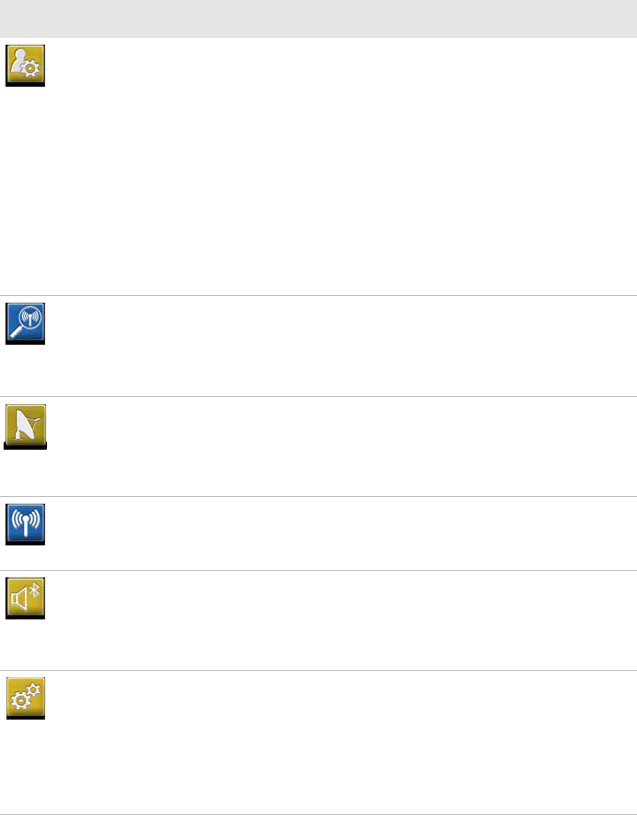
Chapter 2 — Understanding the User Interface and Intermec Applications
40 70 Series Mobile Computer User’s Manual
Applications Available on the Mobile Computer
Use this table to understand some of the Intermec applications
available on your computer.
Intermec Applications Available on the Mobile Computer
Icon Application Description
ProfileSettings Use ProfileSettings toeasily configure the computer
for a specific use. You can choose predefined values
for the Camera, Power, and Scanning.
To apply a profile setting:
•Tap the Profile Setting you want to use.
You will see a message that changes are saved and a
check mark appears next to your choice. .
For more information on modifying ProfileSettings
options, see “Configuring ProfileSettings
With Intermec Settings” on page 66.
ISpyWiFi Use ISpyWiFi to check your 802.11 status and
diagnose what is wrong with the connection. For
more information, see “Checking 802.11
Network Status” on page 105.
iGPS You can use the iGPS application to improve the
performance of GPS on your computer. For more
information, see “Improving GPS
Performance on the Computer” on page 58.
Wireless
Center
Use the Wireless Center to turn radios (WiFi,
Bluetooth, phone) on and off and configure settings
for each radio.
Bluetooth
Audio
Use the Bluetooth Audio application to connect to a
Bluetooth headset or hands-free device. For more
information, see “Connecting to a Bluetooth
Audio Device” on page 73.
Intermec
Settings
Use Intermec Settings to configure your computer.
You can use Intermec Settings to individually
configure a computer or you can use it through
SmartSystems to configure all of your computers.
For more information, see “Using Intermec
Settings on the Computer” on page 60.

Chapter 2 — Understanding the User Interface and Intermec Applications
70 Series Mobile Computer User’s Manual 41
Applications You Can Download to the Mobile Computer
You can download several Intermec applications from the website that
extend the capabilities of your 70 Series computer. All of the
applications listed below are available from the Interme website. To
find the application you want, go to www.intermec.com > Support >
Downloads and then enter the information to find your 70 Series
computer.
About SmartSystems Foundation
SmartSystems™ Foundation is an easy-to-use software platform that
provides IT Administrators and Integrators a single, integrated portal
for hands-free provisioning, deployment, and management of
Intermec devices minimizing the effort spent on software upgrades,
equipment monitoring, maintenance and trouble-shooting.
SmartSystems Foundation provides a consistent way to manage
Intermec devices including mobile computers, RFID readers, printers
and bar code scanners, located on-site or remote, to make the most of
limited IT resources, and lower the total cost of ownership for
Intermec data collection equipment. SmartSystems Foundation can
be downloaded at no charge from the Intermec web site. For more
information, visit www.intermec.com\SmartSystems.
Wireless
Scanning
Use the Wireless Scanning application to connect to
a Bluetooth scanner. For more information, see
“Connecting to a Bluetooth Scanner” on
page 70.
Wireless
Printing
Use the Wireless Printing application to connect to
a Bluetooth printer. For more information, see
“Connecting to a Bluetooth Printer” on
page 72.
Icon Application Description
Chapter 2 — Understanding the User Interface and Intermec Applications
42 70 Series Mobile Computer User’s Manual
About Features Demo
Intermec Features Demo provides a simple way to explore the key
features of your mobile computer. You will find applications that
demonstrate scanning, document imaging, image capture, printing,
GPS functionality, and the digital compass. Many of the applications
that are part of Features Demo also have separate full-featured
versions that you can download and license for your computer.
About Intermec Launcher
Intermec Launcher 1.01 is a Microsoft® Windows® application,
designed for Intermec mobile computers, that provides a platform
from which other applications may be launched while attempting to
provide a locked-down environment. You can configure Intermec
Launcher for your specific application requirements. You can
download and use Intermec Launcher for a 60-day evaluation period.
After the evaluation period expires, you will need to purchase a license.
About Intermec Browser
Intermec Browser is a locked-down web application for your computer
that is compatible with Microsoft™ Internet Explorer. You can
configure Intermec Browser for your specific application requirements
and design your own web pages. You can download and use Intermec
Browser for a 60-day evaluation period. After the evaluation period
expires, you will need to purchase a license.
About Intermec Connection Manager
Intermec Connection Manager is a software application and API
interface that provides seamless network roaming for Intermec mobile
computers configured with one or more wired or wireless technologies
(Ethernet, 802.11, GPRS, CDMA). Intermec Connection Manager
works in the background to automatically establish and maintain
connections. You can download and use Intermec Connection
Manager for a 60-day evaluation period. the evaluation period expires,
you will need to purchase a license.
Chapter 2 — Understanding the User Interface and Intermec Applications
70 Series Mobile Computer User’s Manual 43
About Image Capture
The Intermec Image Capture application is provided for use on the 70
Series computers with an EA30 imager. Image capture provides a way
for users to capture a high quality grayscale image with a mobile
computer. Image Capture also allows you to change settings to provide
the best image possible for the conditions present. You do not need to
license Image Capture.
About eMDI
Intermec Enhanced Mobile Document Imaging Application (eMDI) is
a professional document capture application that enables you to
capture images of full page documents (8.5 x 11 or A4 paper sizes). You
can transfer the images from your mobile computer to a PC or server.
For more information , see the Intermec Enhanced Mobile Document
Imaging User’s Guide. You can download and use eMDI for a 60-day
evaluation period. After the evaluation period expires, you will need to
purchase a license.
Chapter 2 — Understanding the User Interface and Intermec Applications
44 70 Series Mobile Computer User’s Manual

45
3
Using the Phone
You can use the cell phone to send and receive telephone calls,
as well as transmit data through cellular wide-area networks
(WANs).

Chapter 3 — Using the Phone
46 70 Series Mobile Computer User’s Manual
About the Phone
The 70 series mobile computer supports two types of cellular
technology:
•CDMA
•UMTS
Phone features on the computer include a speaker and a microphone.
You can also use a Bluetooth headset or hands-free kit. The default
setting for the phone is enabled.
After you turn on the phone and activate service with your wireless
carrier, you can customize the phone features and network settings.
For more information, see the online help on your mobile computer.
Activating the UMTS Phone
You use a SIM card to activate the UMTS phone on your computer.
You can purchase the SIM card from your network provider.
To install the SIM card and activate the UMTS radio:
1Press the Power button to turn off the computer.
2Push the battery release tab forward until the battery releases, and
lift the battery away from the computer.
3Remove the two Phillips screws and open the card access door.
Note: The computer resets when you remove the battery.
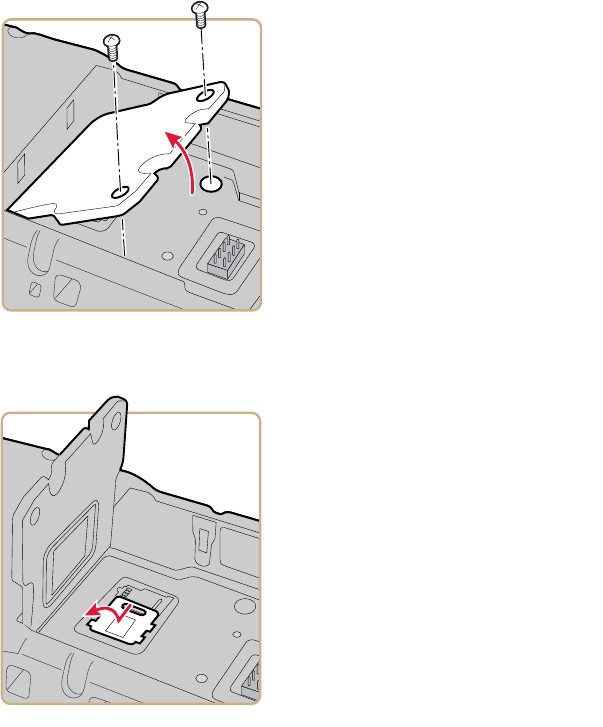
Chapter 3 — Using the Phone
70 Series Mobile Computer User’s Manual 47
4Slide the SIM card door to the left to unlock it and open the door.
5Slide the SIM card into the slot in the card access door.
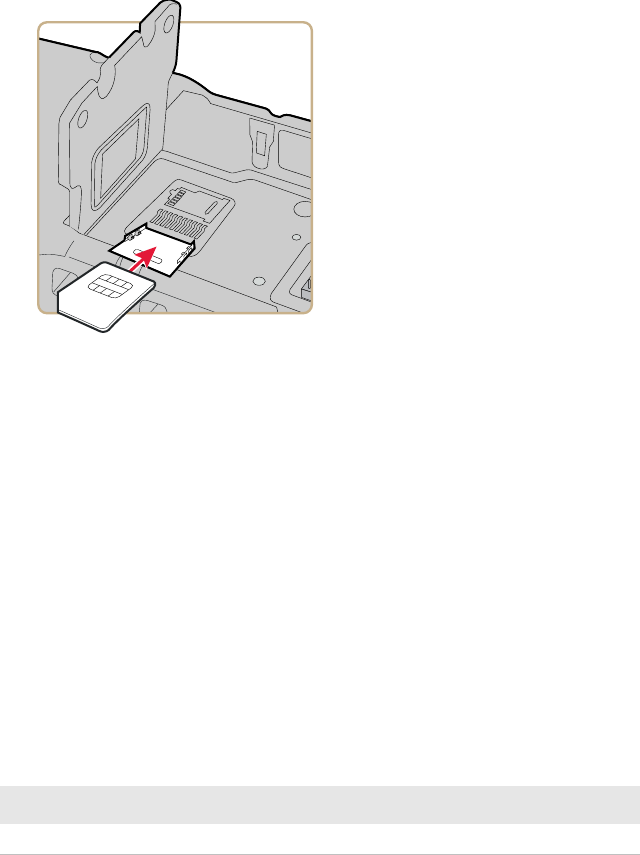
Chapter 3 — Using the Phone
48 70 Series Mobile Computer User’s Manual
6Close the SIM card door and slide it to the right to lock it in place.
7Close the card access door and replace the two screws.
8Install the battery. Press down firmly on the bottom of the battery,
and make sure that the battery release tab is fully engaged.
9Press the Power button. The computer cold boots.
Activating the CDMA Phone
To activate the CDMA radio module in your mobile computer, you
need to contact your wireless carrier and set up an account for each
mobile computer. The following table lists the carriers that Intermec
currently supports. If your carrier is not listed in the table, please
contact Intermec product support to see if it is now supported.
Currently Supported Carriers
The carrier will require the Electronic Serial Number (ESN) to start the
activation process. You can find the ESN:
•on a label located in the upper right corner of hte battery
compartment.
•on the outside of the computer shipping box.
Country Carriers
United States Sprint, Verizon

Chapter 3 — Using the Phone
70 Series Mobile Computer User’s Manual 49
The activation process is slightly different for each CDMA carrier.
Your carrier sales contact and an Intermec representative can guide
you through the process.
After you supply the ESN to your carrier, they will respond with values
that you must enter using the Windows Mobile Activation Wizard (if
required). Some of the supported carriers do not require you to enter
any values. The following table shows the carriers, the correct
activation method to use, and the values that you need to activate your
phone.
Values Required for CDMA Phone
After activation, the settings are permanently stored in the CDMA
module. Changing the OS or SSPB loads will not affect any of hte
settings or activation parameters stored in the WAN modem.
Starting the Activation Wizard
Depending on your wireless carrier, you may need to use the Windows
Mobile Activation Wizard to activate your phone.
To start the activation wizard:
1Tap Start > Phone, or tap the Phone button on the Tile bar.
The phone application starts.
2Tap Menu ( ) > Activation Wizard.
Turning the Phone On and Off
Before you can start using your phone, you need to enable it. You can
use Wireless Center to enable and disable your phone, as well
Bluetooth and Wi-Fi communications.
Carrier Activation Method Activation Values You Need
Sprint Activation Wizard •Master Subsidy Lock (MSL) or activation code
•MDN
•Mobile Station Identifier (MSID)
Verizon •Dial *22899
•Activation Wizard
None. All parameters are automatically
transferred wirelessly.
Chapter 3 — Using the Phone
50 70 Series Mobile Computer User’s Manual
To turn on the phone using Wireless Center:
1Tap Start > Settings > Connections > Wireless Center.
2Tap Phone to turn on the Phone
3(Optional) To configure the phone, tap Menu in the tile bar at the
bottom of the screen.
4Tap OKwhen you are done configuring the options.
5Tap OK to close Wireless Center.
Making a Phone Call
After you activate your phone, you are ready to start making phone
calls.
To make a phone call:
1Press Phone.
2Tap the keys to enter the telephone number you want to call, and
tap Talk.
Making an Emergency Phone Call
You can use the UMTS phone to make an emergency phone call even
if the SIM card is missing. When the SIM card is not installed, the
phone will show that you have no service. However, if you dial certain
emergency numbers (such as 112, 911, 000, 08, 118, 119, and 999) the
call will go through.

51
4
Using the Camera
You can use the color camera to take pictures and record
videos.

Chapter 4 — Using the Camera
52 70 Series Mobile Computer User’s Manual
About the Color Camera
The camera and flash are located on the back of the computer. You run
the Pictures & Videos application to access the camera features. In this
application, you can:
•take, view, and edit pictures.
•record and launch video clips stored on the computer or a microSD
card.
•configure camera options.
You can also send pictures and video clips to others or save an image
as the background on the Home screen.
Taking a Picture
You can take photos in high, normal, or low quality, with image sizes
up to 2048 x 1536 pixels. When you take a picture, the image is saved
as a .jpg file and stored in the /My Documents/My Pictures folder.
To take a picture:
1Tap Start > Pictures & Videos.
2Tap the Camera icon in the grid or the Camera button on the Tile
bar, or press Enter.
3Using the screen as a viewfinder, move the camera until you have
the image you want to take a picture of.
4Tap Take Pic on the Tile bar or press Enter to take and save the
picture. If you choose to save your pictures to Main memory, they
are saved to permanent storage on your mobile computer.
Note: While the Pictures & Videos application is running, you cannot
use the imager.
Chapter 4 — Using the Camera
70 Series Mobile Computer User’s Manual 53
Recording a Video
You need to switch to video mode to record video. When you record
video, the video is saved as an .mp4 file and stored in the /My
Documents/My Pictures folder.
To switch to Video mode and record video:
1Tap Start > Pictures & Videos.
2Tap the Camera icon in the grid or the Camera button on the Tile
bar, or press Enter.
3Tap Menu > Video.
In the lower right, the camera icon turns into a video camera. On
the Tile bar, the Record button replaces the Take Pic button.
4Using the screen as a viewfinder, move the video camera until you
see the scene you want to video record.
5Tap Record on the Tile bar or press Enter to start recording.
6When you are done, tap Stop or press Enter to stop recording and
save the video.
If you choose to save your videos to Main memory, they are saved to
permanent storage on the computer.
Saving Pictures and Videos to an SD Card
Pictures and videos are automatically saved to the main memory on
your computer. You can save your pictures and video to an SD card to
easily transport them to another device.
To save picture and video files to an SD card
1Install a microSD card. For help, see “Inserting a microSD Card”
on page 26.
2Tap Start > Pictures & Videos.
3Tap the camera icon.
4Tap Menu > Options.
5From the Save files to list, select SD card, and tap OK.
Chapter 4 — Using the Camera
54 70 Series Mobile Computer User’s Manual

55
5
Using GPS
The 70 Series computers come equipped with an integrated
Global Positioning System (GPS) receiver. It can deliver
standards-based National Marine Electronics Association
(NMEA) data strings to GPS applications.
Chapter 5 — Using GPS
56 70 Series Mobile Computer User’s Manual
About the Integrated GPS on Your Computer
Intermec recommends that you use the GPS Intermediate Driver
(GPSID) instead of directly accessing the GPS hardware. The GPSID is
a Microsoft software component that interacts between applications
and the GPS hardware. The GPSID supports Extended Ephemeris,
which enhances GPS performance by:
•reducing the amount of time it takes your GPS receiver to acquire
a fix.
•eliminating the need to obtain precise satellite data information
from the GPS satellites.
As a Microsoft software component, the GPSID also:
•allows multiple applications to simultaneously access the GPS data
stream.
•provides access to GPS data without requiring applications to
recognize and parse NMEA syntax.
Using the GPSID Installed on the Computer
To use the GPSID installed on your mobile computer, you need to
configure the GPSID settings.
To configure your GPSID settings:
1Tap Start > Settings > System > External GPS. The GPS Settings
screen appears with Programs selected.

Chapter 5 — Using GPS
70 Series Mobile Computer User’s Manual 57
2Select the COM port that you want your programs to use to get
GPS data from your computer.
3Tap Access in the horizontal scroll bar and select the Manage GPS
automatically check box.
4Tap ok.

Chapter 5 — Using GPS
58 70 Series Mobile Computer User’s Manual
Improving GPS Performance on the Computer
Use the iGPS application to improve the performance of the GPS on
your CN70, CN70e, or CK70 computer. The integrated GPS module
has three operating modes:
•Standalone
•MS assisted
•gpsOneXTRA™
In Standalone mode, the GPS module relies solely on GPS satellites to
determine position.
In MS Assisted mode, the comptuer can determine position without
receiving GPS signals directly from satellites; instead, the computer
receives GPS signals and information provided by the cellular network.
Even when the computer can receive a satellite signal, MS Assisted can
improve position accuracy and reduce the time to determine initial
position (Time-To-First-Fix). Check with your cell phone carrier for
availability and pricing for MS Assisted service.
Qualcomm’s gpsOneXTRA Assistance technology provides enhanced
operation for Standalone GPS. This option enables the UMTS-enabled
computer to automatically download a small assistance data file from
the XTRA servers through a brief internet access session.
Another option you can configure with iGPS is the fix interval. The fix
interval defines how often the GPS should provide new information.
Larger intervals use less power, but many applications require small
intervals to work correctly. The default for fix interval is 4.
To improve GPS performance:
1) Go to Start > Settings > System > iGPS.
2) In the Fix Interval tab, enter a value for the fix interval. The default
setting is 4 and should be optimized for most applications.
3) Tap the Fix Type tab and select Standalone (1), MS assisted (2), or
Enable gpsOneXTRA (check box).
4) Click OK.
Note: Anytime you change the GPS settings, the phone module will
reset automatically. It will not affect the functionality of the computer.

59
6
Configuring the Computer
Use this chapter to learn about the available methods for
configuring your mobile computer and how to use Intermec
Settings. You can also use this chapter to learn how to
configure network communications and wireless security.
Chapter 6 — Configuring the Computer
60 70 Series Mobile Computer User’s Manual
How to Configure the Computer
You can configure many parameters on the 70 Series computer such as
the bar code symbologies it decodes or the network settings. The
values you set for these parameters determine how the computer
operates.
There are several ways to configure the 70 Series computer:
•Directly on the computer. You can use Intermec Settings directly
on the 70 Series computer to change only the settings on that
computer. For more information, see “Using Intermec Settings
on the Computer” on page 60.
•Remotely using Intermec SmartSystems Foundation. When you
use SmartSystems, you can remotely configure all your 70 Series
computers as well as other SmartSystems-enabled Intermec
computers and peripherals. For more information, see “Using
Intermec Settings Remotely With SmartSystems Foundation”
on page 67.
•You can use a third-party device management product that
supports the 70 Series computer and Intermec Settings, such as
Soti MobiControl or Wavelink Avalanche. For more information,
visit the Device Management page on the Intermec web site.
•You can use imager configuration bar codes to enable or disable
symbologies, reset to factory defaults, and set predefined imager
modes. For more information, see “Imager Configuration Bar
Codes” on page 77.
You can also configure the computer with configuration bundles that
you create using SmartSystems Foundation. For more information,
see the SmartSystems Foundation online Help.
Using Intermec Settings on the Computer
Use Intermec Settings to configure parameters for Intermec
applications on the 70 Series computer as well as come device-specific
parameters like volume. You can configure parameters for important
functions like data collection and communications.
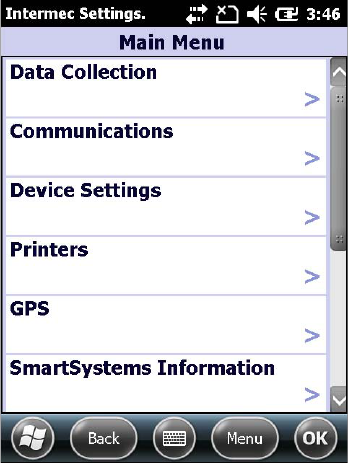
Chapter 6 — Configuring the Computer
70 Series Mobile Computer User’s Manual 61
Starting Intermec Settings
Intermec Settings is located on the Windows Mobile 6.5 System screen.
To start Intermec Settings:
•Tap Start > Settings > System > Intermec Settings.
The Intermec Settings Main Menu appears.
About the Structure of Intermec Settings
Finding the parameters you want to modify in Intermec Settings can
be challenging. Use the tables below to help find the parameters you
want to configure. Each table contains the parameters for one of the
Intermec Settings Main Menu options.
If you see > next to a menu option, there are more screens available in
the next level. If you see ... next to a menu option, there is only one
more screen available.
Most parameters are saved as soon as you tap OK. Some settings such
as the Serial Port Switch require you to reboot the computer for the
changes to take effect.

Chapter 6 — Configuring the Computer
62 70 Series Mobile Computer User’s Manual
Data Collection Menu
Communications Menu
Data Collection Options Parameters You Can Configure
Internal Scanner •Symbologies
•Scanner settings
•Imager settings
•Decode security
Dock Tethered Scanner •Symbologies
•Scanner settings
•Scanner port settings
•Imager settings
•Decode security
Camera •Symbologies
•Scanner settings
•Camera settings
•Decode security
BT-Configure on Connect Bluetooth-configure on connect
Magstripe Reader •Enable magstripe reader
•Reader model (read-only)
Communications Options Parameters You Can Configure
Device Name Device name
802.11 Radio •Security choice
•Security settings
•IP settings
•Certificates
Ethernet Adapter IP settings
Bluetooth Bluetooth settings (power, discoverable,
connectable, and so on)
WWAN Radio •Add WWAN connection
•Edit WWAN connections
•Manage WWAN radio
•WWAN information
Serial Port Switch Serial port switch settings (IrDA, docking
connector, and back interface)

Chapter 6 — Configuring the Computer
70 Series Mobile Computer User’s Manual 63
Device Settings Menu
Printer Menu
Device Settings Options Parameters You Can Configure
Date and Time Date and time settings
Good Read •Internal scanner
•Dock tethered scanner
•Bluetooth scanner
Volume Volume settings (beeper and voice,
headset beeper, and vibrate mode
intensity)
Backlight Backlight settings (display backlight,
keypad backlight, and light level)
Screen Screen rotation
Keypad Scan button remapping
Power Management •Power button
•Battery power
•External power
Compass Settings Compass settings (magnetic declination,
magnetic inclination, and custom value)
Sensors •Data streaming
•Screen rotation
•Device off
Storage Options USB connections
System Component Versions System component versions (read-only)
IDL Runtime Versions ITC50 (read-only)
Profiles •Camera
•Power
•Scanning
Features Disabled by Policy None (read-only)
Printer Options Parameters You Can Configure
Printer Printer settings (Auto detect printer,
memory, display, and so on)

Chapter 6 — Configuring the Computer
64 70 Series Mobile Computer User’s Manual
GPS Menu
SmartSystems Information Menu
Virtual Wedge Menu
Core Messaging Service Menu
GPS Options
GPS Bread crumbing settings
SmartSystems Information Options Parameters You Can Configure
Identity Identity information (hardware
version, firmware version, OS version,
and so on) (read-only)
Administrator Administrator settings (name, phone,
and email)
Location Location settings (country, state, city,
campus, and detail)
Information Device Notes (read-only)
Virtual Wedge Options Parameters You Can Configure
Enable Virtual Wedge Enable virtual wedge
Bar Code Scanner Wedge Bar code scanner wedge settings (bar code
scanner grid and label encoding)
Magstripe Reader Wedge Magstripe Reader Grid
Core Messaging Service Options Parameters You Can Configure
Server IP Server IP (read-only)
Associated Server IP Associated server IP
Broadcast Name Broadcast name
Port Port (read-only)
Keep Alive Ping Interval Keep alive ping interval

Chapter 6 — Configuring the Computer
70 Series Mobile Computer User’s Manual 65
Device Monitor Menu
License Manager Menu
Location Services Menu
For more information on all parameters in Intermec Settings, see the
Intermec Settings Command Reference Manual.
Navigating in Intermec Settings
You can easily navigate through the screens in Intermec Settings to
find the parameter you need to configure.
To move down a level in Intermec Settings:
•Tap the menu item in the list.
To move back a level in Intermec Settings:
•Tap Back or Cancel on the Tile bar.
Device Monitor Options Parameters You Can Configure
Device Health Controls •Enable health data collection
•Enable Blue light
•Set rule file location
•Set data refresh periods
Device Health Screen Captures Device health screen capture settings
(directory and screen capture allowed)
Disabled Executables None (read-only)
Device Wipe Device wipe settings (enable wipe and
interval)
License Manager Options Parameters You Can Configure
About About settings (read-only)
License Vault None (displays applications that are
licensed)
Location Services Options Parameters You Can Configure
Server Server settings (port and enable server)
Virtual GPS Virtual GPS settings
Chapter 6 — Configuring the Computer
66 70 Series Mobile Computer User’s Manual
To save a parameter setting:
•Tap OK.
To exit Intermec Settings:
•Tap Menu > Exit or OK.
Configuring ProfileSettings With Intermec Settings
A profile is a set of predefined values that you can easily apply to the
computer to ensure optimal performance in a specific scenario. The
end user does not need to figure out the “right” settings because we
have already done that work for you. ProfileSettings is available from
the Start menu so you can make it available to the end user for easy
configuration.
Use Intermec Settings to determine the profiles you want the end user
to see in the ProfileSettings application.
To configure the profile information an end user can access:
1) Go to Device Settings > Profiles.
2) Select Camera, Power, or Scanning.
3) From the Camera, Power, or Scanning submenu, check or clear the
Display check box for the settings you want to have available to the
end user.
4) Click OK to save your selection.
Restoring Default Settings
You can easily restore a menu to its default settings or all of the
Intermec Settings parameters to their default settings if necessary.
To restore menu defaults:
1) Navigate to the menu you want to restore to defaults.
2) Tap Menu > Restore Menu Defaults.
3) When prompted, tap Yes to restore the menu default settings.
4) If prompted to refresh the computer, tap Yes.

Chapter 6 — Configuring the Computer
70 Series Mobile Computer User’s Manual 67
To restore all defaults:
1) Tap Menu > Restore All Defaults. The applications asks if you are
sure you want to restore all defaults.
2) Tap Yes.
After several minutes, all of the default settings are restored.
Hiding Menu Items in Intermec Settings
You can hide items in the Intermec Settings menus if you do not want
to have them available for other users to access. Hidden items are not
saved when you back up your settings in the SmartSystems console.
On the 70 Series computer, you can:
•hide menu items by tapping and holding the item, and then
choosing Hide Menu Item from the popup list. When asked if you
want to hide the menu, tap Yes.
•restore hidden items in a single menu, by tapping and holding the
menu bar where the item was hidden, and then choose Restore
Item Default from the popup list.
•restore all hidden items in all menus, by tapping Menu > Unhide
All Items.
Using Intermec Settings Remotely With
SmartSystems Foundation
Your 70 Series computer is SmartSystems-enabled, which lets you
open Intermec Settings from the SmartSystems console to remotely
configure all of your mobile computers. For more information on
SmartSystems, see “Managing the Computer Using SmartSystems”
on page 92.
Note: When you restore default settings in Intermec Settings, only the
settings for visible items are restored to defaults. The settings for
hidden menu items are not affected.

Chapter 6 — Configuring the Computer
68 70 Series Mobile Computer User’s Manual
To open Intermec Settings from the SmartSystems console:
1) In the SmartSystems console, select a mobile computer and
right-click.
2) From the menu, select Intermec Settings.
3) Configure the settings you need to change. As you choose
parameters from the tree structure, help for each parameter
appears in the upper right pane of Intermec Settings.
4) When you are done making changes, choose File > Save Settings.
For help using Intermec Settings, click Help > Contents. For
information on all of the parameters in Intermec Settings, see the
Intermec Settings Command Reference Manual.
About Network Communications
You can easily add the 70 Series to your wireless or wired data
collection network. You can connect your computer using:
•802.11b/g radio communications.
•Ethernet communications.
•Bluetooth communications.
•USB and serial communications.
Configuring 802.11b/g Radio Communications
The 70 Series computer contains an 802.11 radio to transfer data using
wireless communications and supports the TCP/IP network protocols.
This section of the manual assumes that your wireless network is set
up, including your access points.
Make sure all components with antennas are at least 30 cm (1 ft)
apart when power is applied. Failure to comply could result in
equipment damage.

Chapter 6 — Configuring the Computer
70 Series Mobile Computer User’s Manual 69
To use wireless communications in a TCP/IP network:
1Configure these parameters on each mobile computer in the
network:
•Network name (SSID)
•IP settings (if not using DHCP)
2Make sure the mobile computer is talking to the network and that
the network can see your mobile computer. For more information,
see “Troubleshooting 802.1x Security” on page 104.
3Configure 802.11 security. For help, see “About Wireless
Security” on page 76.
Configuring Ethernet Communications
To configure Ethernet communications, you connect your mobile
computer to your Ethernet network using the Ethernet Snap-On
Adapter (Model 1000AA01).
To configure Ethernet communications:
1Connect the Ethernet snap-on adapter to your mobile computer.
2Connect the Ethernet cable from your network to the snap-on
adapter.
Ethernet communications are automatically enabled on your
mobile computer.
3Make sure that your computer is communicating with the network.
The network connection icon ( ) should appear on the title bar.
Configuring Bluetooth Communications
Your 70 Series is Bluetooth™-enabled, which lets you connect to other
Bluetooth devices, such as scanners, printers, or audio devices.
You need to turn on the Bluetooth radio before you can discover and
connect to other Bluetooth devices. By default, the radio is turned off.
To turn on the Bluetooth radio and configure Bluetooth settings:
1Tap Start > Settings > Bluetooth > Mode.
2Select the Turn on Bluetooth check box.
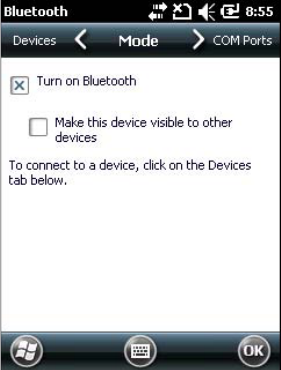
Chapter 6 — Configuring the Computer
70 70 Series Mobile Computer User’s Manual
3(Optional) If you want your 70 Series to be visible to other
Bluetooth devices, choose Make this device visible to other
devices.
4Tap OK.
The Bluetooth radio maintains its state through a warm or cold
boot and maintains virtual COM ports. But, if you clean boot your
70 Series you need to recreate pairings to devices.
Connecting to a Bluetooth Scanner
You can connect to an Intermec Bluetooth scanner, such as the SF51
or SR61.
To connect to an Intermec Bluetooth scanner:
1Tap Start > Settings > System > Wireless Scanning.
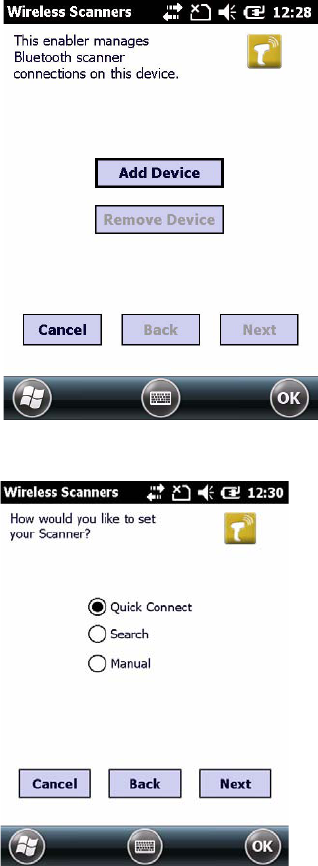
Chapter 6 — Configuring the Computer
70 Series Mobile Computer User’s Manual 71
2Tap Add Device.
3Select Quick Connect, Search, or Manual. Follow the onscreen
instruction to add a wireless scanner.
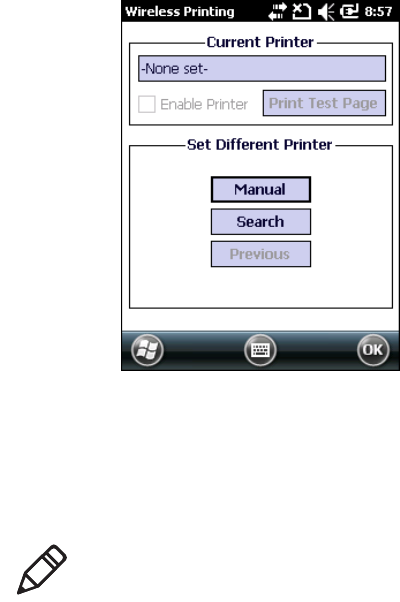
Chapter 6 — Configuring the Computer
72 70 Series Mobile Computer User’s Manual
Connecting to a Bluetooth Printer
To configure your 70 Series for Bluetooth wireless printing, you need
to:
•create an application that opens the wireless printing COM port on
your 70 Series. For help, see the Bluetooth Resource Kit, which is
part of the Intermec Developer Library (IDL), available from the
Intermec web site at www.intermec.com/idl.
•select the current wireless printer on your 70 Series. For help, see
the next procedure.
To select the current wireless printer
1Tap Start > Settings > System > Wireless Printing.
2Tap Search to find a printer, or tap Manual to enter a device
address. Follow the onscreen instructions to select the current
wireless printer.
3(Optional) Tap Print Test Page. The printer prints out a test page.
Note: You can also print wirelessly using Microsoft APIs with
Bluetooth extensions for Winsock and Bluetooth virtual COM ports.
For help, see the Bluetooth Resource Kit documentation.
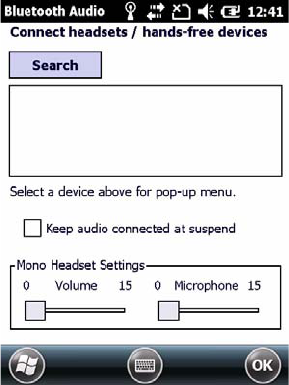
Chapter 6 — Configuring the Computer
70 Series Mobile Computer User’s Manual 73
Connecting to a Bluetooth Audio Device
Use the Bluetooth Audio enabler to discover, activate, and connect to
Bluetooth audio devices such as a headset. This enables system sounds
to be monitored through the headset.
To connect to a Bluetooth audio device:
1Tap Start > Settings > System > Bluetooth Audio.
2Tap Search to find your Bluetooth headset or hands-free device.
3Select your device from the list and configure any settings.
4Click OK when you are done.
About Serial and USB Communications
You can use these 70 Series accessories to transmit data to and receive
data from another device through serial or USB communications:
•RS-232 Snap-On Adapter (Model 1000AA03)
•USB Snap-On Adapter (Model 1000AA07)
For more information about these accessories and how to order them,
see “70 Series Accessories” on page 7.
Chapter 6 — Configuring the Computer
74 70 Series Mobile Computer User’s Manual
Creating an ISP Connection
You can create an Internet Service Provider (ISP) connection to send
and receive e-mail messages using Messaging (Outlook E-mail) and
view web pages using Internet Explorer Mobile. You need to get your
ISP dial-up access telephone number, a user name, and a password
from your ISP.
To create an ISP Connection:
1TapStart > Settings > Connections > Connections. (Yes, you need
to tap Connections twice.)
2Under My ISP, tap Add a new modem connection.
3Enter a name for the connection, such as “ISP Connection.”
4If you are using an external modem connected to your mobile
computer with a cable, select Hayes Compatible on COM1 from
the Select a modem list.
5Tap Next.
6Enter the access phone number and then tap Next.
7Enter the User name, Password, and Domain (if provided by an
ISP or your network administrator).
8Tap Finish.
9On the Connections screen, tap Advanced on the horizontal scroll.
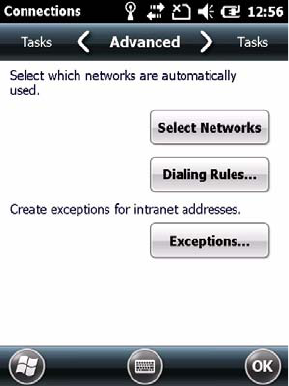
Chapter 6 — Configuring the Computer
70 Series Mobile Computer User’s Manual 75
10 Tap Dialing Rules.
11 When the Enable Dialing Rules box appears, tap OK.
12 Tap Edit.
13 In the Name field, enter your phone type (Home, Mobile, or
Work).
14 Tap ok until you exit the Connections screen.
Creating a VPN Server Connection
You can create a Virtual Private Network (VPN) connection to securely
connect to servers, such as a corporate network, through the Internet.
Before you can create a VPN connection, you need this information
from your network administrator:
•User name
•Password
•Domain name
•TCP/IP settings
•Host name or IP address of the VPN server
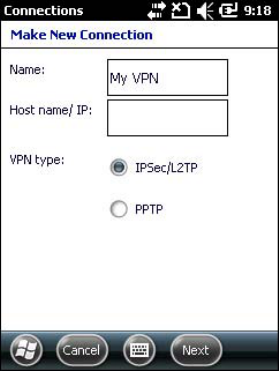
Chapter 6 — Configuring the Computer
76 70 Series Mobile Computer User’s Manual
To create a VPN server connection:
1TapStart > Settings > Connections > Connections. (Yes, you need
to tap Connections twice.)
2Under My Work Network, tap Add a new VPN server
connection.
3Step through the screens to set up your VPN connection.
About Wireless Security
The 70 Series provides four types of security for your wireless network:
•Wi-Fi Protected Access 2 (WPA2™)
•Wi-Fi Protected Access (WPA)
•802.1x
•WEP
This section explains how to configure wireless security on your 70
Series. If you choose not to use security, see “Disabling Security” on
page 90. Intermec recommends that you always implement security.
You must use either Funk or Microsoft security to implement your
security solution. For details, see the next section, “Choosing
Between Microsoft and Funk Security” on page 77.

Chapter 6 — Configuring the Computer
70 Series Mobile Computer User’s Manual 77
If you are using WPA-802.1x, WPA2-802.1x, or 802.1x security, this
section also assumes that your authentication server and
authenticators are properly configured.
Choosing Between Microsoft and Funk Security
The 70 Series supports both Funk and Microsoft security, which
dynamically select wireless networks based on your preferences. The
option you choose depends on your network security needs.
•If you are using the 70 Series in a static environment that requires
a high level of security, you should use Funk security, which offers
CCX v4.0 compliance, support for LEAP and TTLS, and
configuration for up to four profiles.
•To use Funk security, you need to select a profile. For help, see the
next section, “Choosing Between Microsoft and Funk Security.”
•If you are primarily using the 70 Series to connect to Wi-Fi
hotspots, you may want to use Microsoft security.
To use Microsoft security, you need to select it as your security
choice. For help, see “Selecting Microsoft as Your Security
Choice” on page 82.
Selecting a Funk Security Profile
You can define up to four profiles for Funk security. Different profiles
let your 70 Series communicate in different networks without having
to change all of your security settings. For example, you may want to
set up one profile for the manufacturing floor and one for the
warehouse. By default, the active profile is Profile 1.
Note: Your security choice does not depend on your authentication
server. For example, you can choose Funk security if you use Microsoft
Active Directory® to issue certificates.
Note: You can also use the Profile Wizard to configure most wireless
security settings. To start the Profile Wizard, tap the iConnect icon in
the lower right corner of the Today screen and select Tools > Wireless
Settings.

Chapter 6 — Configuring the Computer
78 70 Series Mobile Computer User’s Manual
Selecting a Funk Security Profile
Use the following procedure to select a Funk security profile.
1Start Intermec Settings.
2Choose Communications > 802.11 Radio > Funk Security.
3Choose a profile. A list of configurable settings appears.
4(Optional) In the Profile Label text box, enter a meaningful name
for your profile.
5Configure your security settings. For help, see the next sections.
6Repeat Steps 3 through 5 for each profile you want to define.
7Set an active profile by choosing it in the Active Profile list.
8Save your settings.
Configuring WPA Security With Funk Security
Use these procedures to set WPA-802.1x, WPA2-802.1x, WPA-PSK, or
WPA2-PSK security on your 70 Series with Funk security.
1Make sure the communications and radio parameters on your 70
Series are configured.
2Make sure Funk is selected as your security choice.
3Start Intermec Settings.
4Choose Communications > 802.11 Radio > Funk Security.
5Select the profile you want to configure.
6For Association, choose WPA or WPA2. Encryption
automatically defaults to TKIP or AES, respectively.
7For 8021x, choose TTLS, PEAP, EAP-FAST, or TLS.
8If you choose TTLS or PEAP:
aFor Prompt for Credentials, choose Enter credentials now.
bEnter a User Name and User Password.
cFor Validate Server Certificate, choose Yes.
Note: You can use Prompt for Credentials to troubleshoot your
network connection.

Chapter 6 — Configuring the Computer
70 Series Mobile Computer User’s Manual 79
9If you choose TLS:
aLoad a user and root certificate on your 70 Series. For help, see
“Loading a Certificate” on page 88.
bEnter a User Name and Subject Name.
cFor Validate Server Certificate, choose Yes.
d(Optional) To increase your level of security, enter a Server 1
Common name and a Server 2 Common name.
Configuring WPA or WPA2 with Funk Security
Use the following procedure to configure WPA or WPA2 with Funk
security.
1Make sure the communications and radio parameters on your 70
Series are configured.
2Make sure Funk is selected as your security choice.
3Start Intermec Settings.
4Choose Communications > 802.11 Radio > Funk Security.
5Select the profile you want to configure.
6For Association, choose WPA or WPA2.
7For 8021x, choose None.
8For Pre-Shared Key, enter the pre-shared key or passphrase.
The pre-shared key must be a value of 32 hex pairs preceded by 0x
for a total of 66 characters. The value must match the key value on
the access point. The passphrase must be from 8 to 63 characters.
After you enter a passphrase, the 70 Series internally converts it to
a pre-shared key. This value must match the passphrase on the
authenticator.
9Save your settings.
Note: The correct date must be set on your 70 Series when you enable
Validate Server Certificate.

Chapter 6 — Configuring the Computer
80 70 Series Mobile Computer User’s Manual
Configuring 802.1x Security With Funk Security
Use the following procedure to configure 802.1x security with Funk
security.
1Make sure the communications and radio parameters on your 70
Series are configured.
2Make sure Funk is selected as your security choice.
3Start Intermec Settings.
4Choose Communications > 802.11 Radio > Funk Security.
5Select the profile you want to configure.
6For Association, choose Open.
7For Encryption, choose WEP.
8For 8021x, choose TTLS, PEAP, or TLS.
9If you chose TTLS or PEAP:
aEnter a User Name.
bFor Prompt for Credentials, choose Enter credentials now.
cEnter a User Password.
dFor Validate Server Certificate, choose Yes.
10 If you choose TLS:
aLoad a user and root certificate on your 70 Series. For help, see
“Loading a Certificate” on page 88.
bFor Validate Server Certificate, choose Yes.
cEnter a User Name and Subject Name.
d(Optional) To increase your level of security, enter a Server 1
Common name and a Server 2 Common name.
11 (Optional) To increase your level of security, enter a Server 1
Common name and a Server 2 Common name.
12 Save your settings.
Note: You can use Prompt for Credentials to troubleshoot your
network connection.
Chapter 6 — Configuring the Computer
70 Series Mobile Computer User’s Manual 81
Configuring LEAP Security
Use the following procedure to configure LEAP security.
1Make sure the communications and radio parameters on your 70
Series are configured.
2Make sure Funk is selected as your security choice.
3Start Intermec Settings.
4Choose Communications > 802.11 Radio > Funk.
5Select the profile you want to configure.
6For 8021x, choose LEAP.
7For Association, choose Open, WPA, WPA2, or Network EAP.
Encryption automatically defaults to TKIP if you choose WPA,
AES if you choose WPA2, and WEP if you choose Open or
Network EAP.
8For Prompt for Credentials, choose Enter credentials now.
9Enter a User Name and User Password.
10 Save your settings.
Configuring Static WEP Security With Funk Security
Use the following procedure to configure static WEP security with
Funk.
1Make sure the communications and radio parameters on your 70
Series are configured.
2Make sure Funk is selected as your security choice.
3Start Intermec Settings.
4Choose Communications > 802.11 Radio > Funk Security.
5Select the profile you want to configure.
6For Association, choose Open.
7For Encryption, choose WEP.
8For 8021x choose None.
Chapter 6 — Configuring the Computer
82 70 Series Mobile Computer User’s Manual
9Define a value for the keys you want to use. You can define up to
four keys (Key 1 through Key 4).
Enter an ASCII key or a hex key that is either 5 bytes or 13 bytes
long depending on the capability of the radio. Set a 5- byte value for
64-bit WEP or a 13-byte value for 128-bit WEP. Hex keys must be
preceded by 0x and contain 5 or 13 hex pairs.
10 For Transmit key, choose the key you want to use for transmitting
data.
11 Save your settings.
Selecting Microsoft as Your Security Choice
The default security setting is Funk. If you want to use Microsoft
security, you need to select it as your security choice. After you select
Microsoft as your security choice, you will be prompted to save your
settings and reset your 70 Series for your change to take effect.
With Microsoft as your security choice, you can configure:
•WPA
•802.1x
•Static WEP
Selecting Microsoft Security
Use the following procedure to select Microsoft security.
1Start Intermec Settings. For help, see “Configuring the
Computer” on page 59.
2Choose Communications > 802.11 Radio > Security Choice.
3From the Security Choice list, select Microsoft Security. An alert
box appears telling you that you must save your settings and warm
boot the 70 Series for the new security choice to take effect.
4Choose Yes. The 70 Series resets and starts with Microsoft Security
as the Security Choice.
Chapter 6 — Configuring the Computer
70 Series Mobile Computer User’s Manual 83
Configuring WPA Security With Microsoft Security
Use these procedures to set WPA-802.1x and WPA-PSK security on
your 70 Series with Microsoft security
1Make sure the communications and radio parameters on your 70
Series are configured.
2Start Intermec Settings.
3Choose Communications > 802.11 Radio > Microsoft Security.
4For Infrastructure Mode, choose Infrastructure.
5For Network Authentication, choose WPA. Data Encryption
automatically defaults to TKIP.
6For 802.1x Authentication, choose either MD5, TLS, or PEAP.
7If you choose TLS:
aChoose Properties > Run App. The Auth. Settings dialog box
appears.
bChoose Select.
cSelect your certificate from the list and press Enter. The User
Logon dialog box appears.
dEnter a User Name and Domain and press Enter.
8If you choose PEAP:
aChoose Properties > Run App. The Auth. Settings box appears.
bChoose Validate Server and press Enter. When the radio starts
to authenticate, the Network Password dialog box appears.
cEnter a User Name and Password and select Save Password.
d(Optional) In the Domain field, enter the Active Directory
domain associated with the user account.
9Save your settings.
Chapter 6 — Configuring the Computer
84 70 Series Mobile Computer User’s Manual
Enabling WPA-PSK With Microsoft Security
Use the following procedure to enable WPA-PSK With Microsoft
Security.
1Make sure the communications and radio parameters on your 70
Series are configured.
2Start Intermec Settings.
3Choose Communications > 802.11 Radio > Microsoft Security.
4For Infrastructure Mode, choose Infrastructure.
5For Network Authentication, choose WPA-PSK. Data
Encryption automatically defaults to TKIP.
6For Pre-Shared Key, enter the pre-shared key or the passphrase.
The pre-shared key must be a value of 32 hex pairs preceded by 0x
for a total of 66 characters. The value must match the key value on
the authenticator. The passphrase must be from 8 to 63 characters.
After you enter a passphrase, the 70 Series internally converts it to
a pre-shared key.
7Save your settings.
Configuring 802.1x Security with Microsoft Security
Use the following procedure to configure 802.1x security with
Microsoft security.
1Make sure the communications and radio parameters on your 70
Series are configured.
2Start Intermec Settings.
3Choose Communications > > 802.11 Radio > Microsoft
Security.
4For Infrastructure Mode, choose Infrastructure.
5For Network Authentication, choose Open.
6For Data Encryption, choose WEP.
7For 802.1X Authentication, choose TLS or PEAP.
Chapter 6 — Configuring the Computer
70 Series Mobile Computer User’s Manual 85
8If you choose TLS:
aChoose Properties > Run App. The Auth. Settings box appears.
bChoose Select.
cSelect your certificate from the list and press Enter. The User
Logon dialog box appears.
dEnter a User Name and a Domain.
9If you choose PEAP:
aChoose Properties > Run App. The Auth. Settings box appears.
bSelect Validate Server and press Enter. When the radio starts
to authenticate, the Network Password dialog box appears.
cEnter a User Name and Password and select Save Password.
d(Optional) In the Domain field, enter the domain.
ePress Enter.
10 For Network Key Setting, choose Automatic.
11 Save your settings.
Configuring Static WEP Security With Microsoft Security
Use the following procedure to configure static WEP security with
Microsoft security.
1Make sure the communications and radio parameters on your 70
Series are configured.
2Start Intermec Settings.
3Choose Communications > > 802.11 Radio > Microsoft
Security.
4For Network Authentication, choose Open.
5For Network Authentication, choose WPA. Data Encryption
automatically defaults to TKIP.
6For 802.1x Authentication, choose either MD5, TLS, or PEAP.
Chapter 6 — Configuring the Computer
86 70 Series Mobile Computer User’s Manual
7If you choose TLS:
aChoose Properties > Run App. The Auth. Settings dialog box
appears.
bChoose Select.
cSelect your certificate from the list and press Enter. The User
Logon dialog box appears.
dEnter a User Name and Domain and press Enter.
If you choose PEAP:
eChoose Properties > Run App. The Auth. Settings box appears.
fChoose Validate Server and press Enter. When the radio starts
to authenticate, the Network Password dialog box appears.
gEnter a User Name and Password and select Save Password.
h(Optional) In the Domain field, enter the Active Directory
domain associated with the user account.
8Save your settings.
Enabling WPA-PSK with Microsoft Security
Use the following procedure to enable WPA-PSK with Microsoft
security.
1Make sure the communications and radio parameters on your 70
Series are configured.
2Start Intermec Settings.
3Choose Communications > 802.11 Radio > Microsoft Security.
4For Infrastructure Mode, choose Infrastructure.
5For Network Authentication, choose WPA-PSK. Data
Encryption automatically defaults to TKIP.
6For Pre-Shared Key, enter the pre-shared key or the passphrase.
The pre-shared key must be a value of 32 hex pairs preceded by 0x
for a total of 66 characters. The value must match the key value on
the authenticator. The passphrase must be from 8 to 63 characters.
Chapter 6 — Configuring the Computer
70 Series Mobile Computer User’s Manual 87
After you enter a passphrase, the 70 Series internally converts it to
a pre-shared key.
This value must match the passphrase on the authenticator.
7Save your settings.
Configuring 802.1x Security with Microsoft Security
Use the following procedure to configure 802.1x security with
Microsoft.
1Make sure the communications and radio parameters on your 70
Series are configured.
2Start Intermec Settings.
3Choose Communications > 802.11 Radio > Microsoft Security.
4For Infrastructure Mode, choose Infrastructure.
5For Network Authentication, choose Open.
6For Data Encryption, choose WEP.
7For 802.1X Authentication, choose TLS or PEAP.
8If you choose TLS:
aChoose Properties > Run App. The Auth. Settings box
appears.
bChoose Select.
cSelect your certificate from the list and press Enter. The User
Logon dialog box appears.
dEnter a User Name and a Domain.
If you choose PEAP:
eChoose Properties > Run App. The Auth. Settings box appears.
fSelect Validate Server and press Enter. When the radio starts
to authenticate, the Network Password dialog box appears.
gEnter a User Name and Password and select Save Password.
h(Optional) In the Domain field, enter the domain.
iPress Enter.
Chapter 6 — Configuring the Computer
88 70 Series Mobile Computer User’s Manual
9For Network Key Setting, choose Automatic.
10 Save your settings.
Configuring Static WEP Security With Microsoft Security
Use the following procedure to configure static WEP security with
Microsoft security.
1Make sure the communications and radio parameters on your 70
Series are configured.
2Start Intermec Settings.
3Choose Communications > 802.11 Radio > Microsoft Security.
4For Network Authentication, choose Open.
5For Data Encryption, choose WEP.
6For Network Key Setting, choose Enter Key and Index.
7For Network Key Value, enter an ASCII key or a hex key that is
either 5 bytes or 13 bytes long depending on the capability of the
radio.
Set a 5-byte value for 64-bit WEP or a 13-byte value for 128-bit
WEP. Hex keys must be preceded by 0x and contain 5 or 13 hex
pairs.
8For Network Key Index, select the key you want to use for data
transmission.
9Save your settings.
Loading a Certificate
To use transport layer security (TLS) with WPA or 802.1x security, you
need a unique client certificate on the 70 Series and a trusted root
certificate authority (CA) certificate. Certificates are pieces of
cryptographic data that guarantee a public key is associated with a
private key. They contain a public key and the entity name that owns
the key. Each certificate is issued by a certificate authority.
To import a root certificate:
1Start Intermec Settings.
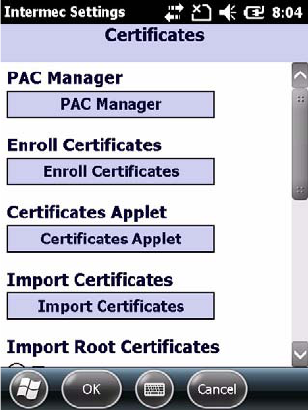
Chapter 6 — Configuring the Computer
70 Series Mobile Computer User’s Manual 89
2Go to Start > Settings > System > Intermec Settings.
3Tap Communications > 802.11 Radio > Certificates.
4To import a root certificate:
aSelect True under Import Root Certificates.
bTap Import Certificates to install the selected certificate.
cIn the CertImportUI screen, tap the <<< button next to the
Select pfx to import text field.
dSelect the root certificate from the list.
eTap Import Certificate.
5To import a certificate from an IAS server:
aTap Import Certificates.
bTap Web Enrollment.
cEnter the User, Password, and Server (IP address) to log into
the server.
dTap OK. A dialog box appears asking if you want to load the
root certificate.
Chapter 6 — Configuring the Computer
90 70 Series Mobile Computer User’s Manual
eTap OK. The Enrollment Tool message box appears telling you
that the certificate has been added.
fTap OK to close the message box.
Disabling Security
If you choose not to use security with your wireless network, you can
disable it on the computer. Intermec recommends that you always set
security in your network.
To disable security:
1Start Intermec Settings. For help, see “Configuring the
Computer” on page 59.
2Choose Communications > 802.11 Radio > Security Choice and
select Microsoft Security. An alert box appears telling you that
you must save your settings and warm boot the 70 Series for the
new security choice to take effect.
3Choose Yes. The 70 Series resets and starts with Microsoft Security
as the Security Choice.
4Start Intermec Settings.
5Choose Communications > 802.11 Radio > Microsoft Security.
6For Network Authentication, choose Open.
7For Data Encryption, choose Disabled.
8Tap OK. Your settings are saved.

91
7
Managing the Computer
Use this chapter to learn how to remotely update, configure,
and monitor your Intermec mobile computers. You will also
find information on installing and developing software
applications as well as how to upgrade the system software.
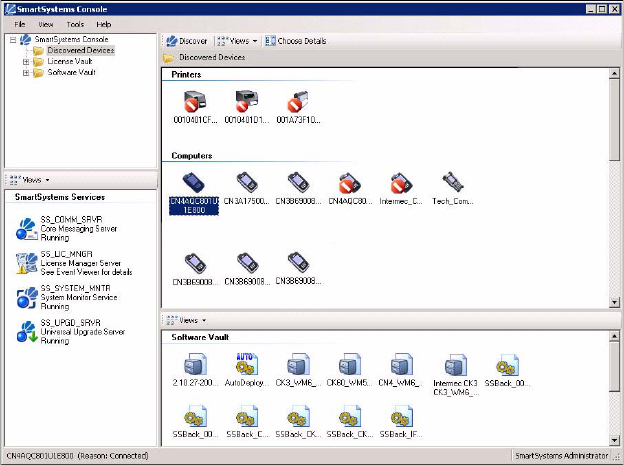
Chapter 7 — Managing the Computer
92 70 Series Mobile Computer User’s Manual
Managing the Computer in Your Network
When you have multiple mobile computers and peripherals in your
network, it is essential to have an easy way to manage updates,
configure all of the devices, and remotely troubleshoot problems.
Intermec provides a free device management software platform called
SmartSystems to help you manage your devices. You can also purchase
third-party device management software through a vendor.
Managing the Computer Using SmartSystems
Intermec's SmartSystems™ Foundation is a software platform that
lets you manage all of your SmartSystems-enabled devices
simultaneously from a central server. The SmartSystems console
displays all SmartSystems-enabled computers and peripherals in your
network.
Intermec SmartSystems Foundation Console
Through the Console, you can:
•drag-and-drop configuration bundles, operating system updates,
and firmware upgrades to multiple computers.
Chapter 7 — Managing the Computer
70 Series Mobile Computer User’s Manual 93
•save configuration settings from a single device and deploy those
settings to many devices simultaneously.
•remotely change settings on SmartSystems-enabled computers and
peripherals.
The SmartSystems console can report on asset locations and battery
status, making it easier to manage your mobile devices.
With an AutoDeploy license, SmartSystems can automatically push
software, configuration settings, and other files to connected mobile
computers. The license also enables Scan-to-Connect, which makes
connecting additional mobile computers to your wireless network as
easy as reading bar codes. SmartSystems Foundation can be
downloaded at no charge from the Intermec web site. For more
information, visit www.intermec.com\SmartSystems. To purchase
an AutoDeploy license, contact your local Intermec sales
representative.
Managing the Computer Using Third-Party Software
You can use third-party software such as Wavelink Avalanche to
centrally manage your Intermec devices. Device management software
enables you to update software, increase security, track your assets,
and troubleshoot devices remotely. You can download the Wavelink
Enabler for the CS40 from the Wavelink web site. For more
information, visit the Intermec web site and search for Wavelink
Avalanche or visitwww.wavelink.com to download the enabler.
Developing and Installing Applications
Use the Intermec Resource Kits to develop applications to run on the
mobile computer. The Resource Kits are a library of C++, .NET, Java,
and web components grouped by functionality that you can use to
create applications for the computer. The Resource Kits are part of the
Intermec Developer Library (IDL), and can be downloaded from the
Intermec web site at www.intermec.com/idl.
For more information, see the Intermec Developer Library Resource
Kit Developer’s Guide.

Chapter 7 — Managing the Computer
94 70 Series Mobile Computer User’s Manual
Packaging Your Application
For very simple applications, the executable file may be the only file
you need to deploy. More typically, you will have a set of files to install.
Intermec recommends using .cab files to install your applications. The
computer uses standard Windows Mobile .cab files and will install
third-party .cab files.
Choosing a Target Location
You can have your .cab file place your application in any of these
memory locations on the mobile computer:
•The ObjectStore.
•The optional microSD card. Depending on available disk space,
you may want to consider installing your application files on the
microSD card. Using a card creates the Storage Card folder on the
computer.
•The non-volatile Flash File Store. Applications and data in the
Flash File Store will persist through a clean boot.
Files copied to any of these locations are safe when you cold boot the
computer as long as the AutoRun system is installed in the appropriate
location. When AutoRun is installed on the computer, all .cab files in
the CabFiles folder are automatically extracted after a cold boot. For
more information about AutoRun, see the Intermec Developer
Library Resource Kit Developer’s Guide.
Installing Applications Using SmartSystems Foundation
Console
You can use the SmartSystems console to drag-and-drop Intermec
applications onto your mobile computer. The console is part of
SmartSystems Foundation.
1Download your application file from the Intermec web site and
unzip it on your desktop PC.
Note: The Flash File Store may be erased if you reflash the image.
Chapter 7 — Managing the Computer
70 Series Mobile Computer User’s Manual 95
2Double-click the application file to install it. The application file
should appear in the Software Vault.
3From the SmartSystems console in the Software Vault,
drag-and-drop the application onto each mobile computer in your
network, or drop the application on a group of computers
contained in a folder.
Installing Applications Using Microsoft ActiveSync
When you only have a few computers to update with applications, you
can copy files using Microsoft ActiveSync. This procedure assumes
that Microsoft ActiveSync is installed on your PC and is up and
running.
1Connect to the mobile computer via ActiveSync.
2Copy the .cab files from your development PC to the computer.
3Warm boot or cold boot the computer.
4After the boot process is finished, browse to the .cab files and tap
the files to install them.
Installing Applications Using a Storage Card
Use a storage card to install applications on one computer at a time or
if you have no network connection.
To install applications using a storage card:
1Copy your application file to the storage card.
2Install the storage card in the mobile computer.
3On the mobile computer, browse to the Storage Card folder and
run your application.
Chapter 7 — Managing the Computer
96 70 Series Mobile Computer User’s Manual
Installing Applications Using the FTP Server
The mobile computer has a built-in FTP server that connects to a
network through Ethernet, 802.11 a/b/g/n, or WAN (Wireless Access
Network). You can use the server to transfer your application file to the
computer. Because you can create FTP scripts to automate the process
of copying files to the computer, this option is useful when you need
to send files to a large number of computers. The easiest way to
manage the FTP server is to enable the FTP menu within iConnect.
To enable the FTP server:
•Create this DWORD registry key and set it to a value of 1:
HKEY_CURRENT_USER\Software\iConnect2\IConnect\Setting
s
\ShowFTPMenu
The iFTP menu is available the next time you start iConnect.
To manage the state of the FTP server, modify these existing registry
keys where 1 = enable and 0 = disable:
•HKEY_CURRENT_USER\Software\iConnect2\IConnect\Settings
\FtpAutoStart
•HKEY_CURRENT_USER\Software\iConnect2\IConnect\Settings
\FtpHeartbeat
Launching Applications Automatically
There are two ways to launch an application automatically on a cold
boot:
•Set up your .cab file to place a shortcut to the application in the
\Windows\StartUp directory at install time.
•Use AutoRun.exe to start your application at boot time. AutoRun
ships on the computer and automates other operations.
At boot time, AutoRun executes any commands found in its data file,
AutoRun.dat. Follow the next procedure to create this data file for
your mobile computer.
For more information on AutoRun, see the Intermec Developer
Library Resource Kit Developer’s Guide.
Chapter 7 — Managing the Computer
70 Series Mobile Computer User’s Manual 97
To configure AutoRun:
1In Notepad, create a file called AutoUser.dat.
2Write this command in the file:
RUN “Path\AppName.exe” arg1, arg2, arg3
where:
Path is the path to the directory where the application resides.
AppName.exe is the application name.
arg1, arg2, and arg3 are optional command line arguments.
For example, to launch MyProgram.exe located in the Flash File
Store, the command is EXEC “Flash File
Store\Apps\MyProgram.exe”.
Because AutoRun handles quoted file names for the first
parameter, you can specify path names or file names containing
white spaces. AutoRun only supports one set of quotes per
command.
3Copy AutoUser.dat to the \Windows\Startup directory on the
mobile computer.
Updating the System Software
The mobile computer uses Image Update to update the operating
system (OS) and the system software. Image Update uses incremental
packages to allow for smaller and faster updates because the contents
are stored in flash ROM.
Update packages persist through a cold or clean boot and cannot be
removed by the end user. The Image Update process also provides
strengthened security because all packages are signed. Image Update
packages (.pkg or .pks files) may contain elements such as DLLs,
executable (.exe) files, and .cab files.
You can use either of these methods to update your mobile computer:
•You can update multiple computers at the same time using the
SmartSystems Console. For help, see the next section,
Chapter 7 — Managing the Computer
98 70 Series Mobile Computer User’s Manual
•You can update individual computers by transferring the packages
to the mobile computer and then installing them from the mobile
computer.
If you are using SmartSystems Console to update the computer, you
can purchase a Provisioning License to send the Image Update silently.
For more information, see “Sending the Image Updates Silently” on
page 99.
Updating Multiple Computers Using SmartSystems Console
You can use the SmartSystems console to update the operating system
or system software on your mobile computer. The console is part of
SmartSystems Foundation and is available from the Intermec web site
through the Intermec Developer Library (IDL). Before you can update
your mobile computer, you need:
•SmartSystems Foundation. To download SmartSystems
Foundation, go to www.intermec.com/idl and open the Device
Management page.
•the SmartSystems bundles you want to install. The SmartSystems
bundle contains the Image Update package file. These
SmartSystems bundles are available from the Intermec web site at
www.intermec.com. Go to Support > Downloads.
To update the mobile computer using SmartSystems Foundation:
1) Open the SmartSystems console.
2) Make sure the SmartSystems console and the mobile computer are
on the same subnet and they are connected wirelessly or through
Ethernet.
3) Make sure the mobile computer is in communications dock or a
charging dock or that power management is disabled.
4) Download the SmartSystems bundle to your PC.
5) Double-click the SmartSystems bundle on your PC to extract the
update files to the software vault.
6) From the SmartSystems console, locate the bundles to install and
drag them to each mobile computer (or group in a folder) you want

Chapter 7 — Managing the Computer
70 Series Mobile Computer User’s Manual 99
to update. The SmartSystems console installs the update on your
mobile computers.
After the download is complete, your mobile computer begins the
update process and automatically performs a cold boot. The
computer then boots into a special Update Loader mode where the
computer has no network connections and is completely unusable.
This process can take anywhere from 30 seconds to 15 minutes
depending on the update.
After the update is complete, the computer boots again.
7) When a confirmation dialog box appears requesting user input,
dismiss it.
Sending the Image Updates Silently
If you want to automatically download and send update packages to
your mobile computers, you can purchase a Provisioning license. The
silent updates do not require any user intervention and begin when
you choose to have the update process start. SmartSystem Foundation
users are notified when update packages are released so that they can
download then and update their Intermec computers. For more
information, see the SmartSystems Foundation Help.
Updating Individual Mobile Computers
You can download update packages from your PC to the mobile
computer using Microsoft ActiveSync or any other file transfer
method you choose. If you need to download ActiveSync or the
Windows Mobility Center, go to
www.windowsmobile.com/getstarted.
Note: The SmartSystems console indicates that your mobile
computer is offline, by displaying a red stop symbol, until the
computer reboots and reconnects to the system.
Chapter 7 — Managing the Computer
100 70 Series Mobile Computer User’s Manual
To update an individual mobile computer:
1) Download the Image Update packages you want to install from the
Intermec web site at www.intermec.com. Go to Support >
Downloads.
2) Transfer the Image Update packages from your PC to the mobile
computer.
3) On your mobile computer, tap Start > Programs > File Explorer
and navigate to the location of the Image Update package.
4) Double-tap the package to start the installation. Your mobile
computer begins the update process and automatically performs a
cold boot.
The computer then boots into a special Update Loader mode where
the computer has no network connections and is completely
unusable. This process can take anywhere from 30 seconds to 15
minutes depending on the update.
After the update is complete, the mobile computer boots again.
5) When a confirmation dialog box appears requesting user input,
dismiss it.

101
8
Troubleshooting and Maintaining the
Computer
If you encounter any problems while using the 70 Series
computer, look in this chapter to find a possible solution. You
will also find information on routine maintenance.
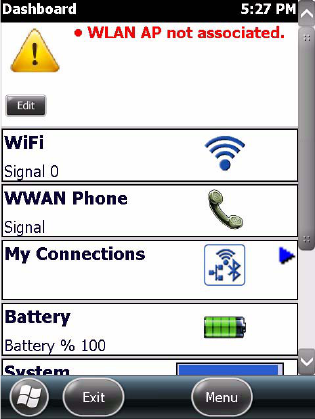
Chapter 8 — Troubleshooting and Maintaining the Computer
102 70 Series Mobile Computer User’s Manual
About the Intermec Dashboard
The Intermec Dashboard is designed to provide proactive monitoring
of your mobile computers to prevent downtime. You can easily see the
health of the device and can help pinpoint the source of a problem to
determine if its hardware or software related.
Intermec Dashboard displays information such as the status of
network connections, battery usage, storage space, and internal
devices. It also provides system information such as the operating
system, firmware, and hardware configuration.
To launch the Intermec Dashboard:
•Press the Intermec Dashboard button (m).
Intermec Dashboard Main Screen
Intermec Dashboard is highly integrated with SmartSystems
Foundation. You can use SmartSystems Foundation to remotely
monitor the health of your computers. For more information, refer to
the SmartSystems online help.

Chapter 8 — Troubleshooting and Maintaining the Computer
70 Series Mobile Computer User’s Manual 103
Troubleshooting Your Mobile Computer
Use the troubleshooting tables in this section to fix problems with the
Bluetooth connection, Wi-Fi connection, the phone, the imager, the
camera, or general problems with operating the mobile computer.
If you send the computer in for service, it is your responsibility to save
the computer data and configuration. Intermec is responsible only for
ensuring that the hardware matches the original configuration when
repairing or replacing the computer.
Troubleshooting the Wi-Fi Connection
Use this troubleshooting table to help solve problems with your
802.11 radio connection.
Problems With the Wi-Fi Connection
Problem Solution
When you turn on the computer after it
was suspended for a while (10 to 15
minutes or longer), it can no longer send
or receive messages over the network.
Host may have deactivated or lost current terminal
emulation session. In a TCP/IP direct connect network,
turn off the “Keep Alive” message from host to
maintain the TCP session while the computer is
suspended.
The computer is connected to the network
and you move to a new site to collect data.
Your computer now shows you are not
connected to the network.
Move closer to an access point or to a different location
to reestablish communications until you reconnect
with the network. Any data collected while out of range
is transmitted over the network.
The computer appears to be connected to
the network, but you cannot establish a
terminal emulation session with the host
computer.
There may be a problem with the host computer, or
with the connection between the access point and the
host computer. Check with the network administrator
to make sure the host is running and allowing users to
log in to the system.
The computer appears to be connected to
the network, but the host computer is not
receiving any information from the 70
Series computer.
There may be a problem with the connection between
the access point and the host computer. Check with the
network administrator or use your access point user’s
manual.

Chapter 8 — Troubleshooting and Maintaining the Computer
104 70 Series Mobile Computer User’s Manual
Troubleshooting 802.1x Security
Use the following table to troubleshoot problems with your 802.1x
security that will prevent you from connecting to your network, such
as a missing WEP key value or an incorrect password.
A network connection icon appears in the
toolbar, but then disappears.
The computer may not be communicating with the
intended access point. Make sure the network name
matches the access point network name. Default
network name is “INTERMEC.”
The access point may not be communicating with the
server. Ensure the access point is turned on, properly
configured, and has 802.1x security enabled.
Problem Solution
Problem Solution
You are setting up multiple access
points in a network, with
different SSIDs, and the
connection fails.
The computer does not save WEP key
values when changing the SSID. Reenter
the WEP key value after changing the
SSID and save your changes. You should
now be able to connect to the different
access points.

Chapter 8 — Troubleshooting and Maintaining the Computer
70 Series Mobile Computer User’s Manual 105
Checking 802.11 Network Status
If you have trouble connecting to your 802.11 wireless network:
•Make sure you have correctly set network parameters on the
computer.
•Check your wireless security settings.
Follow the next procedure to use Intermec Dashboard to verify
available access points and networks, check signal strength, and view
other diagnostics. If you need to contact Intermec Product Support,
this information can be helpful in troubleshooting wireless network
connection issues.
The computer indicates it is not
authenticated.
Make sure that:
•the User Name and Password
parameters on the computer must
match the user name and password on
authentication server. You may need
to reenter the password on both the
computer and authentication server.
•on your authentication server, the user
and group are allowed and the group
policy is allowed to log into the server.
For help, see the documentation that
shipped with your authentication
server software.
•the IP address and secret key for access
point must match the IP address and
secret key on the authentication server.
You may need to reenter the IP address
and secret key on both your access
point and authentication server.
•the authentication server software is
running on the server PC.
You receive a message saying “The
server certificate has expired or
your system date is incorrect”
after you perform a clean boot on
the computer.
Date and time are not saved when you
perform a clean boot. Reenter the date
and time, and then save your changes.
Problem Solution
Chapter 8 — Troubleshooting and Maintaining the Computer
106 70 Series Mobile Computer User’s Manual
To use the Intermec Dashboard to verify the network status:
1Press the Dashboard (m) button. The Dashboard launches.
2Tap WiFi to view the details of the WiFi status.
3Tap Diagnostics. The ISpyWiFi diagnostics screen appears.
The ISpyWiFi tab shows:
•MAC address and IP address of the 802.11 radio.
•network association status, including the SSID and MAC
address of the access point.
•security configuration.
•radio transmit power and signal strength information.
4Tap the Scan tab to view a list of available 802.11 networks. The list
includes the signal strength, channel, and MAC address for each
network.
•Tap Scan to refresh the screen.
5Tap the Supp tab to view radio supplicant information, including
a list of supplicant events and authentication status.
•To verify the settings for the currently active security profile, tap
Configure Profile. The Profile Wizard for the active profile
appears.
•To try reconnecting to the network, tap Reconnect.
•To delete the events in the list, tap Clear Events.
6Tap the Ping tab to run a ping test to the host.
To run a ping test:
aIn the Host field, enter the IP address of the host.
bFrom the Repetitions list, choose the number of times the
computer will ping the host.
cTap Ping. The graph shows the amount of time it takes for the
host to return the ping. Tap List to see this information in a list
format.

Chapter 8 — Troubleshooting and Maintaining the Computer
70 Series Mobile Computer User’s Manual 107
7Tap the RSSI tab to view the received signal strength of the host
signal.
The information box includes the current signal strength, host
SSID name, MAC address, data rate, and transmit power.
•Tap Mark to place an arrow marker above the graph.
8Tap the Conf tab to set up a log file that lists RSSI history.
This screen includes the 802.11 radio driver version and available
radio modes.
To create a log file:
aCheck the Log to File check box.
b(Optional) Change the sample period and number of samples
displayed.
cTap Log File. The Save As screen appears.
d(Optional) Change the name of the saved log file, the folder to
which the file will be saved, the content type (log or text), and
the location.
eTap Save.
Troubleshooting Reading Bar Codes
Use this section to troubleshoot problems that may prevent you from
being able to read a bar code such as the symbology not be enabled.
Problem Solution
You cannot see a red beam of light
from the imager when you press
the Scan button and aim the
imager at a bar code label.
•You may be too far away from the bar
code label. Try moving closer to the bar
code label and scan it again.
•You may be reading the bar code label
“straight on.” Change the reading
angle and try again.
•The imager hardware trigger might be
disabled in Intermec Settings. To
check the setting go to Start >
Settings > Systems > Data
Collection > Scanner Settings.
Hardware trigger should be checked.

Chapter 8 — Troubleshooting and Maintaining the Computer
108 70 Series Mobile Computer User’s Manual
When you release a Scan button
or handle trigger, the Good Read
light does not turn off.
The Good Read light will remain on if
you configure the computer to use
continuous/edge triggering. If you
configure the computer for level
triggering and the Good Read light
remains on, there may be a problem. Press
one of the Scan buttons or pull the
trigger again without scanning a bar code
label. If the light is still on, contact your
local Intermec representative.
The scanner will not read the bar
code label.
•Aim the scanner beam to cross entire
bar code label in one pass. Vary the
scanning angle.
•Check the quality of the bar code label,
Scan a bar code label that you know
will scan. Compare the two bar code
labels to see if the bar code quality is
too low. You may need to replace the
label that you cannot scan.
•Make sure the bar code symbology is
enabled and configured correctly. Use
Intermec Settings to check the
symbologies. Expand Data
Collection > Symbologies beneath
devices listed (scanner, virtual wedge)
to check and enable symbologies, then
scan the bar code label again.
•Make sure the computer application is
expecting input from a bar code. You
may need to type this information
instead.
The scanner does not read the bar
code labels quickly, or the
scanning beam seems to be faint
or obscured.
The scanner window may be dirty. Clean
the window with a solution of ammonia
and water. Wipe dry. Do not allow
abrasive material to touch the window.
You scan a valid bar code label to
enter data for your application.
The data decoded by the scan
module does not match the data
encoded in the bar code label.
The computer may have decoded the bar
code label in a symbology other than the
label’s actual symbology. Try scanning
the bar code label again. Make sure you
scan the entire label.
Problem Solution

Chapter 8 — Troubleshooting and Maintaining the Computer
70 Series Mobile Computer User’s Manual 109
Troubleshooting Operating the Computer
Use this section to troubleshoot problems that may prevent you from
being able to operate the computer.
The input device attached to the
computer does not work well or
read bar code labels very quickly.
Set the Scanner Model command to the
specific attached input device. Check
enabled bar code symbologies and enable
only the symbologies being used.
Problem Solution
Problem Solution
You press the Power key and
nothing happens.
The battery status LED indicates the
following states:
•If the battery status LED is a steady
green, the battery is more than 95%
charged and computer is on a charger.
•If the battery status LED is blinking
red, then the battery is low. Replace or
charge the battery.
•If the battery status LED is a steady
red, the main battery is on charge.
•If the battery status LED is amber, the
computer is on charge and either the
battery temperature is outside of the
charging range, or the battery is
defective.
The computer appears to be
locked up and you cannot enter
data.
•Press the Power key to turn off the
computer, then press the Power key
again to turn it on.
•Press and hold the Power key ten
seconds to warm boot the computer.
•Try reloading the firmware. For help,
see “Updating the System
Software” on page 97.
•If the computer does not boot or reset,
contact your Intermec representative
for help.
You tap the screen and nothing
happens.
Align your screen. For help, see
“Aligning the Screen” on page 39.

Chapter 8 — Troubleshooting and Maintaining the Computer
110 70 Series Mobile Computer User’s Manual
Calling Product Support
If you cannot find the answer to your problem in the
“Troubleshooting the Computer” section, you can visit the Intermec
technical knowledge base (Knowledge Central) at
intermec.custhelp.com to review technical information or to request
technical support. If you still need help after visiting Knowledge
Central, you may need to call Product Support.
To talk to an Intermec Product Support representative, call:
1-800-755-5505
Before you can call Intermec Product Support, make sure you have the
following information ready:
•Configuration number
•Serial number
•Operating system version
•SmartSystems Platform Bundle (SSPB) version
•If you are using security, know the type (Funk or Microsoft) and the
full set of parameters
•Power management settings
•If you are using terminal emulation (TE), know the version and
protocol. If you are not using TE, know the language your custom
application was written in and the tools you used to create it.
You can find most of the information listed above in Intermec
Settings. Consult your application developer for information on your
custom application.
You cannot type a character on
the keypad or you can only type
uppercase or lowercase letters.
You may have locked a modifier key on
the keypad. Press the necessary key
sequence to unlock the key. For help, see
“About the Keypad” on page 14.
Problem Solution
Chapter 8 — Troubleshooting and Maintaining the Computer
70 Series Mobile Computer User’s Manual 111
Finding Your Configuration Number
Use the following procedure to help you find the configuration
number of your computer.
•Look at the label on the back of the computer.
Finding Your Operating System Version
Use the following procedure to help you find your mobile computer’s
OS version.
1Press the Intermec Dashboard (m) button to launch the
Dashboard.
2Tap the Information bar. The Information Details page appears
and displays information such as the firmware version and the OS
version.
Resetting the Computer
You rarely need to reset the computer. If the computer does not
resume after pressing the Power button, or if the computer or an
application locks up, you may need to reset the computer. The 70
Series computer uses the configuration currently saved in flash
memory during the boot process. There are three ways to reset the
computer:
•Reboot
•Cold boot
•Clean boot
Rebooting the Computer
You may need to reboot the computer to correct conditions where an
application stops responding to the system.
To reboot the computer:
•Press the Power button and select Reboot from the menu.
The computer systematically shuts down, restarts, and goes
through the initialization process.
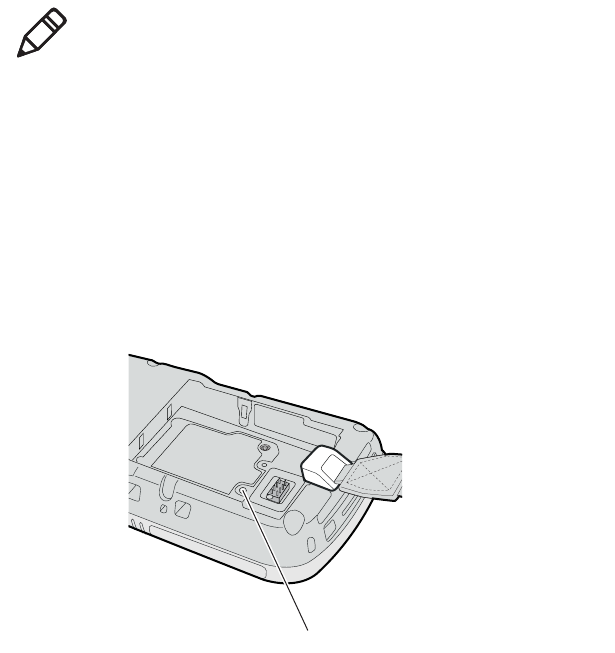
Chapter 8 — Troubleshooting and Maintaining the Computer
112 70 Series Mobile Computer User’s Manual
Cold Booting the Computer
In some cases where the computer completely stops responding, it may
be necessary to perform a cold boot or hard reset. Because cold booting
may result in data loss, use this method only if all other recovery
methods have failed.
To cold boot your 70 Series computer:
1Press the Power button to suspend the computer.
2Remove the handstrap and the battery pack.
3Press the Reset button in the battery compartment on the back of
the computer.
4Replace the battery and the handstrap. The mobile computer
boots. When the cold boot is complete, the Home screen appears.
Note: Cold booting the computer does not guarantee that cached disk
data will be saved, so transactional data may be lost during the reset.
All other data, such as configuration and network settings, is
preserved.
Reset button

Chapter 8 — Troubleshooting and Maintaining the Computer
70 Series Mobile Computer User’s Manual 113
Clean Booting the Computer
If the computer seems to be locked up, try cold booting it. If this
process does not work, use a clean boot to get the computer up and
running for further troubleshooting. You can clean boot using the
mobile computer, or you can clean boot using the SmartSystems
Console:
•To clean boot the computer using the mobile computer:
1Remove the battery pack from the back of the computer.
2With a stylus, press the Reset button in the battery cavity.
3Insert the battery back into the computer, and immediately
press and hold the Power button and Volume Down button
(the lower button on the right side).
4Continue to hold the Power button and the Volume Down
button down until you are prompted to release them.
5Press the Volume Up button on the right side to start the cold
boot.
6Wait for the computer to load files from its ROM.
•To clean boot the computer using the SmartSystems Console, right
click on the 70 Series computer and select Intermec Power Tools
> Clean Boot Device.
A clean boot erases the memory in the mobile computer,
including all applications and data files found in the ObjectStore,
and loads only the default files and programs required by the
computer operating system.
During a clean boot, the computer first looks for the Image
Update files on an installed microSD card. If no card is found, the
computer loads the files in the Flash File Store. Files found on a
microSD card during a clean boot are copied into the Flash File
Store and overwrite the existing files.

Chapter 8 — Troubleshooting and Maintaining the Computer
114 70 Series Mobile Computer User’s Manual
Cleaning the Computer
To keep the computer in good working order, you may need to clean
the imager window, color camera window, and the touch screen. Clean
the windows and the touch screen as often as needed for the
environment in which you are using the computer. To clean the
computer, use a solution of ammonia and water.
To clean the image window, camera window, and touch screen:
1Press the Power button and choose to suspend the computer.
2Dip a clean cloth towel in the ammonia solution and wring out the
excess.
3Wipe off the imager window, camera lens, and flash area. Do not
allow any abrasive material to touch these surfaces.
4Wipe dry.
There are no user-serviceable parts inside the 70 Series computer.
Opening the computer will void the warranty and may cause
damage to the internal components.

115
A
Specifications and Default Settings

Appendix A — Specifications and Default Settings
116 70 Series Mobile Computer User’s Manual
Physical and Environmental Specifications
CN70 Physical Dimensions
CN70e Physical Dimensions
CK70 Physical Dimensions
CK71 Physical Dimensions
Environmental Specifications
Dimensions 16.9 x 8.0 x 3.4 cm (6.66 x 3.14 x 1.35 in)
Weight 450 g (15.2 oz) with battery
Dimensions 19.5 x 8.0 x 3.4 cm (7.66 x 3.14 x 1.35 in)
Weight 491 g (16.6 oz) with battery
Dimensions 23.7 x 8.0 x 4.3 cm (9.33 x 3.16 x 1.69 in)
Weight 562 g (19 oz) with battery
Dimensions 23.7 x 8.0 x 5.0 cm (9.33 x 3.16 x 1.98 in)
Weight 584 g (19.75 oz) with battery
Operating temperature -20°C to 60°C (-4°F to 140°F)
Storage temperature -20°C to 60°C (-4°F to 140°F)
Charging temperature 0°C to 45°C (32°F to 113°F)
Relative humidity (operating) 5% to 95% non-condensing
Environmental rating IP64 compliant
Drop Specifications All corners and sides from 1.8 m (6 ft) per
MIL-STD 810F

Appendix A — Specifications and Default Settings
70 Series Mobile Computer User’s Manual 117
Power and Electrical Specifications
Operating System
Microsoft Windows Mobile 6.5.3
Hardware
Back Accessory Interface Pin-outs
The back accessory interface provides power for peripheral devices out
the back of the CK70 and CK71 computers.
Battery type Rechargeable Lithium-ion (Li-ion) battery
Battery capacity 3.7V, 4000 mAh (14.8 Wh)
Electrial rating x 54.3/4.8 V; 2/1,5 A
Main processor ARMV41, 600 MHz
Radio processor ????? MHz
Memory 256 MB RAM
Persistent storage 1 GB Flash
Removable storage up to 32 GB user-accessible microSD card slot
Keypad CN70, CN70e: QWERTY, Numeric
CK70: Alpha or Alphanumeric
CK71: Numeric Function or Alphanumeric
Imaging options 5 megapixel color camera and EA30 area imager
(all), EV12 (CK71 only), or EX25 (CK71 only)
Pin Pin Name I/O Description
1 OTB_PWR Output Power supply for peripheral
2GND
3 OTB_RX Input DTE Data Receive
4 OTB_TX Output DTE Data Transmit
5 OTB_I/O_Voltage Input I/O Voltage Level
6 OTB_ID BiDir One Wire Bus for ID
7 OTB_RTS Output DTE Ready do Send
8 OTB_CTS Input DTE Clear to Send

Appendix A — Specifications and Default Settings
118 70 Series Mobile Computer User’s Manual
Touch Screen Specifications
Trans-reflective TFT-LCD display; QVGA color with touch panel; 240
x 320 pixels; 8.9 cm (3.5 in) diagonal active area; 5-level LED backlight
control with settings.
Standard Communications
•UMTS
•CDMA
•GPS
•802.11b/g
•Bluetooth
•USB high speed 2.0 OTG©
Wireless LAN
Regulatory Approvals
cULus Listed, DEMKO, NOM, BSMI, Class B – FCC/ICES/EN ,
GOST-R
Standards compliant IEEE 802.11b/g (2.4 GHz)
Data rates up to 54 Mbps
Security 802.11i, WPA, 802.1x, WEP
(EAP-TLS, TTLS, LEAP, PEAP, EAP-FAST
Certifications WPA2, WPA, Wi-Fi, Cisco Compatible Extensions
(CCX)

Appendix A — Specifications and Default Settings
70 Series Mobile Computer User’s Manual 119
Bar Code Symbologies
The imagers support all of the bar code symbologies listed in the next table.
Symbology
* These symbologies are not supported with the EV12 imager in the
CK70 or CK71.
Imager Reading Distances
Typical reading distances are done in an office environment using
office lights (4 lux). Minimum distances are measured in the dark (0
lux). Both reading distances are provided in respective scan engine
integration guides. Contact your local Intermec representative for
more information.
AustraliaPost* GS1 DataBar Omni-Directional
Aztec* Infomail
BPO* Interleaved 2 of 5
Canada Post Japan Post*
China Post KoreanPost
Codabar Matrix 2 of 5
Codablock A Maxicode*
Codablock F Micro PDF417*
Code 11 MSI
Code 39 PDF417*
Code 93 Planet*
Code 128/GS1-128 Plessey
DataMatrix* Postnet*
Dutch Post* QR Code*
EAN/UPC Standard 2 of 5
GS1 Composite* SwedenPost
GS1 DataBar Expanded Telepen
GS1 DataBar Limited TLC 39
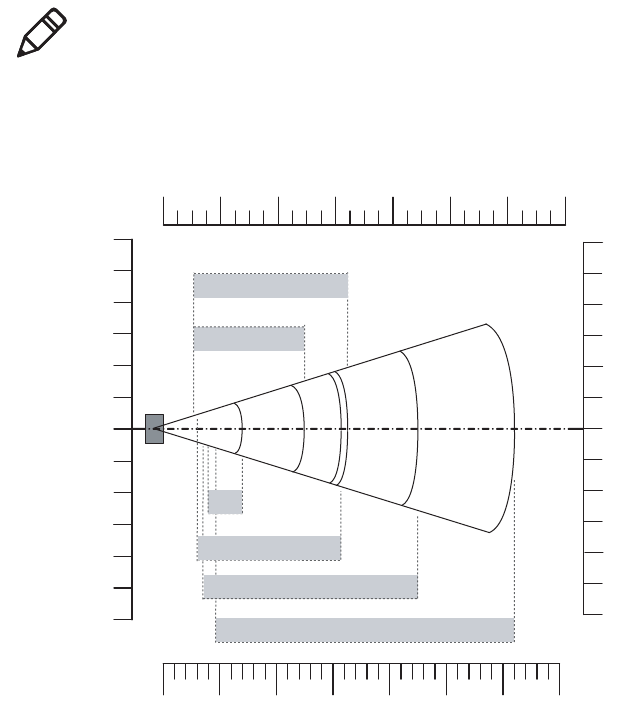
Appendix A — Specifications and Default Settings
120 70 Series Mobile Computer User’s Manual
Below are the typical and minimum standard reading distances for the
70 Series computer built with an EA30 imager. Also included are
typical and minimum standard reading distances for the CK71 with an
EV12 or EX25C imager. When correctly mounted, and exit window
reduces reading distances by about 4% for all scan engines.
EA30 Area Imager Minimum Reading Distances
Minimum distances are measured in the dark (0 lux).
Note: Minimum distances depend on the length of the bar code.
cm
PDF417 10 mils
0.5 mm / 20 mils
1 mm / 40 mils
Data Matrix 10 mils
in
0" 28"24"20"16"12"8"4"
070605040302010
EAN/UPC
0.125mm/5 mils
4"
8"
0"
4"
8"
12"
12"
10
0
10
20
20
30
30
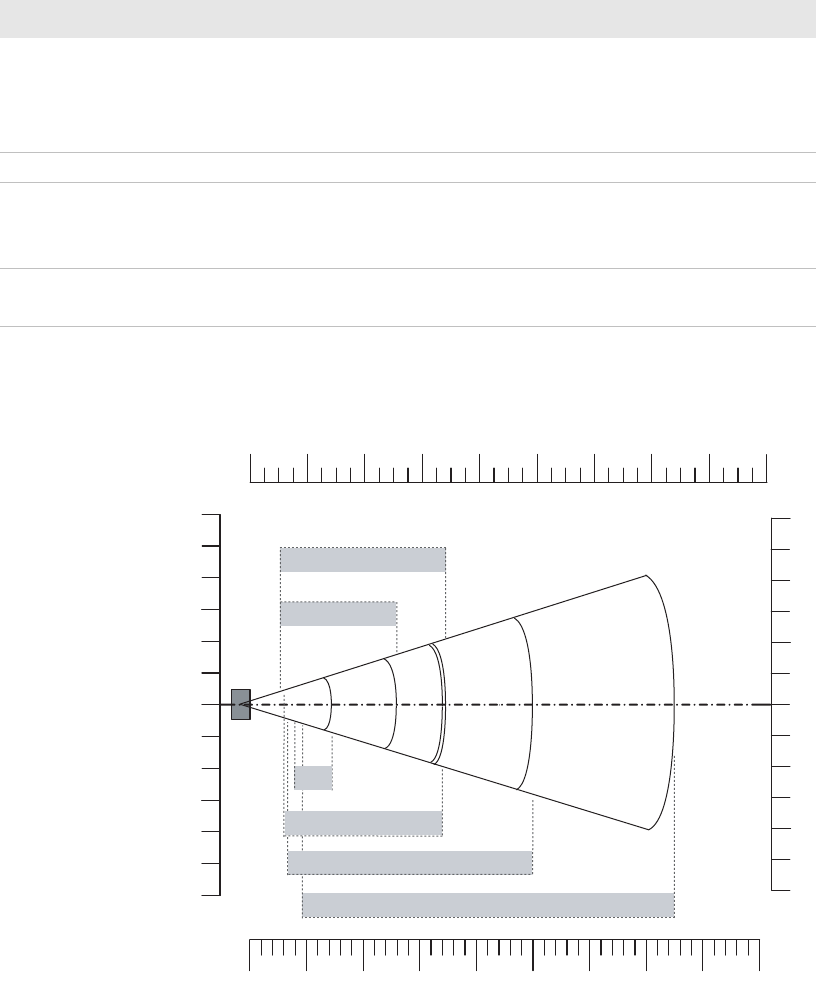
Appendix A — Specifications and Default Settings
70 Series Mobile Computer User’s Manual 121
EA30 Minimum Reading Distances
EA30 Area Imager Typical Reading Distances
Typical distances are measured in an office environment (250 lux).
Symbology Density Minimum Distance Maximum Distance
Code 39 0.1 mm (4 mils)
0.1250 mm (5 mils)
0.5 mm (20 mils)
1 mm (40 mils)
9.5 cm (3.74 in)
8 cm (3.15 in)
7 cm (2.76 in)
9.5 cm (3.74 in)
10.5 cm (4.13 in)
14 cm (5.51 in)
45 cm (17.72 in)
62 cm (24.41 in)
UPC/EAN 100% 0.33 mm (13.0 mils) 6 cm (2.36 in) 31.5 cm (12.4 in)
Data Matrix 0.18 mm (7 mils)
0.25 mm (10 mils)
0.38 mm (15 mils)
8 cm (3.15 in)
6.5 cm (2.56 in)
5.5 cm (2.17 in)
15.5 cm (6.1 in)
21.5 cm (8.46 in)
31.5 cm (12.4 in)
PDF417 0.25 mm (10 mils)
038 mm (15 mils)
5.5 cm (2.17 in)
7 cm (2.76 in)
25 cm (9.84 in)
34 cm (13.39 in)
4"
8"
0"
4"
8"
12"
12"
cm
PDF417 10 mils
0.5 mm / 20 mils
1 mm / 40 mils
Data Matrix 10 mils
in
0" 36"32"28"24"20"16"12"8"4"
0908070605040302010
EAN/UPC
0.125mm/5 mils
10
0
10
20
20
30
30

Appendix A — Specifications and Default Settings
122 70 Series Mobile Computer User’s Manual
EA30 Typical Reading Distances
Symbology Density Minimum Distance Maximum Distance
Code 39 0.1 mm (4 mils)
0.125 mm (5 mils)
0.5 mm (20 mils)
1 mm (40 mils)
9.5 cm (3.74 in)
8 cm (3.15 in)
6.5 cm (2.56 in)
9.5 cm (3.74 in)
11.5 cm (4.53 in)
14.5 cm (5.71 in)
50 cm (19.69 in)
75 cm (29.53 in)
UPC/EAN 100% 0.33 mm (13.0 mils) 6 cm (2.36 in) 34 cm (13.39 in)
Data Matrix 0.18 mm (7 mils)
0.25 mm (10 mils)
0.38 mm (15 mils)
7.5 cm (2.95 in)
6 cm (2.36 in)
5.5 cm (2.17 in)
16.5 cm (6.5 in)
23 cm (9.06 in)
34.5 cm (13.58 in)
PDF417 0.25 mm (10 mils)
0.38 mm (15 mils)
5.5 cm (2.17 in)
6.5 cm (2.56 in)
26 cm (10.24 in)
37 cm (14.57 in)
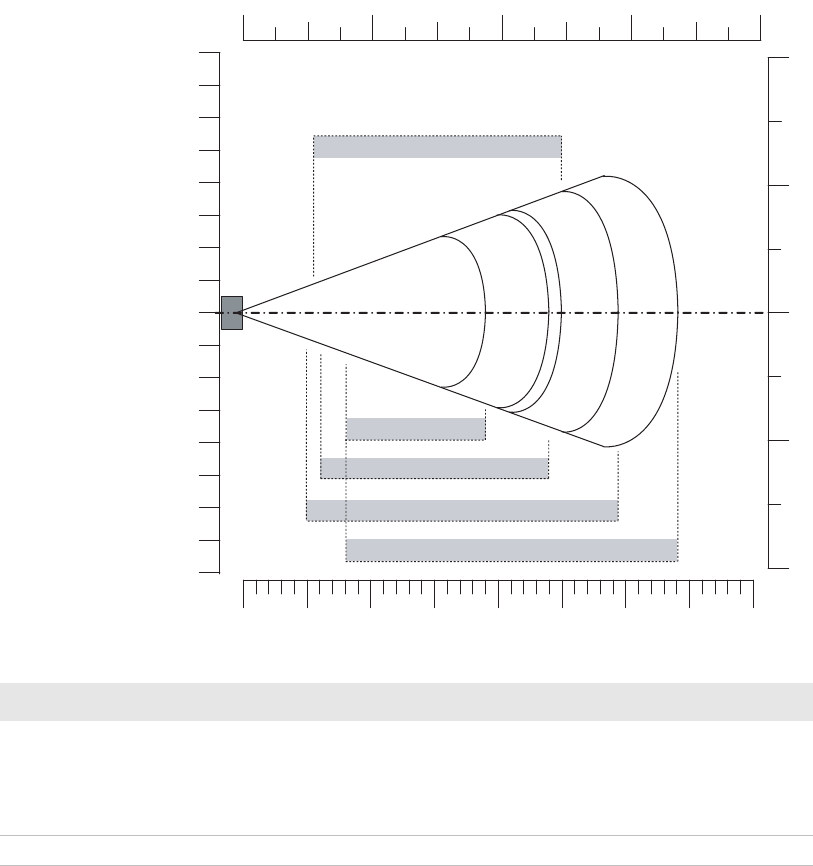
Appendix A — Specifications and Default Settings
70 Series Mobile Computer User’s Manual 123
EV12 Linear Imager Minimum Reading Distances
The illustration below does not include the 0.12 cm (0.05 in) setback
for the CK71. Minimum reading distances are measured in the dark (0
lux).
EV12 Miniumum Reading Distances With 0.12 cm (0.05 in) Setback
0"
2"
8"
in
cm
0
10
20
0" 16" 12" 8" 4"
0 40 30 20 10
0.125 mm / 5 mils
0.25 mm / 10 mils
0.5 mm / 20 mils
1 mm / 40 mils
EAN/UPC 100%
5
15
10
20
5
15
6"
4"
5 15 25 35
2" 6" 10" 14"
1"
3"
5"
7"
2"
8"
6"
4"
1"
3"
5"
7"
Symbology Density Minimum Distance Maximum Distance
Code 39 0.15 mm (6 mils)
0.25 mm (10 ils)
0.5 mm (20 mils)
1 mm (40 mils)
9.6 cm (3.8 in)
7.1 cm (2.9 in)
6.1 cm (2.5 in)
8.1 cm (3.2 in)
17.9 cm (7.1 in)
20.9 cm (8.3 in)
26.9 cm (10.6 in)
33.9 cm (13.4 in)
EAN/UPC 0.33 mm (13 mils) 6.1 cm (2.5 in) 22.9 cm (9.1 in)
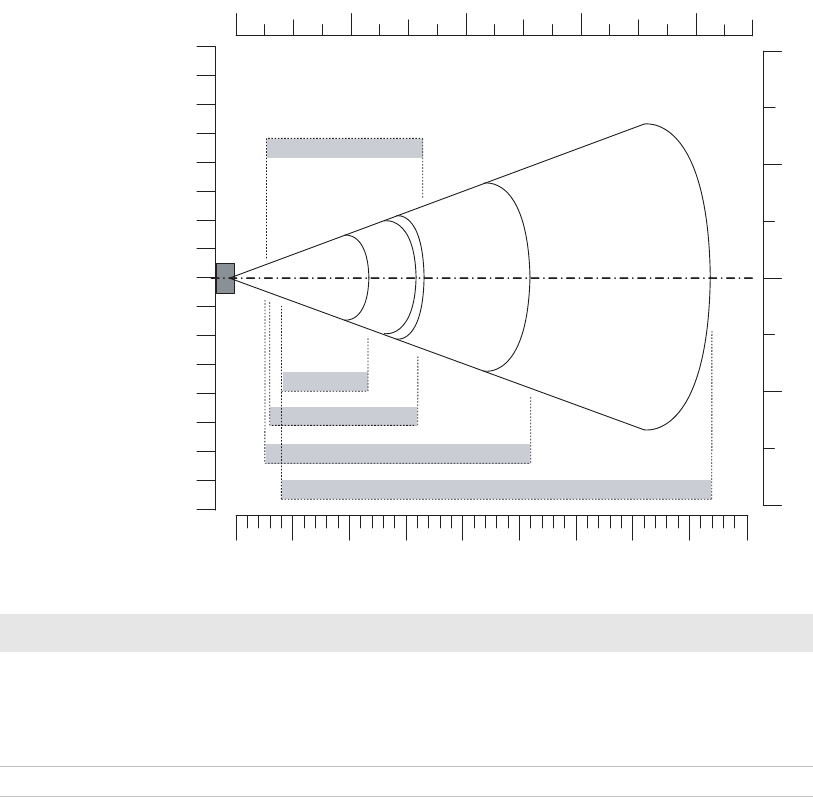
Appendix A — Specifications and Default Settings
124 70 Series Mobile Computer User’s Manual
EV12 LInear Imager Typical Reading Distances
The illustration below does not include the 0.12 cm (0.05 in) setback
for the CK71. Typical reading distances are measured in an office
environment (200 lux).
EV12 Typical Reading Distances With 0.12 cm (0.05 in) Setback
** Minimum distance depends on bar code width and scan angle.
0"
4"
16"
in
cm
0
20
40
0" 32" 24" 16" 8"
0 80 60 40 20
0.125 mm / 5 mils
0.25 mm / 10 mils
0.5 mm / 20 mils
1 mm / 40 mils
EAN/UPC 100%
10
30
20
40
10
30
12"
8"
10 30 50 70
4" 12" 20" 28"
2"
6"
10"
14"
4"
16"
12"
8"
2"
6"
10"
14"
90
36"
Symbology Density Minimum Distance Maximum Distance
Code 39 0.15 mm (6 mils)
0.25 mm (10 ils)
0.5 mm (20 mils)
1 mm (40 mils)
9.6 cm (3.8 in)
6.1 cm (2.5 in)
5.1 cm (2.1 in)
7.1 cm (2.9 in)**
19.9 cm (7.9 in)
24.9 cm (9.8 in)
34.9 cm (13.8 in)
50.9 cm (20.1 in)
EAN/UPC 0.33 mm (13 mils) 5.1 cm (2.1 in) 27.9 cm (11.0 in)
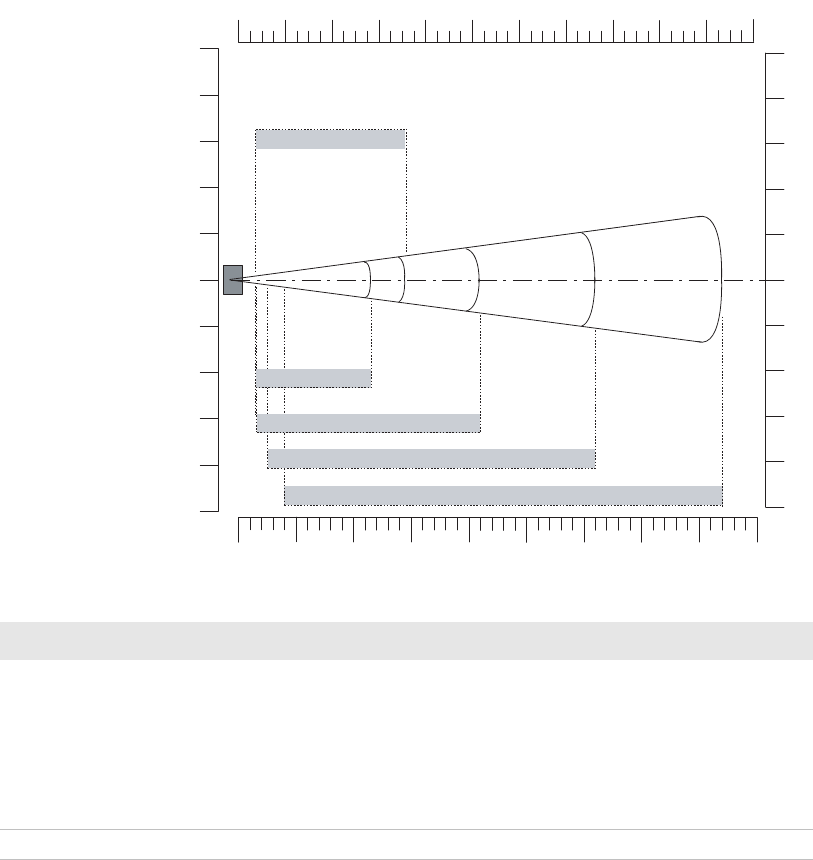
Appendix A — Specifications and Default Settings
70 Series Mobile Computer User’s Manual 125
EX25C Near-Far Range Imager Minimum Reading
Distance
Minimum reading distances are measured in the dark (0 lux). The
following graphic does not include the 0.24 cm (0.09 in) setback for
the CK71.
EX25C Minimum Reading Distances With 0.24 cm (0.09 in) Setback
in
050
cm
0” 32” 64” 80”16”
100% EAN contrast UPC
0.5 mm/20 mils
1 mm/40 mils
100 150 200 250 300 350 400 450
48” 96” 112” 128” 144” 160” 176”
1.4 mm/55 mils
32”
16”
48”
64”
16”
0”
80”
32”
48”
64”
80”
80
40
0
40
80
120
160
160
120
200
200
0.25 mm/10 mils
Symbology Density Minimum Distance Maximum Distance
Code 39 0.08 mm (3 mils)
0.1 mm (2.8 mils)
0.25 mm (10 mils)
0.5 mm (20 mils)
1 mm (40 mils)
1.3 mm (51 mils)
15 cm (5.91 in)
15 cm (5.91 in)
15 cm (5.91 in)
16 cm (6.30 in)
25 cm (9.84 in)
40 cm (15.75 in)
35 cm (13.78 in)
45 cm (17.72 in)
115 cm (45.28 in)
210 cm (82.68 in)
310 cm (122.05 in)
310 cm (122.05 in)
EAN 100% 0.33 mm (13 mils) 15 cm (5.91 in) 145 cm (57.09 in)
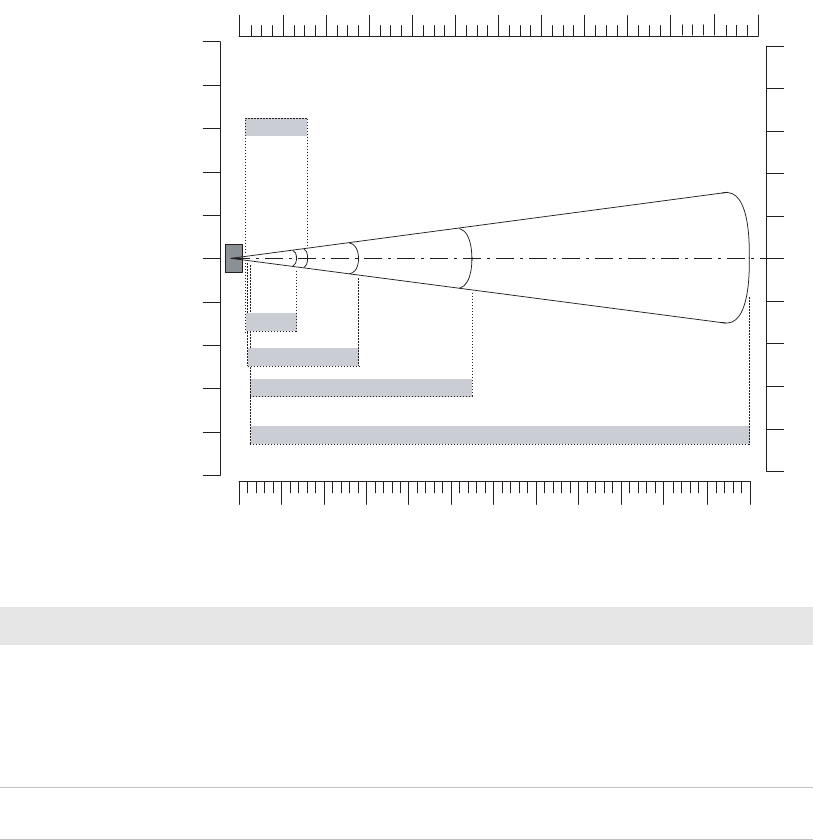
Appendix A — Specifications and Default Settings
126 70 Series Mobile Computer User’s Manual
EX25C Near-Far Range Imager Typical Reading
Distance
Typical reading distances are measured in an office environment (200
lux). The following graphics do not include the 0.24 cm (0.09 in)
setback for the CK71.
EX25C Near-Far Range Imager 1D Typical Reading Distances
EX25C 1D Symbologies Typical Reading Distances With 0.24 cm (0.09
in) Setback
32”
in
0 100
cm
160
80
0
80
160
240
320
320
240
400
400
0” 40” 80”
0.25 mm
10 mils
0.5 mm/20 mils
1 mm/40 mils
200 300 600400 700500 1100
120” 160” 200”
64”
0”
32”
64”
800 900 1000
240” 280” 320” 360” 400” 440”
96”
128”
160”
96”
128”
160”
100% EAN
contrast UPC
480”
1200
2.5 mm/100 mils
Symbology Density Minimum Distance Maximum Distance
Code 39 0.25 mm (10 mils)
0.5 mm (20 mils)
1 mm (40 mils)
1.4 mm (55 mils)
2.5 mm (100 mils)
15 cm (5.91 in)
16 cm (6.30 in)
25 cm (9.84 in)
40 cm (15.75 in)
**
135 cm (53.15 in)
280 cm (110.24 in)
550 cm (216.54 in)
720 cm (283.46 in)
1200 cm (472.44 in)
Code 128
retro-reflective
2.5 mm (100 mils) ** 1300 cm (511.81 in)
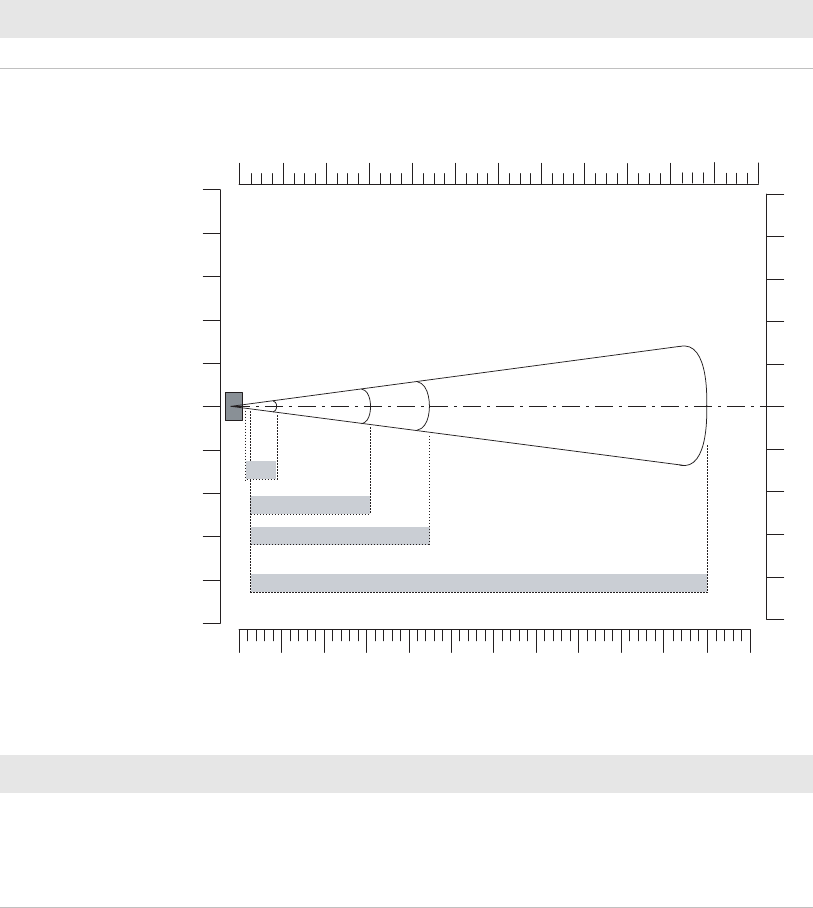
Appendix A — Specifications and Default Settings
70 Series Mobile Computer User’s Manual 127
** Minimum distance depends on bar code width and scan angle.
EX25C Near-Far Range Imager 2D Typical Reading Distances
EX25C 2D Symbologies Typical Reading Distances With 0.24 cm (0.09
in) Setback
** Minimum distance depends on bar code width and scan angle.
EAN 100% 0.33 mm (13 mils) 15 cm (5.91 in) 160 cm (62.99 in)
Symbology Density Minimum Distance Maximum Distance
32”
in
0 100
cm
160
80
0
80
160
240
320
320
240
400
400
0” 40” 80”
0.25 mm
10 mils
0.76 mm/30 mils
1.4 mm/55 mils
200 300 600400 700500 1100
120” 160” 200”
64”
0”
32”
64”
800 900 1000
240” 280” 320” 360” 400” 440”
96”
128”
160”
96”
128”
160”
480”
1200
2.5 mm/100 mils
Symbology Density Minimum Distance Maximum Distance
DataMatrix 0.25 mm (10 mils)
0.76 mm (30 mils)
1.4 mm (55 mils)
2.5 mm (100 mils)
15 cm (5.91 in)
25 cm (9.84 in)
**
**
90 cm (35.43 in)
310 cm (122.05 in)
450 cm (177.17 in)
1100 cm (433.07 in)

Appendix A — Specifications and Default Settings
128 70 Series Mobile Computer User’s Manual
Default Configuration
The following tables list the default values of the configuration
commands supported on the computer. If you restore to factory
default settings, the mobile computer uses these values.
The commands are grouped by function and reflect the organization
of Intermec Settings. You can configure your computer with Intermec
Settings from the SmartSystems Foundation console. For detailed
information on most of the commands, see the Intermec Settings
Command Reference Manual.
Data Collection
Symbology Settings
Symbology Default Value
AustraliaPost Disable
Aztec Disable
BPO Disable
CanadaPost Disable
ChinaPost Disable
Codabar Disable
Codablock A Disable
Codablock F Disable
Code 11 Disable
Code 39 Enable
Code 93 Disable
Code 128/GS1-128 Enable
DataMatrix Enable
DutchPost Disable
EAN/UPC Enable UPC A, UPC E, EAN 8, EAN 13
GS1 Composite Disable
GS1 DataBar Expanded Disable
GS1 DataBar Limited Disable
GS1 DataBar Omnidirectional Disable
Infomail Disable

Appendix A — Specifications and Default Settings
70 Series Mobile Computer User’s Manual 129
Symbology Option Settings
Imager Settings
Interleaved 2 of 5 Disable
JapanPost Disable
KoreanPost Disable
Matrix 2 of 5 Disable
Maxicode Disable
Micro PDF417 Disable
MSI Disable
PDF417 Enable
Planet Disable
Plessey Disable
Postnet Disable
QR Code Disable
Standard 2 of 5 Disable
SwedenPost Disable
Telepen Disable
TLC 39 Disable
Symbology Default Value
Symbology Option Default Value
Preamble None (disabled)
Postamble None (disabled)
Global Symbology ID Disable
Multicode Disable
Imager Setting Default Value
Predefined Modes 1D and 2D Standard
Signature Image Capture Disable
Document Imaging Disable

Appendix A — Specifications and Default Settings
130 70 Series Mobile Computer User’s Manual
Decode Security Settings
Communications
Communication Settings
Bluetooth Settings
802.11 Radio Settings
Ethernet Adapter Settings
Decode Security Setting Default Value
Consecutive Data Validation 0
Identical Consecutive Timeout 300 ms
Different Consecutive Timeout 0
Center Decoding Disable
Center Decoding Tolerance 0
Communication Settings Default Value
Device Name CN50xxxxxxxxxxx
Bluetooth Settings Default Value
Bluetooth Power Off
Bluetooth Discoverable Disable
Bluetooth Connectable Disable
802.11 Radio Settings Default Value
Allow Security Changes Enable
Radio Measurement 0
Radio Enabled Enable
IP Settings Default Value
DHCP Enable

Appendix A — Specifications and Default Settings
70 Series Mobile Computer User’s Manual 131
Certificates Settings
Ethernet Adapter IP Settings
Device Settings
DHCP Client Identifier Null
Primary DNS 0.0.0.0
Secondary DNS 0.0.0.0
Primary WINS 0.0.0.0
Secondary WINS 0.0.0.0
Certificates Settings Default Value
Import Root Certificates False
Import User Certificates False
Import Pac Files False
Ethernet Adapter IP Settings Default Value
DHCP Enable
DHCP Client Identifier Null
Primary DNS Null
Secondary DNS Null
Primary WINS Null
Secondary WINS Null
IP Settings Default Value
Device Settings Default Value
Date Null
Time Null
Adjust for Daylight Time Disable
Good Read Beep One Beep
Beeper Volume Medium
Appendix A — Specifications and Default Settings
132 70 Series Mobile Computer User’s Manual

Worldwide Headquarters
6001 36th Avenue West
Everett, Washington 98203
U.S.A.
tel 425.348.2600
fax 425.355.9551
www.intermec.com
© 2010 Intermec Technologies
Corporation. All rights reserved.
70 Series Mobile Computer User’s Manual
*935-038-001*
P/N 935-038-001